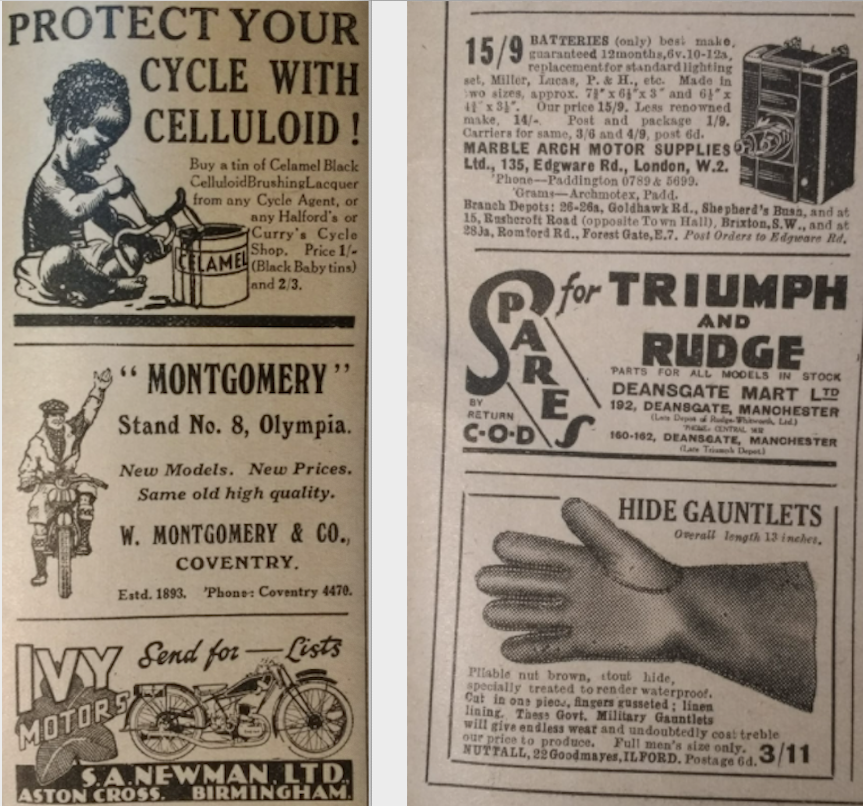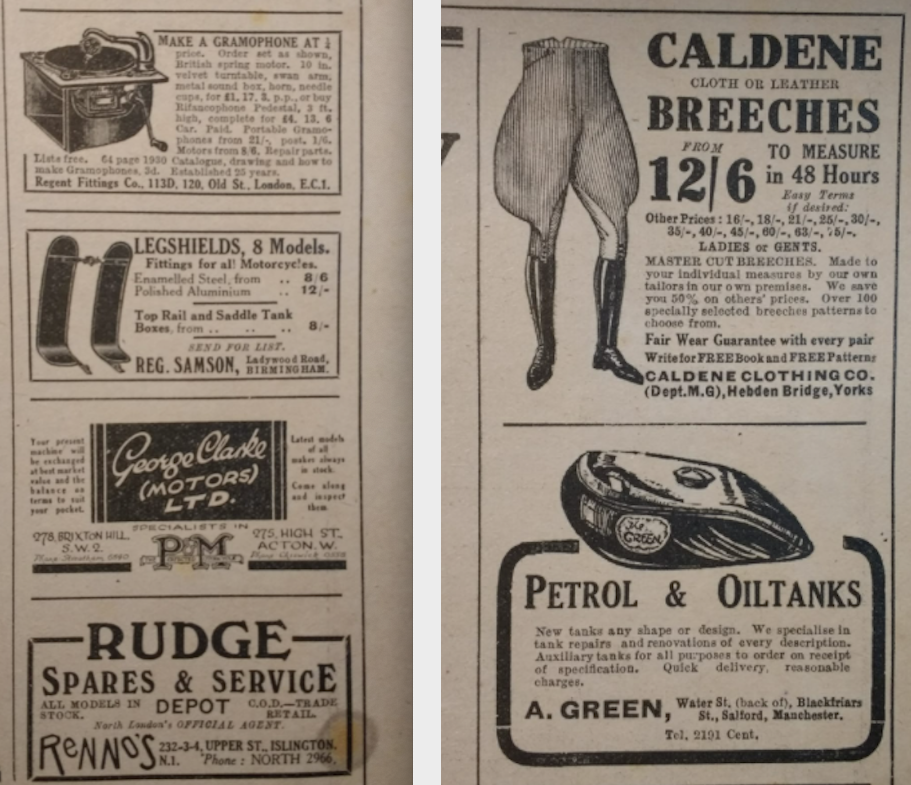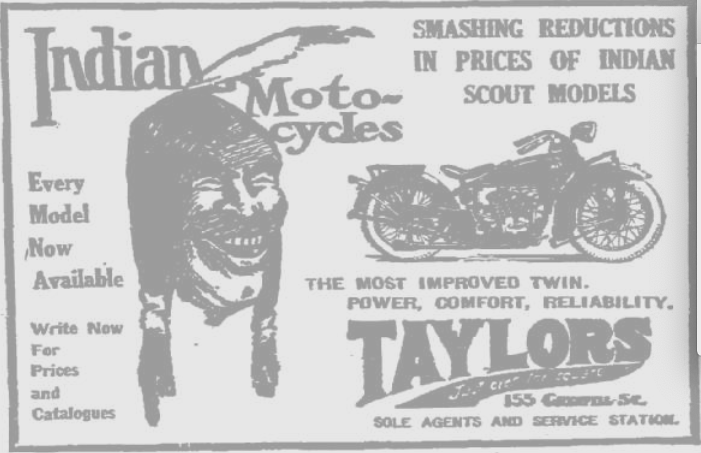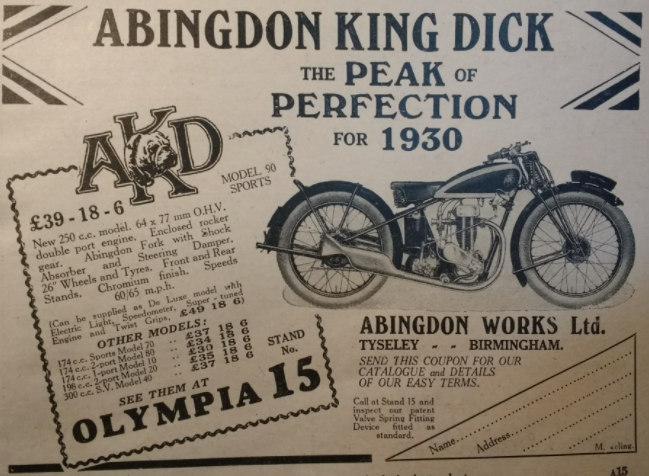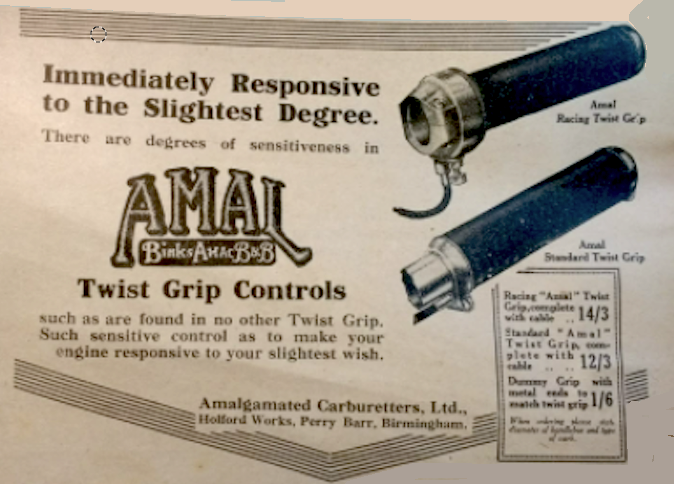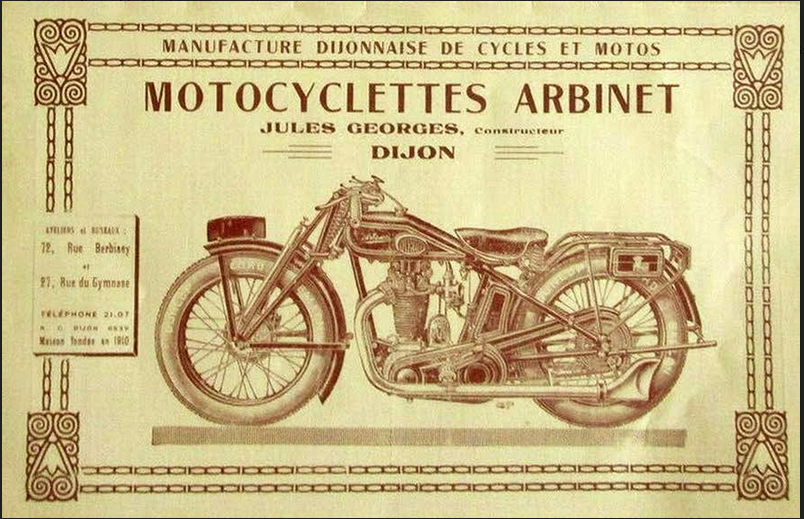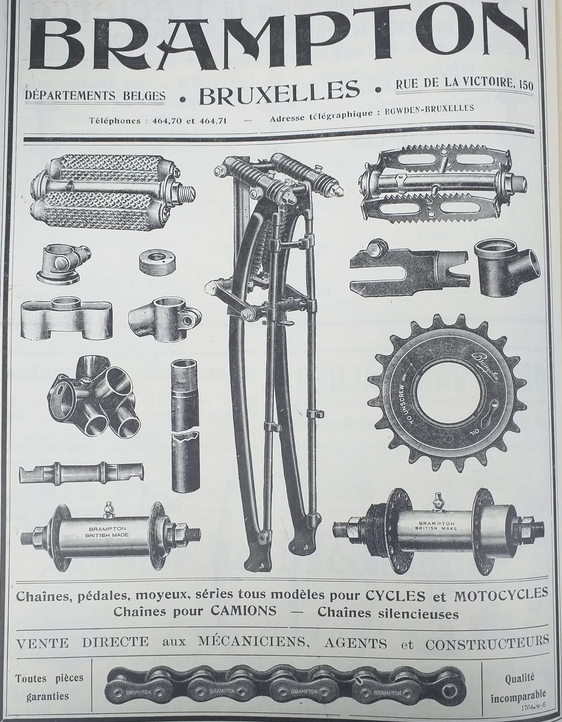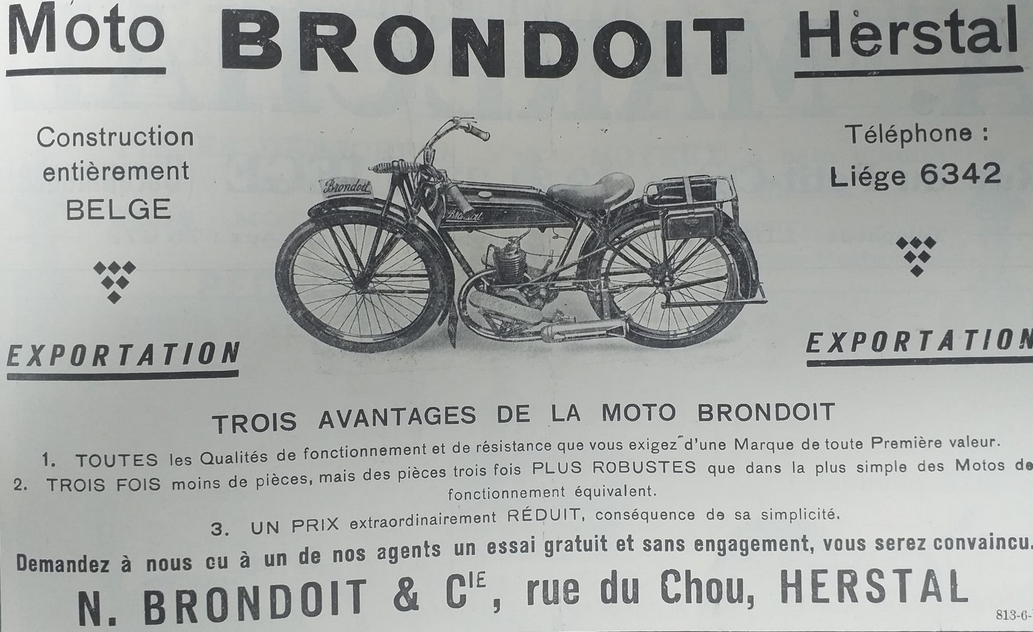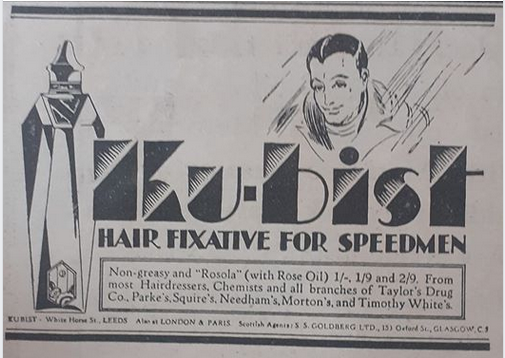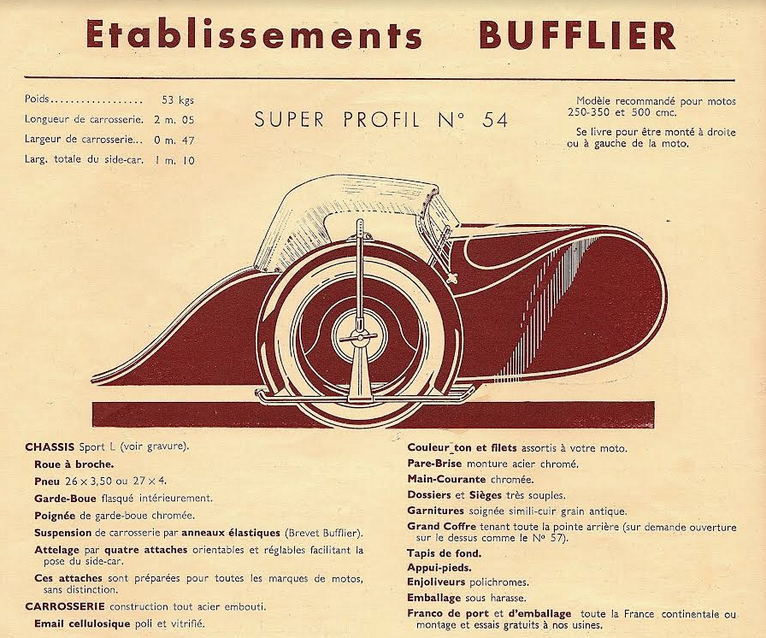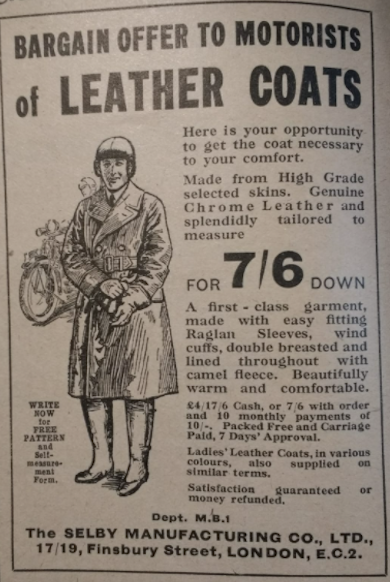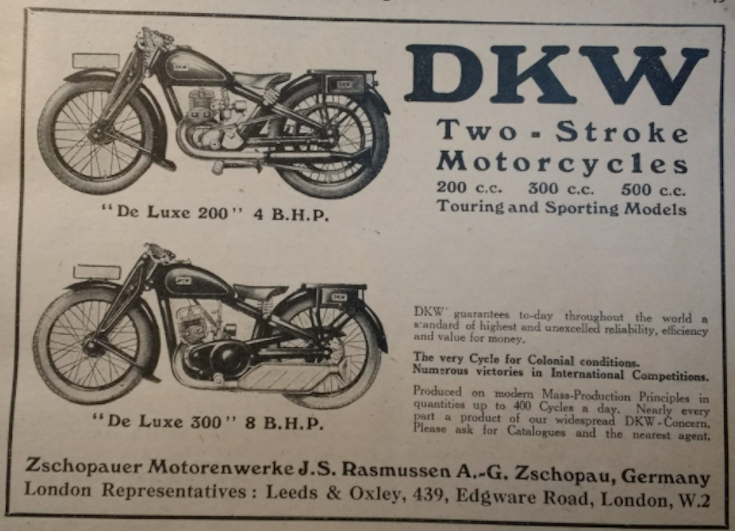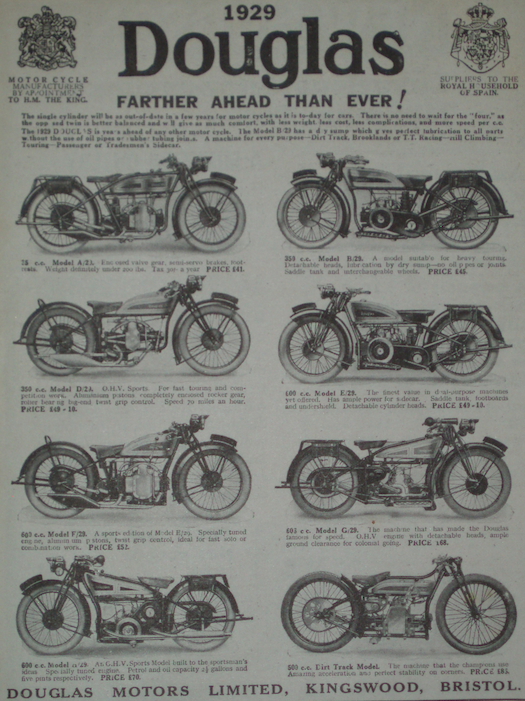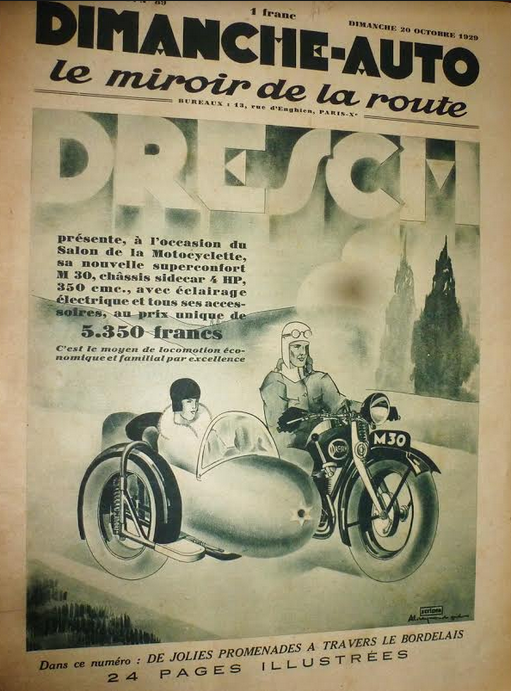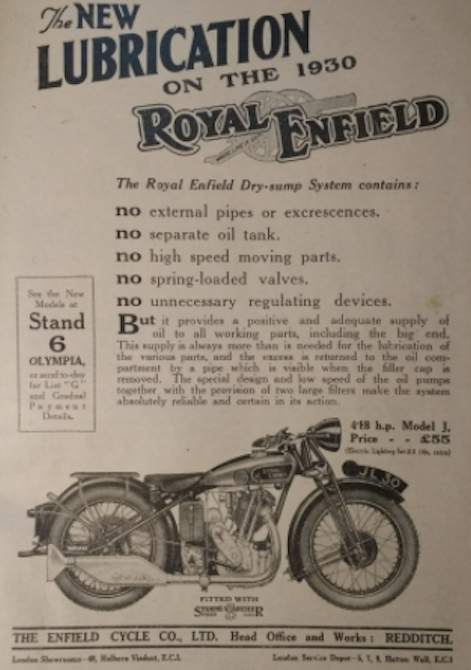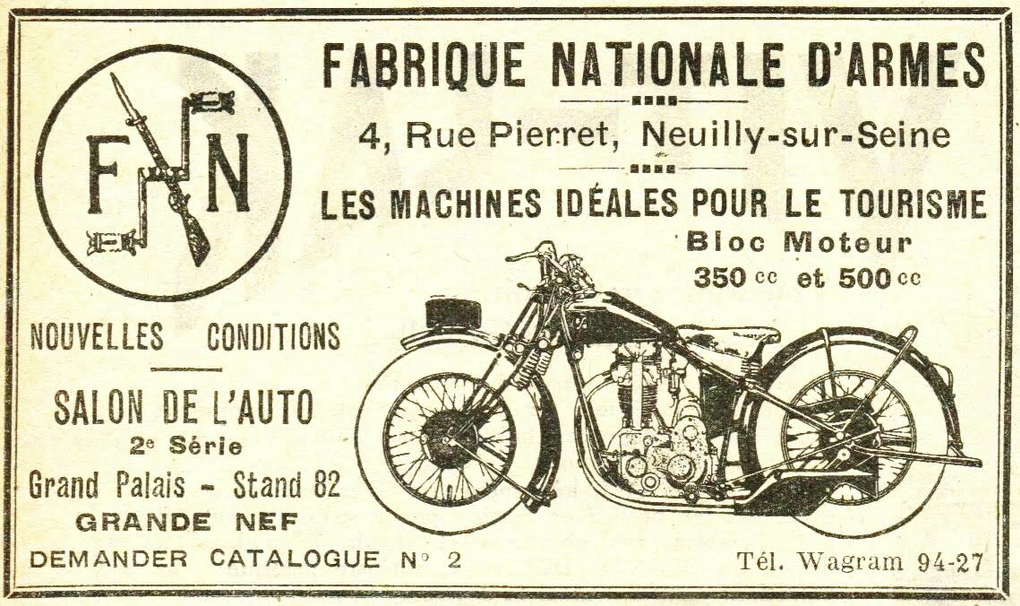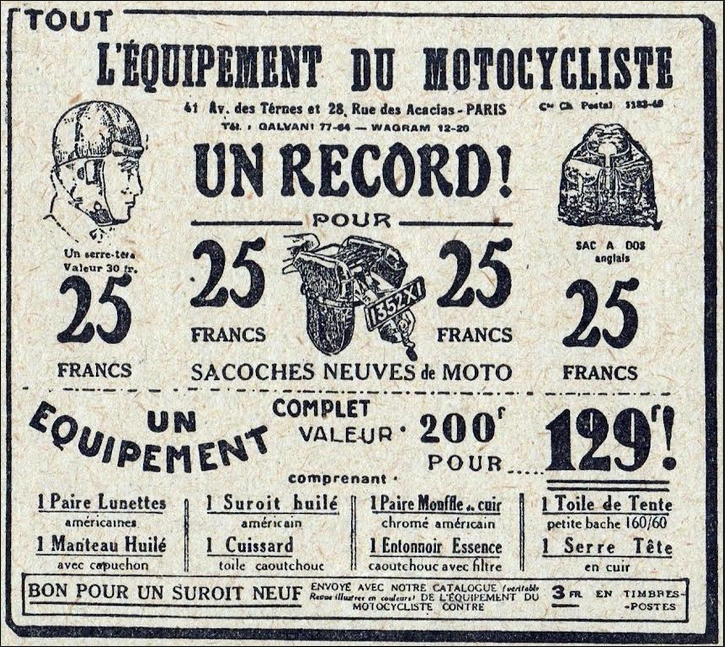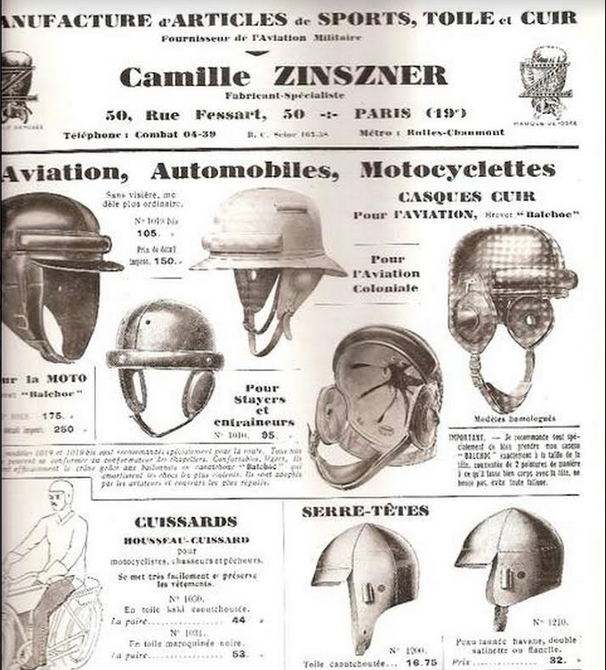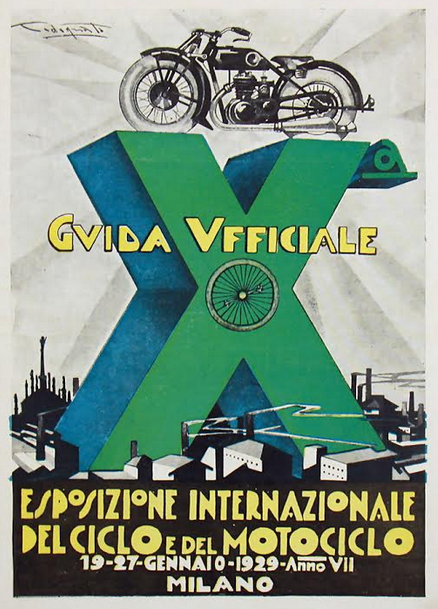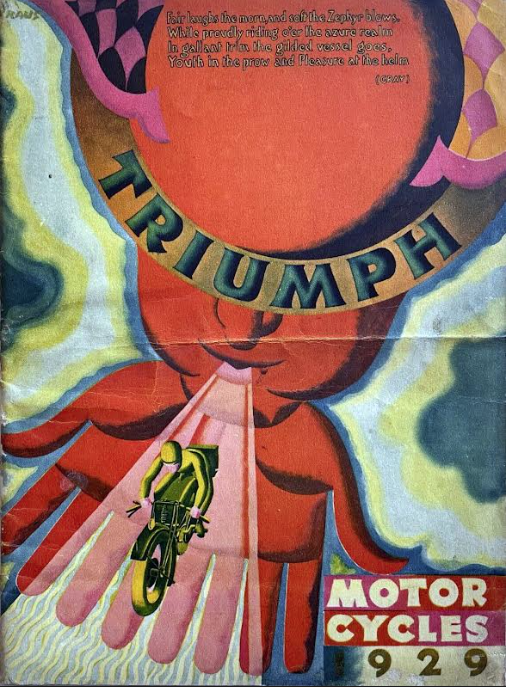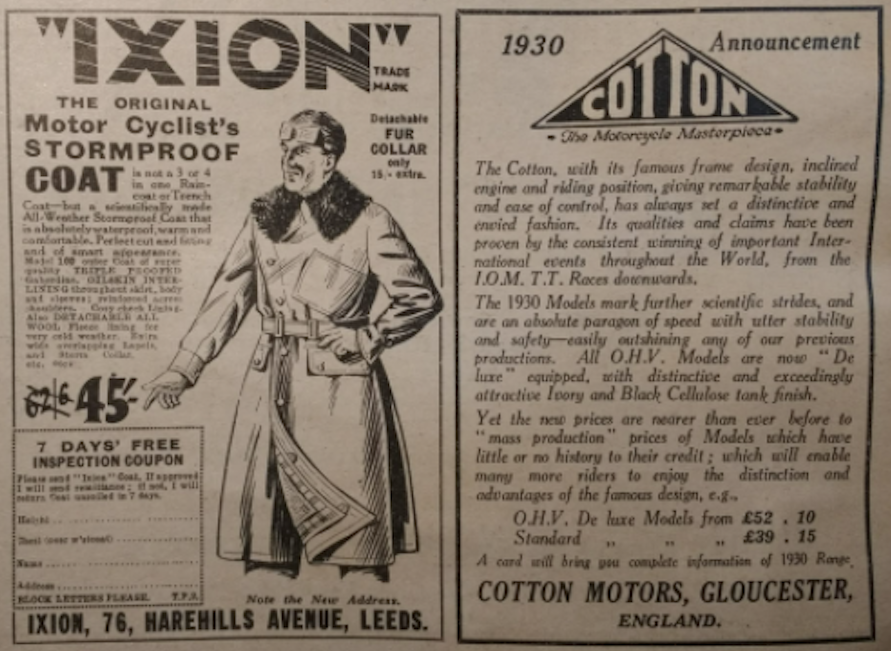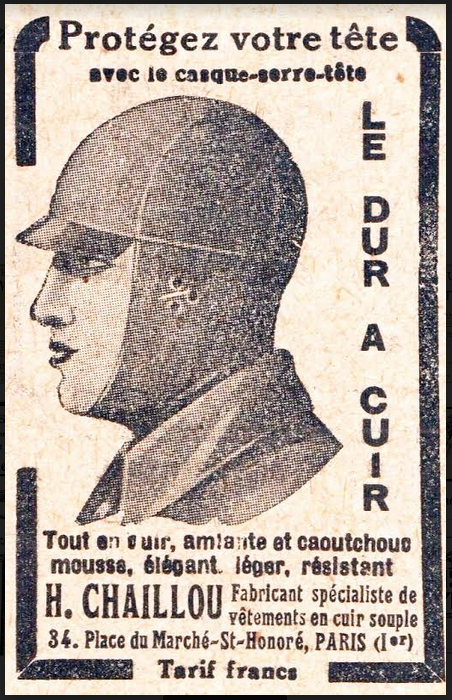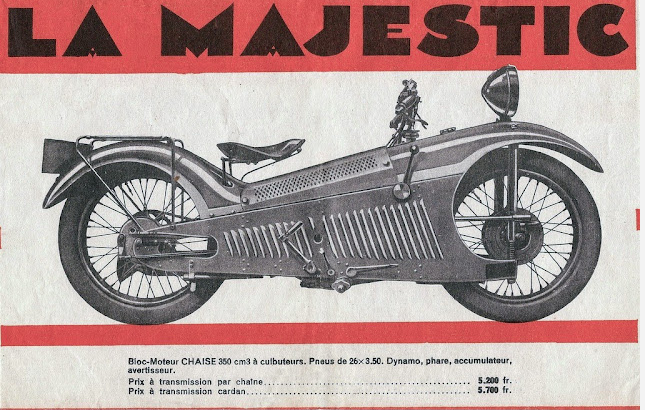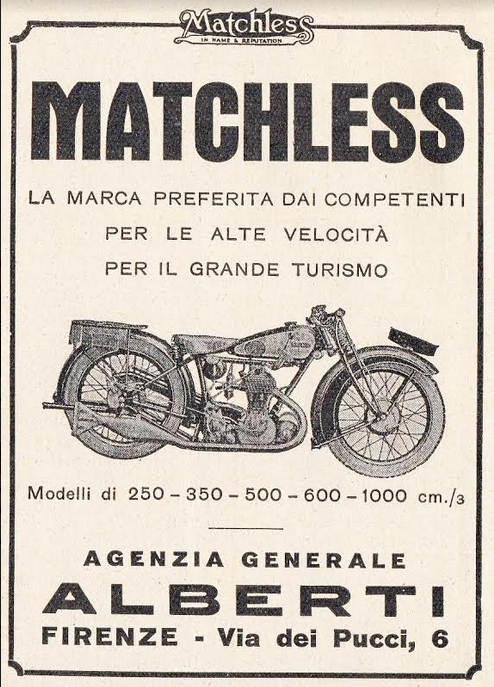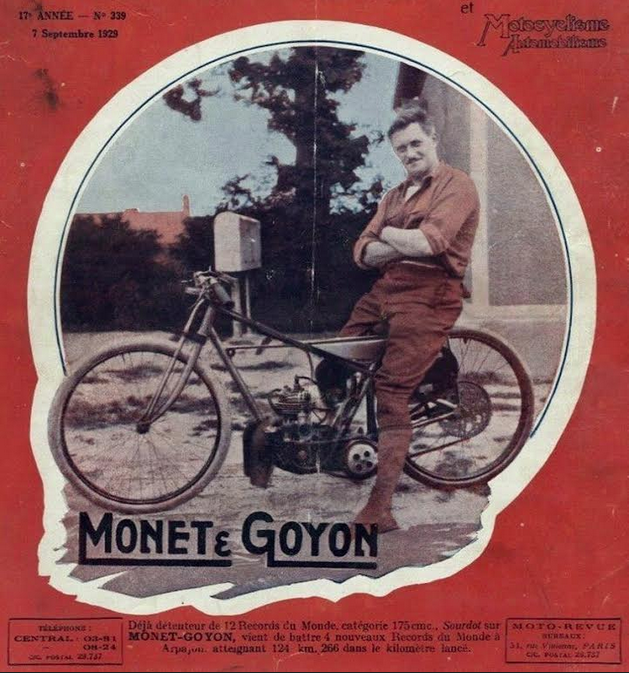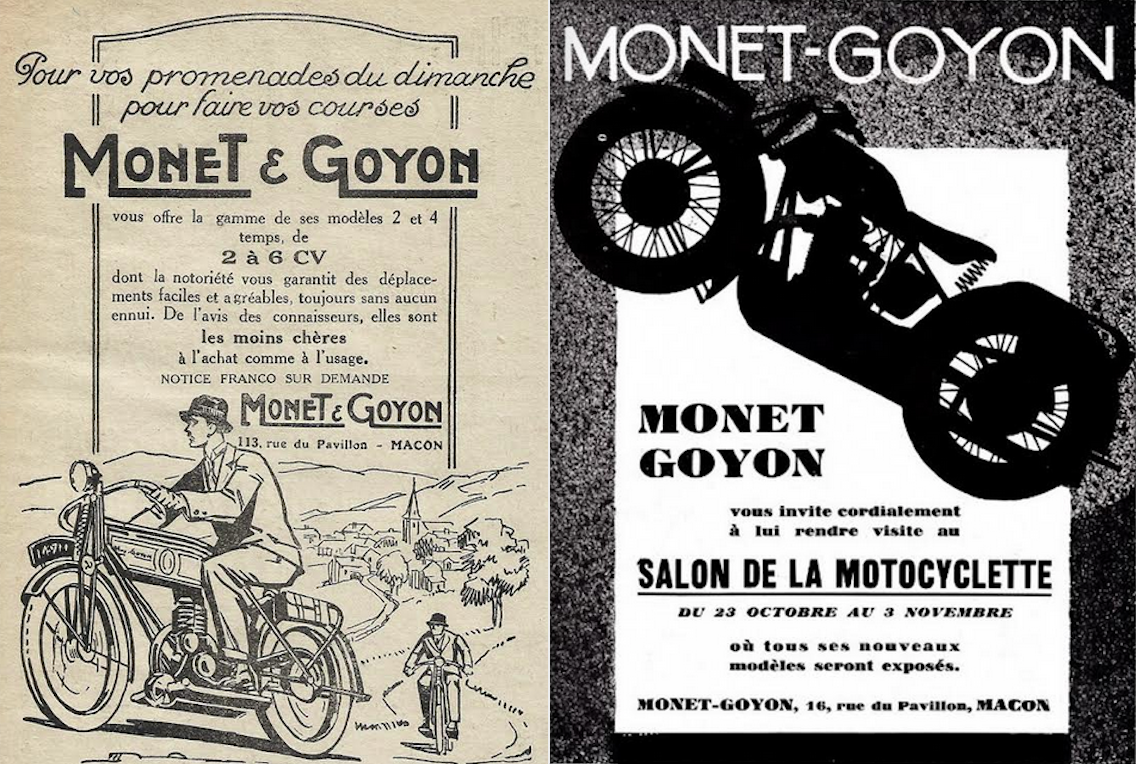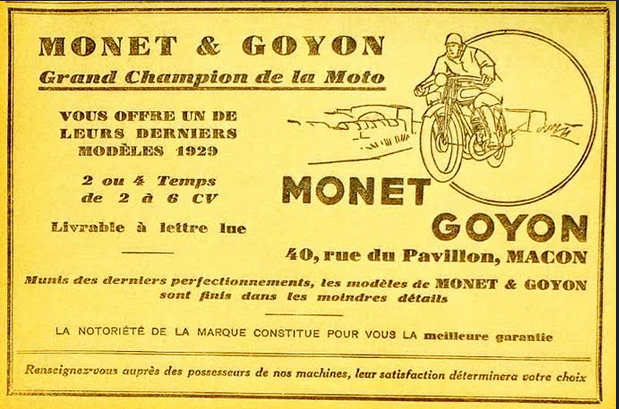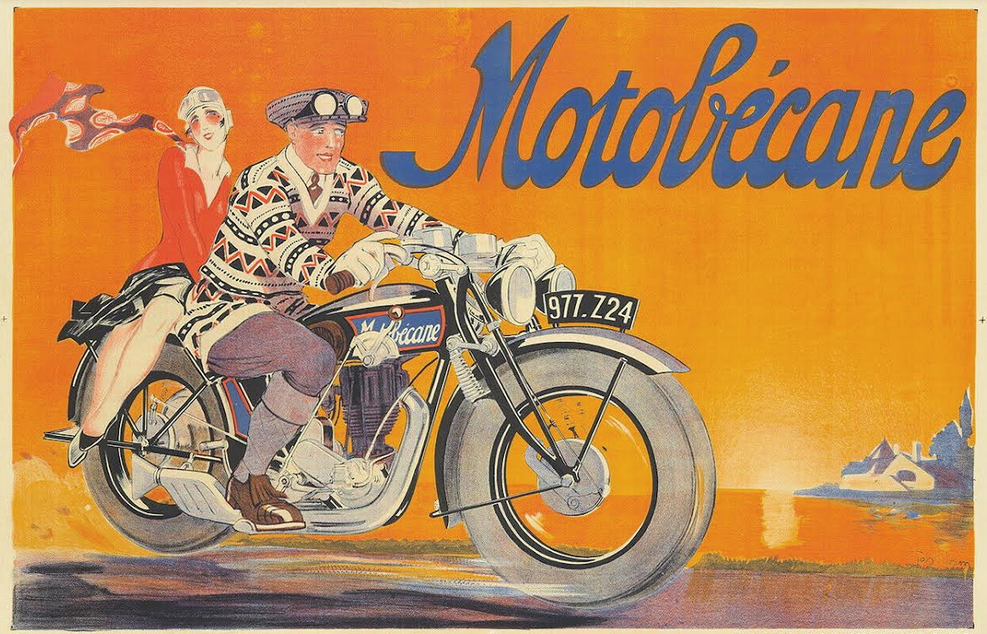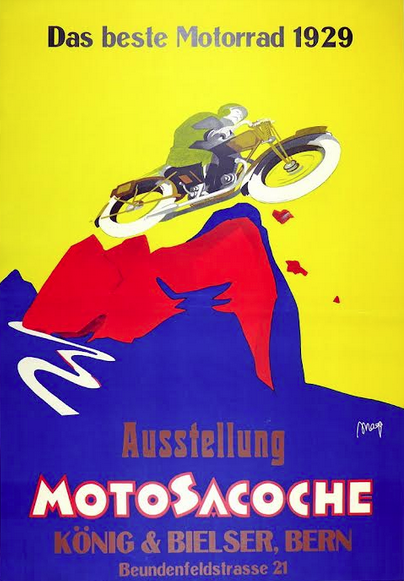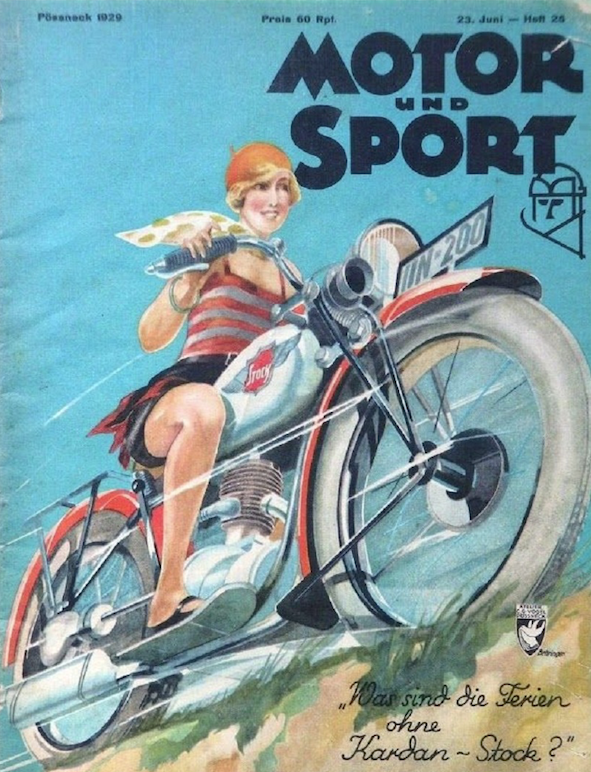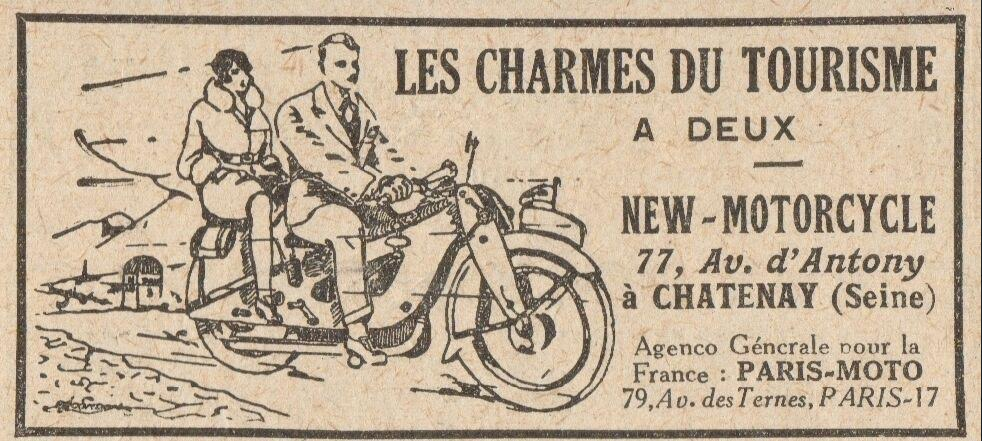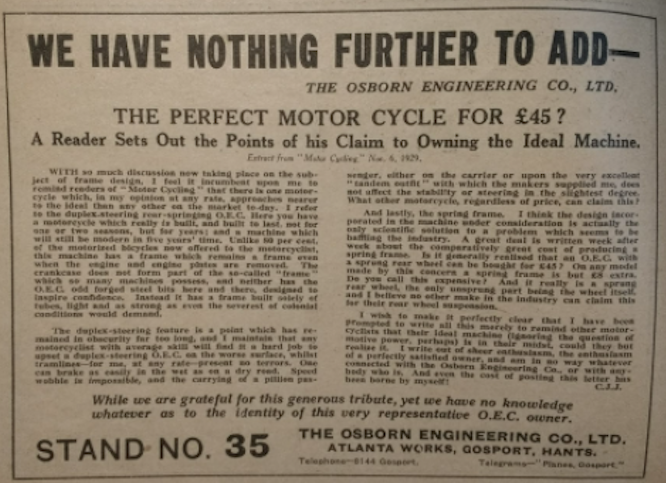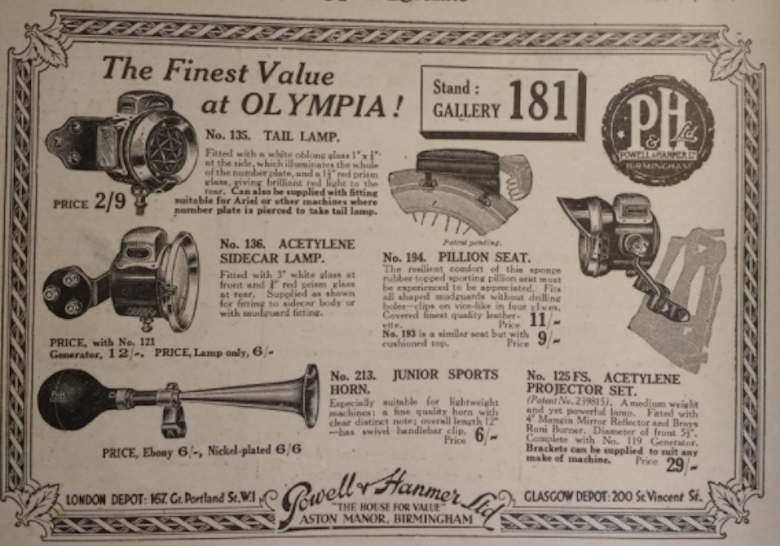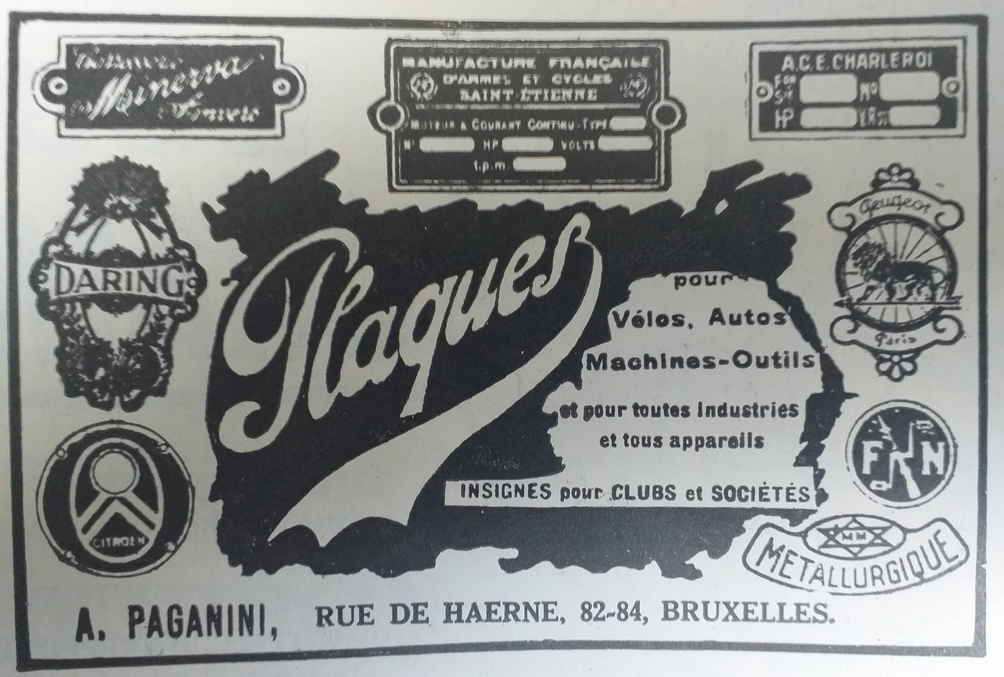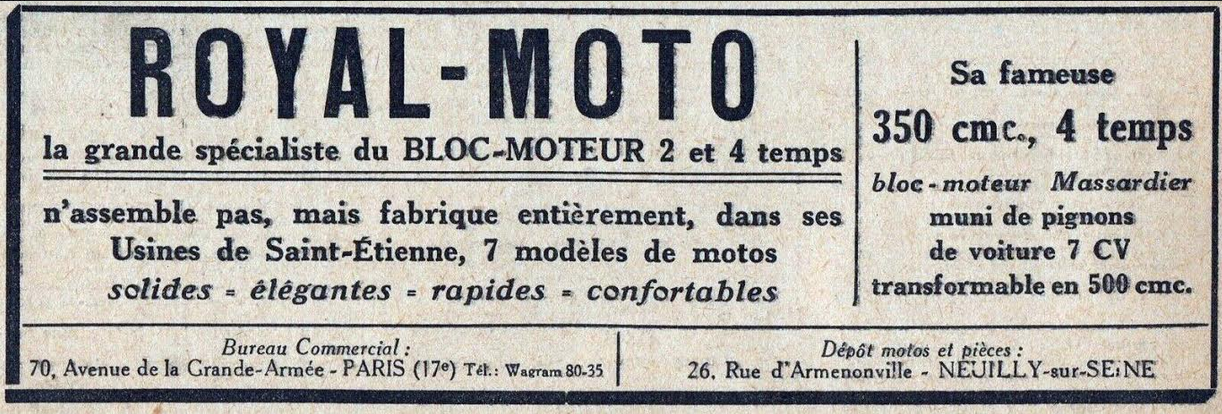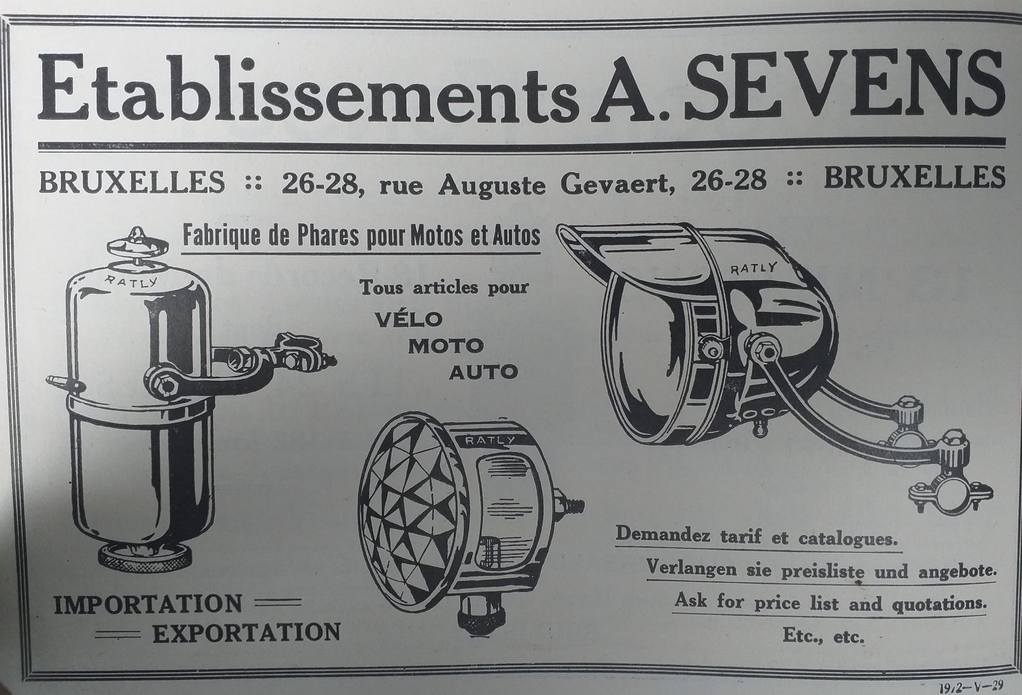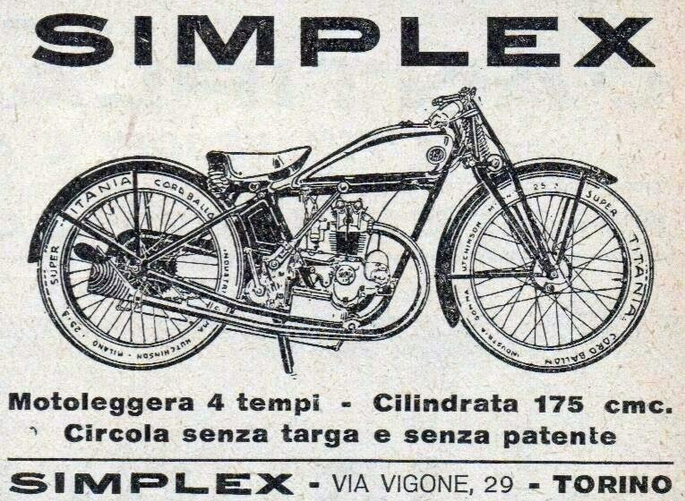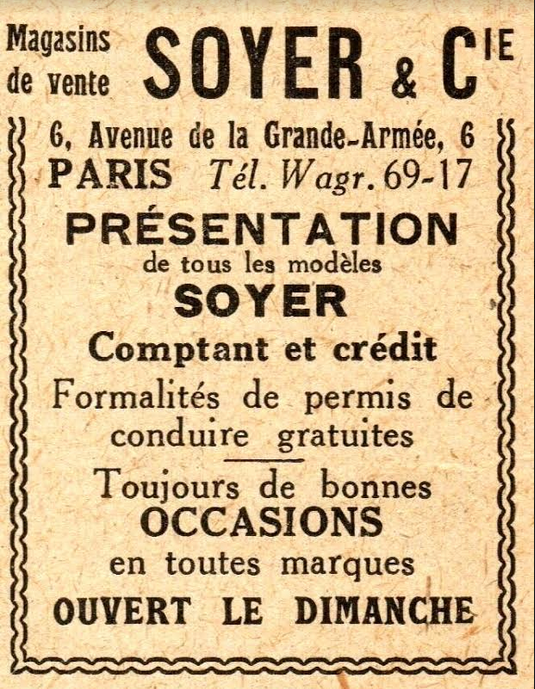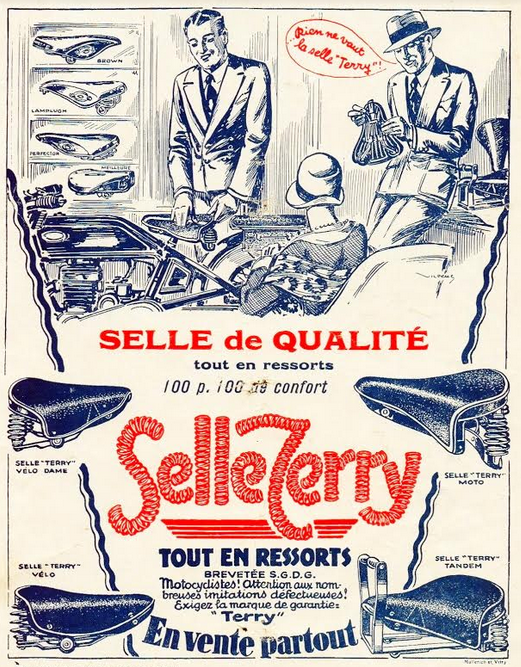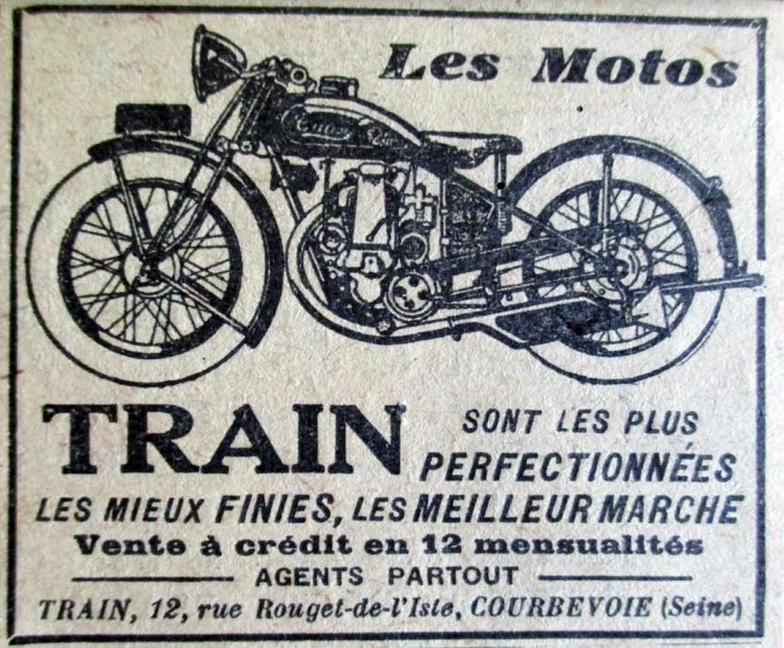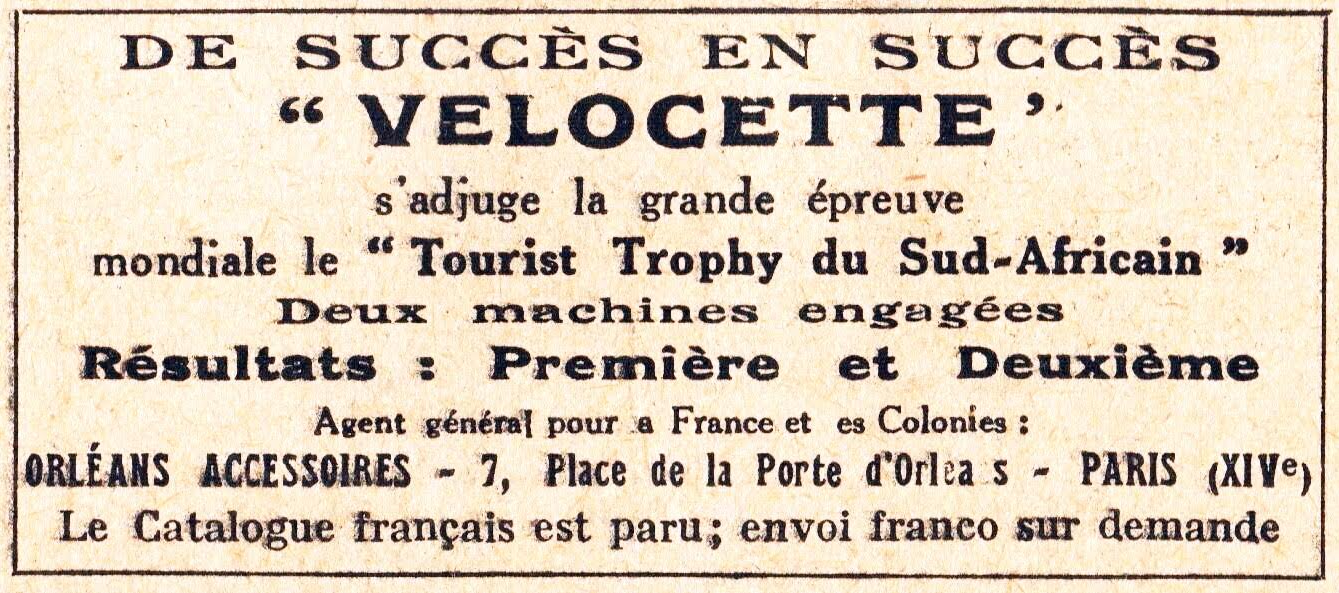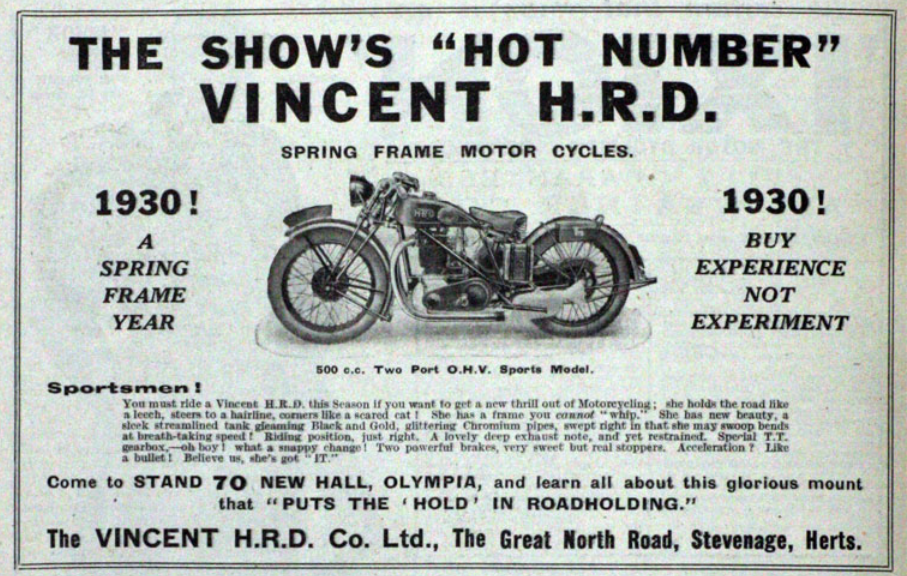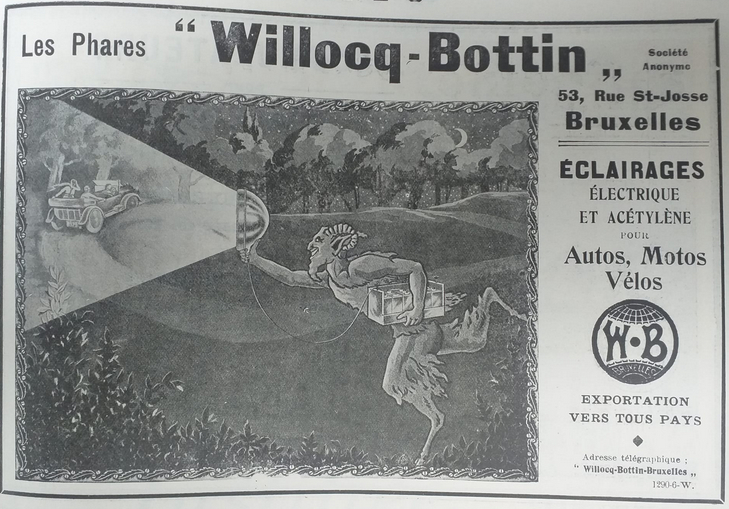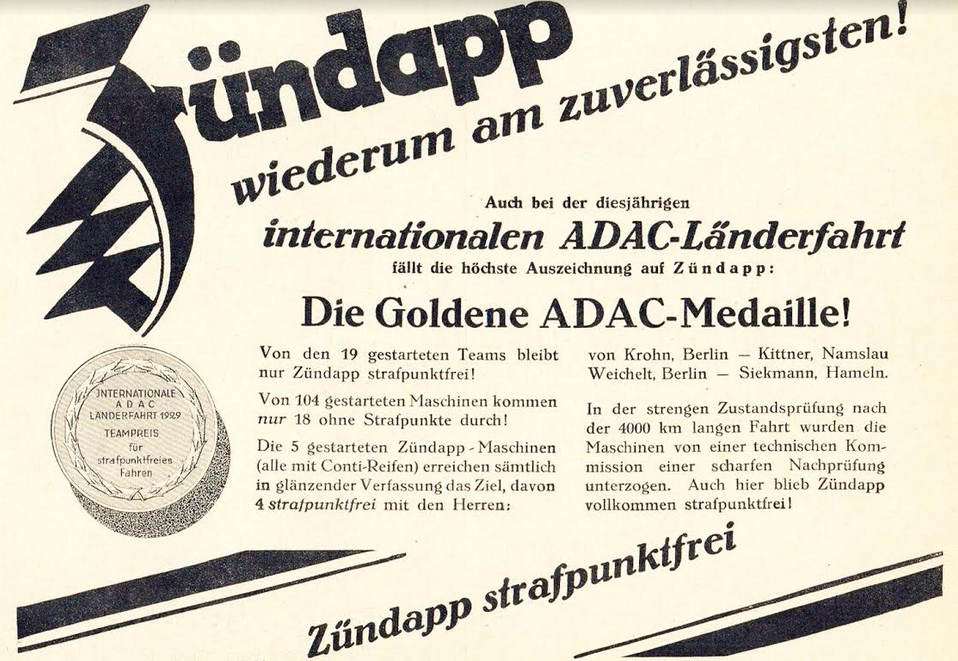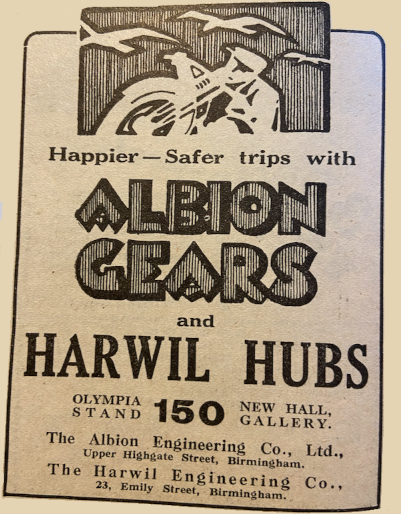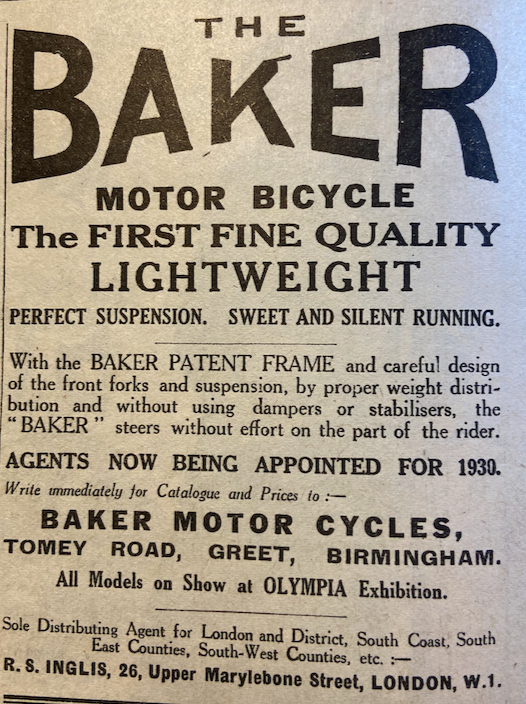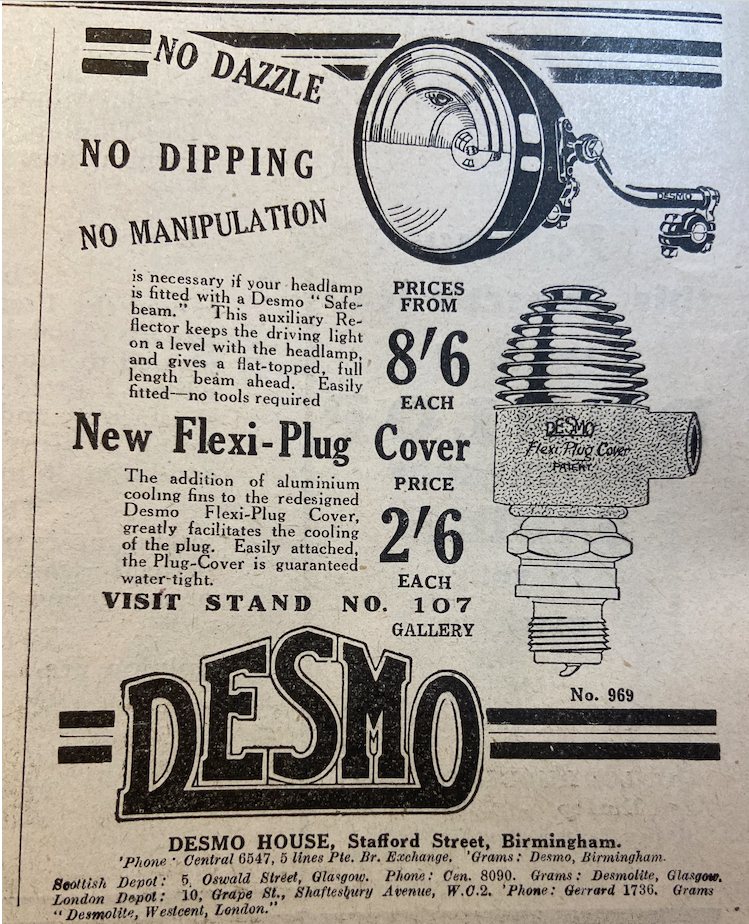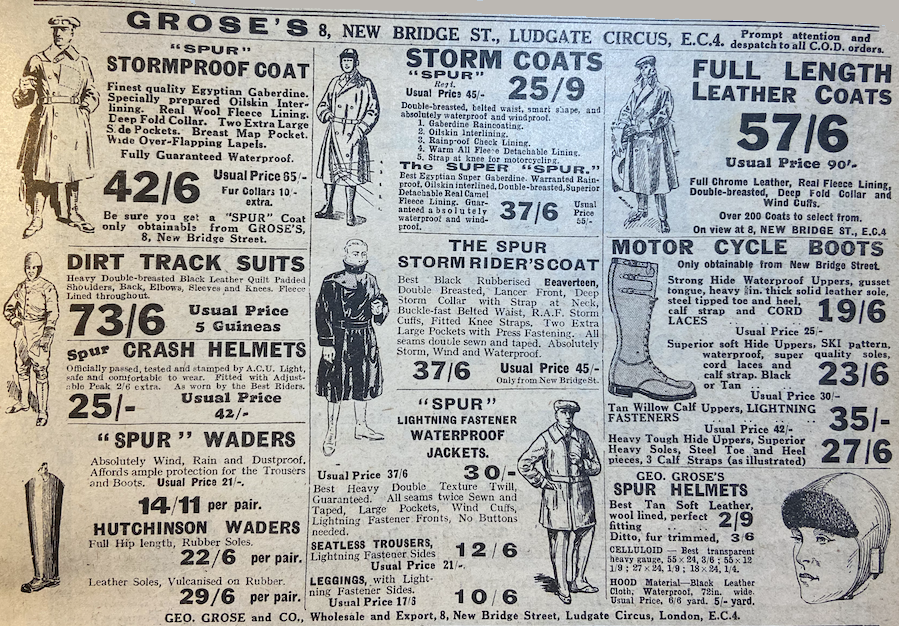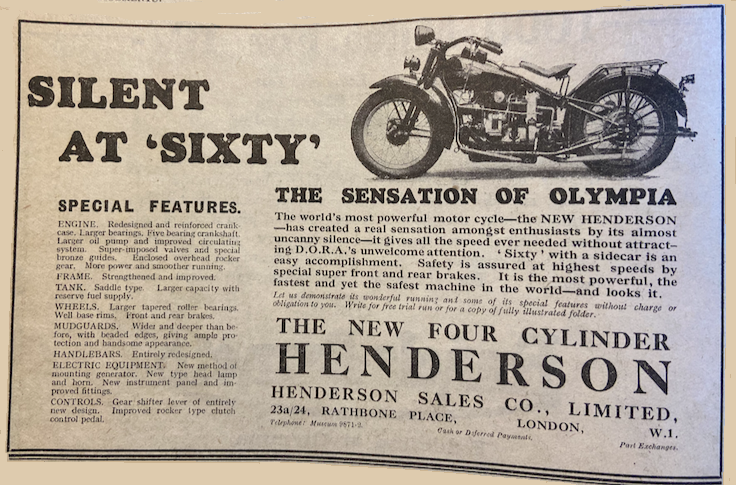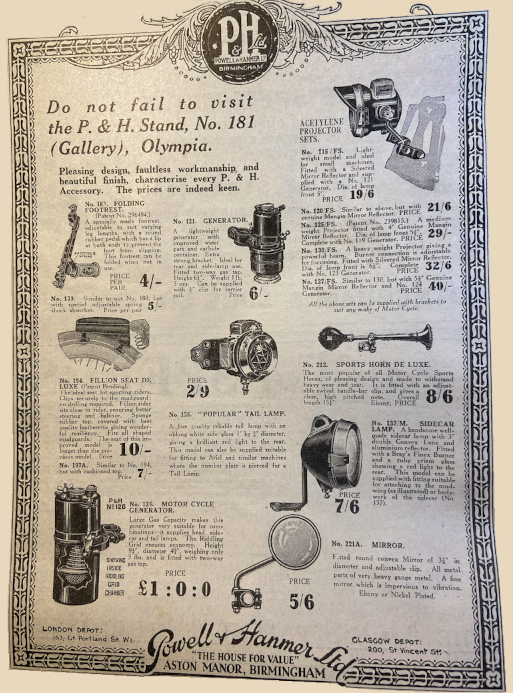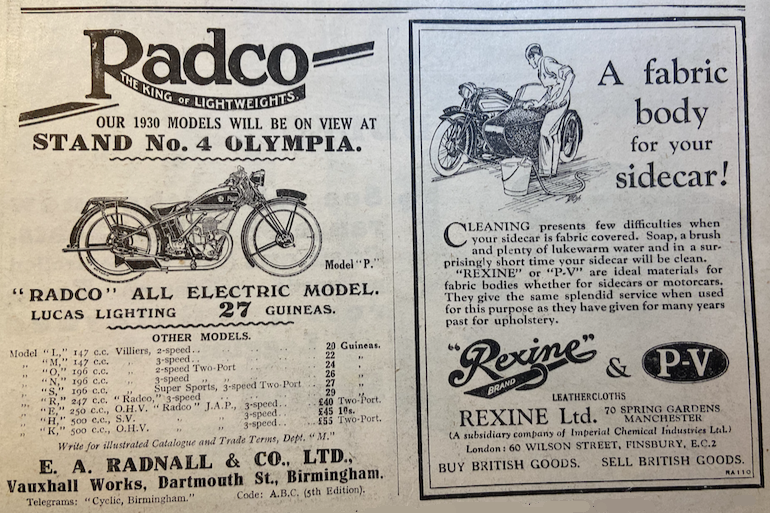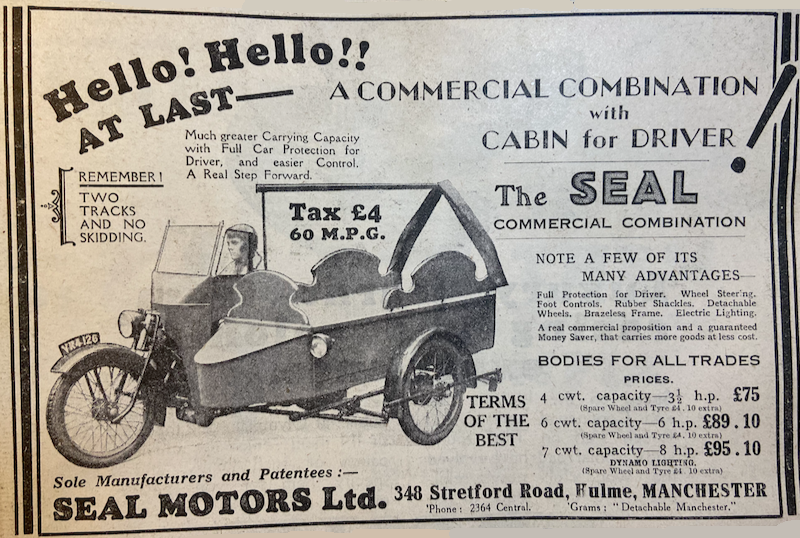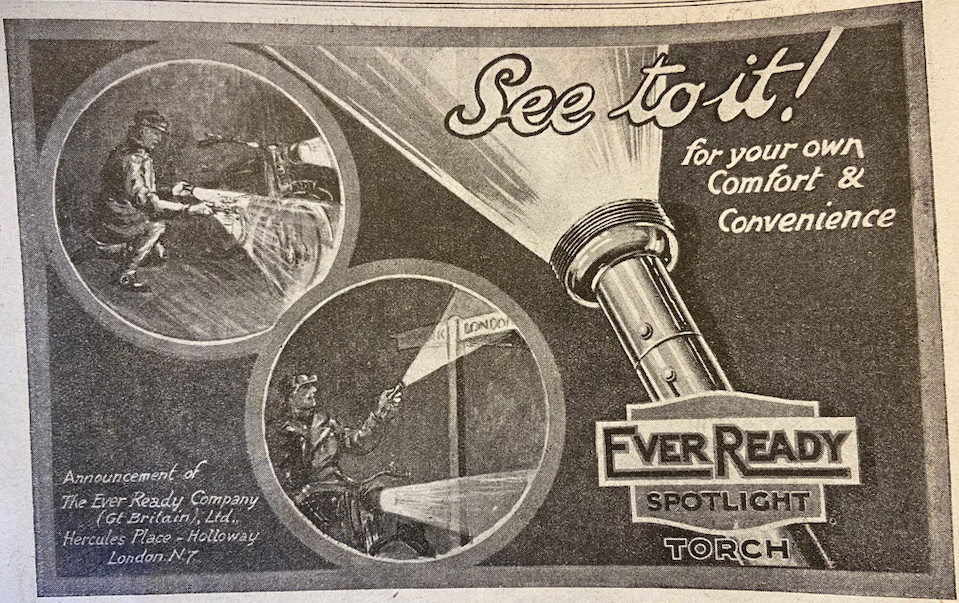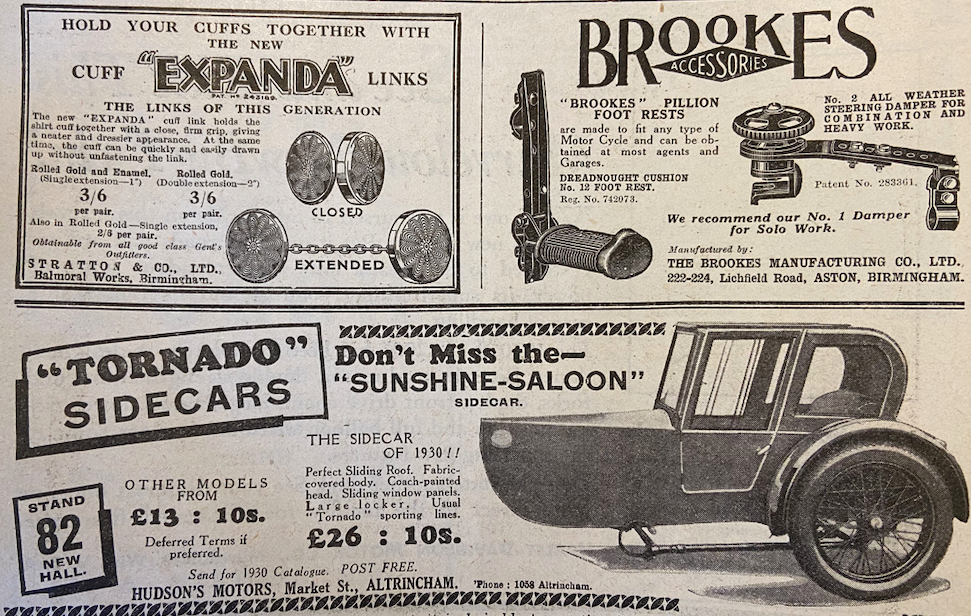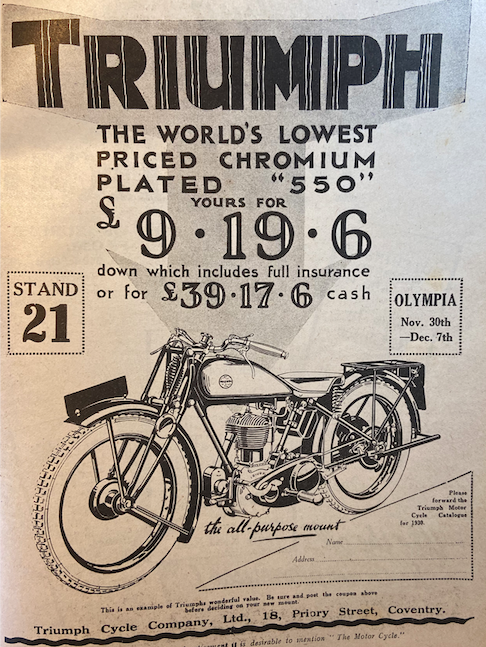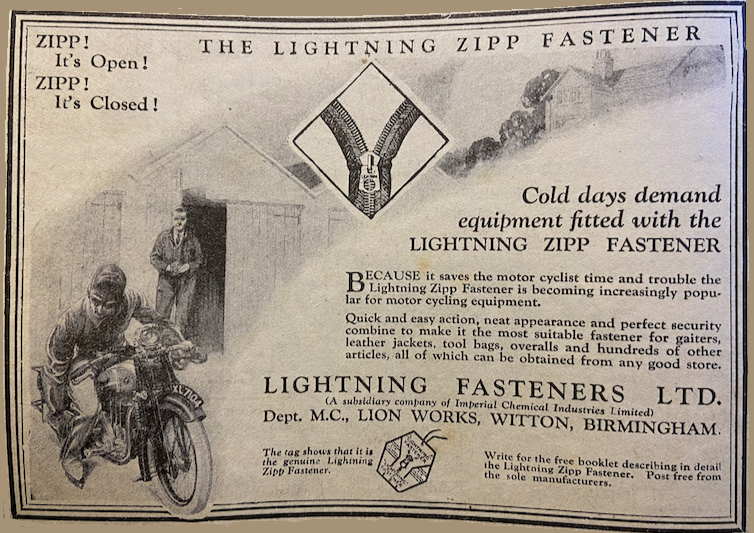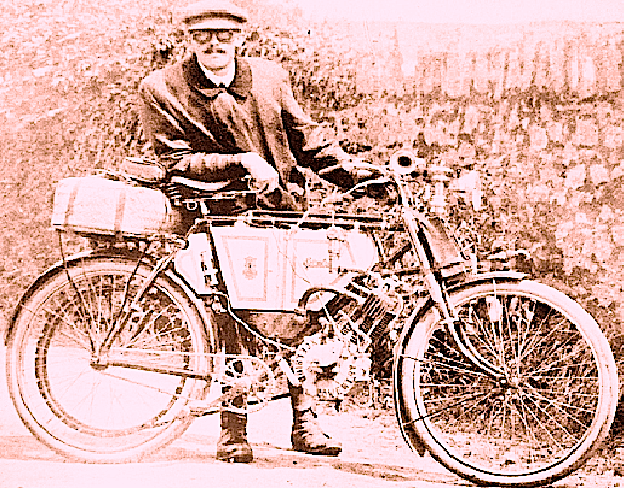AMID THE NEWS AND TECHNICAL REPORTS The Blue ‘Un had a taste for features that ranged from whimsical to downright silly. They often appeared around Christmas time but the two that follow were culled from January; they are, I suggest, space fillers written in advance to give the staff time to recover from the Christmas merriment (we did the same thing when I worked for Motor Cycle Weekly in the seventies and eighties). They’re easy reading and serve as a light hors d’oeuvres for a busy year on two and three wheels—and, in Ariel’s case, floats. The first, under the heading ‘In the Not-so-old days’, offers “Reminiscence of Road Adventures Experienced by a Rider of Today”, by Centaur…
“ALTHOUGH THE SUM TOTAL of my riding experience does not exceed eleven years. I have, thanks to the reliability of post-war machines, been en abled to cover many thousands of miles during that time, and in the course of my wanderings many adventures have befallen me. In consequence my memory holds a considerable store of reminiscences, some sad, some gay, but all dear to the heart of a true motor cyclist, and ever ready to conjure up visions of loved and long-departed mounts. Perhaps what was one of my most intriguing experiences occurred shortly after the War when I was re turning late one night from an East Coast town. I had reached a particularly bleak piece of open country when my machine, an old WD Douglas, started to show various signs of distress. I stopped, and discovered that a valve cotter had jammed between the valve stem and the spring collar. It was distinctly annoying, but I had little doubt that with the very complete tool kit in my possession I should soon be able to put things right. Judge my horror, then, when I found the tool bag gaping open and no sign of the contents! It was while I was composing a few sentences to describe the situation that a voice at my elbow caused me to jump with fright by enquiring ”Allo, wot’s up?’ I turned swiftly to find myself confronted by a burly specimen of the Bill Sykes type, with a large bag over his shoulder. Now. I don’t like people who roam the countryside late at night with bags on their shoulders, so I haltingly explained my trouble. ‘That all, mate?’ he said, when I had mentioned about the bike, ‘we’ll soon put that right!’ Off his shoulder came the bag, and as he spread it open in the light of the head lamp I saw that it contained tools. And what tools! Various sizes and shapes of pliers, several keyhole saws, a small crowbar—and a large bunch of keys! So much I saw before he snapped the bag to and went to my machine with a particularly neat pair of round-nose pliers in one hand and a flash lamp in the other. A few minutes’ tinkering round the engine and he straightened up. ‘Right as ninepence now, guv’nor,’ he said. A brief inspection showed me that everything was indeed OK—the cotter was once more in its rightful position. I thanked my strange helper profusely, and endeavoured to press a half-crown into his hand. ‘That’s all right, guv’nor,’ he said, ‘might want help meself someday.’ I did manage to get him to accept a cigarette. however, before he turned away with a ‘So long—mustn’t be late for work.’ ‘Work.’ I wonder…? A few months later, owing to financial reasons, I was forced to sell the Douglas, and to exist motorless. I stuck it for six months, but then the urge for wheels became almost unbearable, and when a friend announced that he knew where a perfectly good three-wheeler was going for £4 I jumped at his suggestion to go fifty-fifty in the

purchase of it. I am not going to say anything rude about that three-wheeler. It was a perfectly good specimen of the type usually fitted with a large body and driven by a small tradesboy. This one, however, had a remarkably comfortable two- seater body, access to which was gained by lifting a flap. Funds being limited, we were unable to tax the bus at first, so our usual procedure upon spotting a policeman who looked interested (believe me, policemen weren’t the only people interested in our turn-out!) was to open flat out and roar away at about 15mph. Failing the opportunity to do this, we would stop the engine, lift up the flap and clamber out, restart the engine by means of a huge handle, climb back into the seats, and close down the flap again. By the time this procedure was completed it was a safe bet that the Law was in convulsions—thus we got away with it! One day we injudiciously left the bus outside the house with the engine running. When we came out it was nowhere to he seen! Suddenly we espied it lovingly embracing the front railings of a house about 50 yards down the road. Visions of our cherished possession smashed beyond repair floated before us as we dashed in pursuit. We discovered, however, that the only damage was a burst front tyre—until we dragged the bus into the road! There, clinging to its underside, we saw what was once a ‘gent’s smart push-bike’, now a cross between a grid-iron and a birdcage. We were considering the proper procedure to adopt in an unfortunate contretemps of this kind when the owner of the aforementioned push-bike appeared. He was distinctly annoyed—and said so! The upshot was that we had to sell the three-wheeler to pay for the damage. And I was left motorless once more. Two years passed before I was able to afford another motor cycle. This time my choice fell upon a huge Yankee twin. I could have chosen something more suitable, for my small stature really necessitated a pair of steps in order to reach the saddle! Also, once aboard I could only just touch the ground with the tips of my toes; consequently traffic riding was far from pleasant. However. I managed without too many adventures until, owing to pleasure from a feminine quarter, I attached a sidecar. Then trouble started in earnest. In fact, it started while I was fixing the ‘chair’, and was probably due to just indignation on the part of the bike at the thought of being put into harness. Anyway, it pushed me into the sidecar and then lay on me. I was there a good five minutes before a pal found me and removed that 300lb of knobbly ironmongery from my chest. By that time the arm had entered my soul! I had some good times with the sidecar—after I had learnt to keep the wheel down—and there was always competition among my friends as to who should occupy the ‘chair’ in the absence of the usual fairy. One fellow in particular, a huge chap weighing about 13 stone or so, was terrifically keen, and not particularly scrupulous as to how he got the rides, either! One day I had just left the garage with an empty sidecar and was accelerating down the road at about 10mph when a sudden crash at my side nearly caused me to lose control. I looked down and found to my amazement that my fat pal was snugly ensconced amid the cushions. He was grinning all over his face, and plainly pleased at the success of his vaulting act. But suddenly a look of horror began to erase the smile, and searching for the cause of his dis comfort I was astounded to see that his body stopped short at his knees—the rest of his legs was missing! Of course, I guessed at once what had happened. The force of his fall had knocked the floor-boards clean out of the side-car and allowed his legs to drop through on to the road. Here was a chance for revenge, I

thought. I could see that he would have the utmost difficulty in extricating himself, so I throttled down to about 4mph and made the fellow walk about a quarter of a mile inside the sidecar. Some young ladies who were on distinctly good terms with my friend assured me later at me that the sight was very amusing. Anyway, this particular lad suddenly lost his interest in sidecars, and never asked for another ride! Some months passed, during which I owned many weird and wonderful machines, mostly of the side-valve variety. But, as was inevitable, I eventually got bitten by the speed bug. Nothing less than an ohv Norton could satisfy my desires, so by dint of careful saving one of these machines came into my possession. It was fast when I first purchased it second-hand, but (spare my blushes) it went a bit faster after. I had played about found with the ‘works’. Thereafter, with true boyish enthusiasm, I would haunt the wide open stretches of an arterial road nearby, in search of trouble. Eventually it came—good and proper—in the guise of a mild-looking little man dressed in a mackintosh suit and trilby hat, and riding a most disreputable-looking side-valve single with real ‘touring’ handle-bars. He passed me at about 40mph without the slightest of side-long glances. That couldn’t be allowed, so I promptly turned up the wick and repassed at about 50mph, and kept the bus at that speed in the hope of losing him. I had gone perhaps a quarter of a mile when to my amazement s terrific clatter at my side told me that my adversary was not yet done with. As he came level I opened flat out, and as the speedometer climbed to the ’65’ mark, I was gratified to find that the clatter gradually dropped behind. Not for long, however, for this time he took a run at me and if he wasn’t doing a cool 70mph as he passed, well—I’ll eat my bowler hat, brim and all! At this point in the argument the arterial road degenerated into a fairly narrow country lane with numerous twists and bends. The way that fellow cornered was a revelation! Suffice it to say that after the second bend I never saw him again, and I went home in a very crestfallen state with a considerable amount of conceit knocked out of me. It was not until that evening, when discussing the denoument with my greatly amused friends that I found my late adversary was none other than ————, the famous TT rider. Apparently he was also riding his TT machine, suitably detuned, I suppose, for touring purposes!”
AND, SECUNDUS, A SMASHING space filler from The Motor Cycle’s Northern correspondent Wharfdale, which even sports a superior version of ‘the editor called me into his office’ cliche intro. The editor was, for no clear reason, known by his scribes as ‘Horace’; the features was headlined ‘Thanks, Horace!’ with the intro “Orders from ‘GHQ’ that Resulted in a Scramble in the Snow at England’s Winter Sports Centre.” Over to you, Wharfdale…
“IT WAS A VERY FAINT VOICE INDEED that drifted over the long-distance line. But it was a voice to which one gave heed. It was the voice of Horace speaking from the gloom and fog of London. And the voice said: ‘Look here, Wharfedale, you’re supposed to live in the frozen North; why haven’t we had an article about winter riding on snowbound roads? Must have one this week.’ Now, by all the conventions of writing, I should have replied to this opening gambit by one of two methods: one, the ambitious, young and enthusiastic journalist—the go-getter who will produce his ‘copy’ briskly at the right moment and win the fair daughter of the ‘chief’ (method ‘a’ for short); or the soured hack, bereft of hope, single blessedness and enthusiasms (method ‘b’). Method (a)—’Yes, sir, at once, sir, it shall be done.” Immediately followed by floppy sounds ‘off’ as of waders being flung on; then the ‘staccato bark of a well-tuned single’. (Ertcher!). Method (b)—’Oh, yes! Well, we’ve a fog on here, but I’ll step out and order some snow. Say, what are you doing in the office, anyway? Can’t you…?’ As a matter of fact I didn’t follow either of these methods for the simple reason that my secretary took the call. (By secretary I mean the charming young lady who gives the once-over to mad inventors before admitting them into the inner presence, and who discreetly fades away when the local clubmen drop in to query, ‘I say, have you heard this one?’) Yes. She dealt with Horace, and her reply, I believe, was something to this effect: ‘Mr Wharfedale isn’t in. No. He’s gone out to take some photographs. Yes. Snow pictures, I think.’ Observe the signs of quiet and unostentatious efficiency (ahem !). Horace rings up for a winter riding article, and his faithful lieutenant has already adventured forth into the snow-bound wastes to seek experiences and pictures! But there is a terrible confession here to be made. Let us whisper it. Very low…Wharfedale has gone out in a car! It was like this: There were two cameras and a big box of slides to be carried, and Christmas festivities, not to mention a few club dinners, had left rather a weak feeling. So that’s why I stole out secretly in a thing with a wheel at each corner, and travelled via Macclesfield and over the ‘Cat and Fiddle’ towards Buxton—headquarters of English

winter sport. The snow lay thicker as the higher country was reached, and the powdering on the low-lying fields became a dense white blanket on the hills. The sheep were down off the moors and dotted the roadway. An AA sergeant, with his outfit, was fixing a ‘Chains advised’ notice to a telegraph pole. Five gaily-clothed ski-ers had just started out across the snow-buried heather as I pulled up at the summit, where their big saloon was sheltered behind the famous inn. Now for the camera work, I said, rather peeved at just missing the ski party. Anyway, they were heading for the Goyt valley, so, happy thought, I would cut them off. I drove down the old road in that direction. It looked good, too! Level, unbroken snow, and not too deep. But a hundred yards from the main road there was a swerve and a lurch, and the car came to rest. ‘Throwing in the reverse,’ as the lady novelists say, I tried to back out but nothing happened. Happy thought number two! Put the chains on Did so, and still nothing happened. Car resting bodily on drift, all wheels clear of terra firma. It didn’t need two cameras to photograph that car, which was my only picture, but it did need the mats, floorboards, the AA sergeant (who providentially came up) and a helpful young man with a shovel—who appeared out of thin air apparently—and my brow darker. This seemed bad work; so next day the faithful ‘model’ was brought Out. Soft snow of even depth is easy; hard, frozen snow, especially if much broken or rutted, may call for firm steering. The polished ruts made by much heavy traffic are perhaps most trying, but I find that an even, steady pace, a fairly hard front tyre, and feet at the ready will get you there with safety. I always like to pioneer a rut of my own in the unbroken snow at the roadside. Lorries don’t leave you the road crown, and big saloons, chain-shod, come hooting along without yielding an inch. Discretion is the better part of valour in such circumstances. Give them room, brother. Snow, part melted, is more searching than any other form of wetness. Remember thy chains, and keep them oily. and cover up thy magneto. My second day was much more successful than my first—after all, a solo’250′ can’t become the incubus that half a ton of car, floated on top of a drift. can be. One can drag, lift or push the two-wheeler through most places. on long as they are not too bad to walk through. True, I wasn’t able to carry two big cameras and a great box of slides. But I had a good day. and practised all kinds of skidding, both plain and figure, in the snow patches. And got home with a wonderful appetite, and so to bed, praising Horace for his thoughtfulness in sending the instruction that justified my leaving the workaday office for an outing on Peakland’s snow-covered hillsides.”
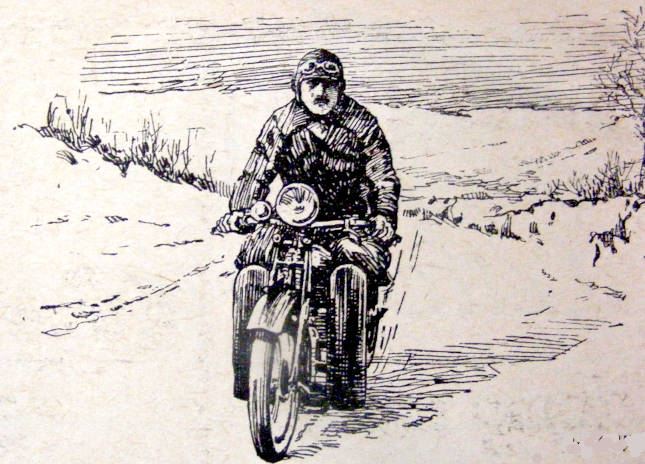
OTHER FEATURES IN THAT January issue of the Blue ‘Un included ‘Cameos from the Wooded Westland’ (a spread of West Country scenic pics “to stimulate the desire to visit this district when the longer days arrive”); ‘The Sound at Daybreak’ (a fishing yarn by H Mortimer Batten that opened with “There was the faintest brightening of the east as we packed up our tackle for the night—our baskets were heavy with trout running three to the pound…”; and ‘The Return to the Fold’, with the intro “After being Fleeced by Wolves and Wandering in Strange and Unaccustomed Paths, a Lost Sheep finds his way back to the Cote.” I can’t resist inflicting the opening paragraph on you: “I know not what precisely are the feelings of ecstasy and reclaimed vitality that follow a successful operation of rejuvenation, but I presume—if all that is claimed for it is authentic—that the grafting of monkey glands into an elderly person’s internal working assembly must produce a state of exhilaration and animation somewhat resembling my own at the present time. I hasten to add that I am far from the tottering stage, but I am again taking an active interest in the affairs of the motor cycle universe after twelve months’ divorce from participation in this sport of ours.”
YOU’VE SUFFERED ENOUGH. Take a dose of Ixion to clear your palette. In fact take five doses.
HAPPY DAYS! “Since December 28th I have been prostrated with a frightful attack of Exeterenza. My Squirrel has hibernated; my Ariel hack has cast a shoe and gone dead lame; my Panthette retired to the warmest and darkest recesses of its cage, and not even a sucking pig filched from the larder on Christmas Eve and dangled before the bars would induce it to come out. At last I cadged a scat with one of The Autocar plutocrats and went west in a ‘sunshine’ saloon with the roof stuck full open. Hence my New Year message of hope has had to wait till this issue. All the best to everybody! If you’ve got a bike, may it go well; and when it goes too well may a passing fly temporarily blind the bobby who sees you. It you haven’t got a bike, may the relation whom you value least decease as painlessly as possible and bequeath you the wherewithal. May your pillion fairy balance nicely, never cling too tight. and insist on paying for all her tarred stockings. If you’re in the trade, may you enjoy record sales, encounter no service grouses, and make no bad debts. If you’re on the Press. may you soon have a new editor. Above all, may we have lots of sunny week-ends and decent weather for the TT.”
“CONTROLLING A REAR-WHEEL SKID. Your reaction period, as the RAF call it (ie, the interval between putting the lighted end of a cigarette in your mouth and ejecting your pet oath) may be so long that you will hit mother earth before you take any steps in the matter of the back wheel, but unless you are a dreadful dud or frightfully old you will instinctively do something. You may do it late, or do it wrong, but you are pretty sure to do something. And if you are youngish, and have any notion of balance, and your nerves have not been shattered by riotous living, you will very soon learn to correct a rear skid with accuracy and success. If the rear wheel skid occurs on the diabolical surfaces which trials secretaries love, the wrench of correcting skid No1 may induce skid No2. Skid No2 will catch you in the wrong mood for cool and scientific action. Your mouth will be wide open, and regrettable words will be hosing out of it. Your heart will have deserted its proper location under the left armhole of your vest, and will be fluttering under your collar-stud. Your feet may be doing splits at the level of the filler cap. Your elbows will probably be akimbo, and your tongue sticking out far enough to lose its tip when your teeth close. But one rear skid occurring by itself is child’s play on ordinary surfaces and with an average bike.”
“THE SIDESLIP BOGY. I notice that all my letters from utility riders of over thirty years of age mention the dread of side-slip, and it is a fact that no factory has ever yet organised any intense research into this bogy. Until a man is fifty years of age or so he does not seriously mind those tumbles which we all take on occasions. But the trouble to-day is that there is so seldom any free space on the road whereon we may fall. If we lose control of the bus in a skid, the odds are that we shall find ourselves under a lorry or a motor ‘bus. So a man who tries riding to work in any city or industrial area decides after one or two lucky falls that the next fall will very probably lead to his being ironed out into a pink mash by a five-tonner, sells his bus, and buys a tram season ticket. One or two machines have proved unusually easy to hold up. The original open-frame Scott was one; the duplex-steering OEC is another. The question is whether a year’s research on the part of a No 8 hat might not evolve a machine which almost anybody could hold up at normal speeds on all normal surfaces. After all, a very moderately expert push cyclist never fails off in a skid (apart from trapping a tyre in a tramline); and his centre of gravity is very much higher than that of a motor cyclist, while his tyres afford far less grip of the road. The solution of this problem is one of the main keys to establishing utility twelve-months-a-year motor cycling on a firmer basis.”
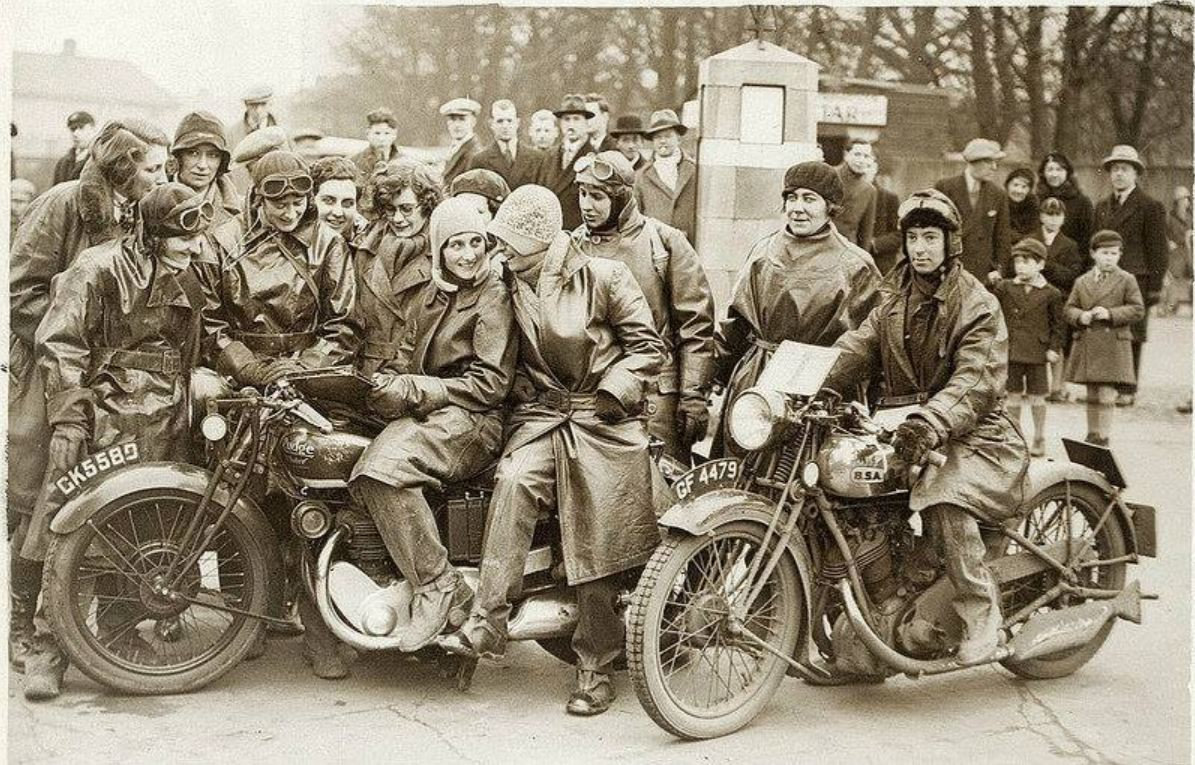
“‘ADDLESTONE’, A CORRESPONDENT of mine, is thoroughly thrilled with the proposed Everyman Trial in 1930. His local cycle shop boasts a stock ranging from the 19lb stripped road racer with dropped bars to an all-black, heavy tourer with sit-up-and-beg bars ; he says if all cycle shops stocked nothing but 19lb. road racers most of the cycle shops would have to close down within six months. Whereas, by contrast, in motor cycle showrooms the road-burner type of bus always has the place of honour, just as it has in the Press and in trials and club life; and a utility bus, manageable by a weak or elderly or female rider, can seldom be found in the stock of a small agency, though it could, of course, be obtained to special order. Suggestions that Addlestone makes for an Everyman bus run as follows: (1) Short wheelbase (ie less leverage created by a skid). (2) Tyres not less than 3in (irrespective of machine’s size). (3) Four standardised nuts, with two double-ended spanners. (4) Legshields (quickly detachable). (5) Magneto high up behind engine. (6) High clearance (utility riders frequent tough lanes). (7) Woolly side-valve engine, with tolerable acceleration. (8) Safety on grease to bc intensified by research. (9) Genuinely adjustable riding position. (10) Experimental designs to be vetted by duffers rather than by experts. (11) Large silencer, easily cleanable.
“A STRANGER IN A (VERY) STRANGE LAND. My Christmas letters from the exiles are beginning to flow in. One of them is the only Briton in a big German factory. For one thing he is a Tory, and his men are all flaming scarlet in politics, which annoys him. For another, he has ‘never defaced his bus by a carrier housing a pair of gawky legs’, and the local lads all take pillion riders and corner slowly on top gear with both inside boots on the ground. For another, he considers the local Helles beer a miserable substitute for Worthington, and when a single bottle of Black and White appeared on the shelf of the local ‘Pig and Whistle’ (‘Der Vaterland’), they charged him 1.75 marks for one finger of it. For another, he has to tighten up nuts on the job with a spanner that doesn’t fit. He has only once seen a motor cycle exceeding 30mph and when the rider’s hat fell off no attempt was made to recover it, from which he opines that the lad was fleeing from justice in a completely scared condition. He showed the Blue ‘Un pictures of the Scott Trial round the works, and the local riders seemed considerably shocked, and remarked that it was ‘very bad for the bikes. and ought to be verboten’. A very bad attack of homesickness, gentlemen!”
It’s not surprising that photos of the Scott Trial alarmed even hardy Teutons; it had a reputation as possibly the toughest of all the one-day trials, to the extent that it was nicknamed ‘The Tragedy’. Even on easy years, it was hard but, judging by this report, everyone concerned had a jolly good time.
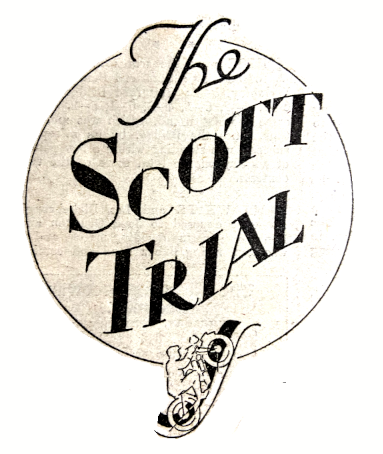
“WHAT SHALL BE SAID OF THINGS when the Scott Trial riders come home in unprecedented numbers and say that it has been too easy? What shall be said of a Scott ‘Tragedy’ in which only 22 people retire out of 110 starters? What shall be said of a Scott course that allowed forty folk to gain first:class awards and 35 other riders to get in within ‘certificate’ time? Must it be said that the Yorkshire wilds are l ess wild, or that riders are more he-mannish, or that machines are so much better that they float over all obstacles? Perhaps a little of all of these things accounts for the state of affairs. The course was shorter than ever before and the time limit wider, so that all and sundry—pip-squeak riders, the weak but willing, and the rabbits—had a much better chance of getting home. The weather, too, was much kinder—it was a splendid day, and there had been no rain previously to complete the frightfulness. In consequence, watersplashes were empty and even the appalling Denton Moor was devoid of those occasional morasses into which machines sink, leaving riders standing in surprise, astraddle in mid-air. The start, as usual, was in Higher Wharfedale, at Grysedale House, in the Moorlands. There were nine non-starters in the entry list of 119, and none of these was more reluctant to be in this category than Alec Jackson, whose entry form was bungled in some way. Alec had put off his track engagements specially for

the great day but the stewards were inflexible; he could not ride. WG Gabriel (499cc Triumph), another of the Scott Trial habitués, had worked nearly all night re-juvenating his ancient Ric-umph (that has survived the course for no one remembers how many years) and reached the start nearly half an hour late. Nothing very much of a troublesome nature as faced in the first few miles, although one muddy lane cost nearly everybody a few marks, and Heights Laithe saw the first two retirements—NE Peacock (499cc P&M) and B Holden (348cc Velocette). JE Storey (499cc Rudge-Whitworth) was cut badly in the face by a flying stone from someone else’s rear wheel. Threshfield Moor was cut out, but Linton Watersplash had been dammed somewhat. Here E Mainwaring (596cc Scott) retired although not much trouble was experienced. A certain amount of rough stuff shook people up in readiness for Doantby Rash—the alleged ‘only freak hill of the trial’. A big crowd of spectators had arrived, and the lack of parking facilities for the many cars added confusion to difficulty at the foot. Doantby Rash is a long climb, starting with a grass load, with a middle section of loose stones and a final piece of slimy ruts. The whole of the hill is under trees, and it was sufficiently damp to be tricky. Povey (340cc Rudge-Whitworth) was the first arrival, and he tackled the gradient at speed, making a fine show with just slight footing at the summit. BJ Jenkins (494cc Triumph) tried the slow and steady method, and also had to use his feet. CM Harley (495cc Matchless) simply streaked up, fighting the swerves of his model wonderfully, until he had to foot near the top. L Ellwood (248cc Ariel) was slow and used his feet slightly, but E Damadian, on a similar model, screamed up twice as fast, tried to overtake him, and then bought the first box of tacks recorded in favour of the hill. Half a dozen people came up, using feet ‘as and when’, then R Syers (493cc Sunbeam) essayed a speed
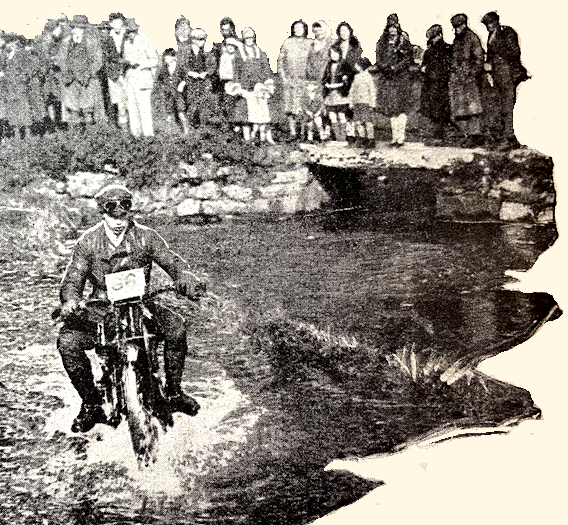
climb, caught the stump of a tree with his footrest and stopped with a ‘wump’! Then came GE Rowley (498cc AJS)—a real ‘racer’—flying up through grass and stones. A cheer commenced, but the sound was frozen in mid-air when the AJS made one wild plunge and flew vertically upwards, spilling Rowley off backwards. Just the same thing happened to Jack Williams (499cc Rudge-Whitworth), then EH Welch (493cc Sunbeam) demonstrated the slow method and did excellently, with only the slightest touches at the top, and both C Williamson (490cc Montgomery) and PW de la Haye (346cc Levis) were almost as neat. PH Smith (596cc Scott) obliterated the landscape with smoke and wheelspin, while H Harvey (348cc Velocette) of the ‘Salers’ (who don’t care!) rammed the bank good and proper. Calling ‘Look cut!’ C Helm (493cc Sunbeam) negotiated the hill and the gentlemen in difficulties with considerable force and determination, while Stuart-White (247cc P&M)—one of the veterans—pursued a steady course with light footing. CJ Marsden (348cc Raleigh) fell, then Geoff Mines (596cc Scott) made a fast show with but slight touches: incidentally, he carried an Army water-bottle, but whether for radiator or personal replenishments is not known. So far no one had climbed Doantby Rash clean. Was it possible? Yes! VN Brittain (493cc Sunbeam) went up straight as a die. Fast! Sure! Certain! Two men floundering he passed on the way, in a passage barely wide enough for two handle-bars side by side. And disappeared at the summit to the echo of cheers. AH Bramley (348cc Raleigh) fell and picked up his machine so quickly that his stop was scarcely apparent, then Wilmot Evans (348cc Triumph), standing on the rests, made a fine attack, only to see his model climb trees at the top. He lifted it down from the branches by the handle-bars, planted it down in the proper direction and was away before anyone could rush to help him. The first real engine failure was by
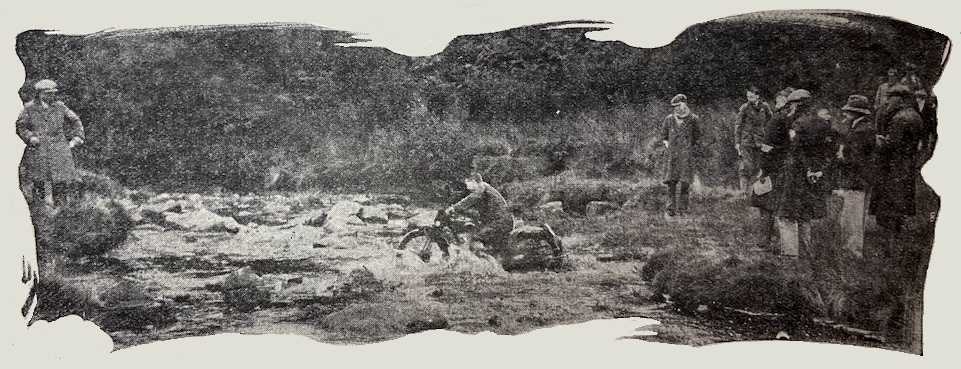
NT Bennett’s Douglas, which sounded weak in the carburation department, and Edyth Foley (494cc Triumph) likewise had not the revs that spell success. FE Thacker (248cc Ariel) made a good show past several stragglers, and. T Flintoff (493cc Sunbeam) only trailed his feet to pass those who baulked him. Alec Hill (298cc Scott) was the second (and only other rider) to prove that Doantby Rash was cleanly climbable. G Fletcher (497cc Ariel) made a noble effort to avoid a baulk, while JW Brigham (347cc Sunbeam) romped up splendidly with slight touches. The Scottish contingent were having a rough time, for Andy Pattinson (248cc Ariel) had terrific wheelepin, and R MacGregor, appearing for the first time on a Rudge, had to step off at high velocity—an act which he performed very gracefully. Another noble effort to avoid baulks was S Flintoff’s (493cc Sunbeam) performance, but TR Walker (493cc Sunbeam) was equally deserving but less fortunate, for JC New (495cc James) turned completely round in his track. After the ascent of Doantby Rash the course led on to the moortops and the much-discussed fast section, the railway track, was reached. Deceived by cleverly faked photographs, the competitors found that what they had thought was a broad-gauge railway track was in fact a disused narrow-gauge tramway connected with a derelict lead mine. Earth ballast between the sleepers had fallen away, and machines banged and clashed from sleeper to sleeper—some successfully, and some to roll off the top of the embankment into the boggy heather. Miss Edyth Foley’s magneto gave out here, and she had a mile to push to reach a main road. The railway track was best summed up by F Swires (347cc Sunbeam), who stopped to enquire of the direction marshal, in most grieved tones: ‘Who the dickens troubled to find that lot?’ The clashing of forks rent the air, stands fell off, saddle tops dropped off as riders were jolted upwards, tool bags suddenly opened and spilled their contents. Altogether a nasty business. Pockstones Moor came next, and at Hey Slack Gabriel (Triumph) gave up an unequal contest, and was joined by Miss Foley, who had trouble again and accepted the offer of being towed back to Ilkley. Hoodstorth splash claimed its full quota of failures. Both Jack Williams (Rudge-Whitworth) and Bert Kershaw (248cc Ariei) measured their lengths in the stream; Kershaw, however, stepped off the more gracefully! W Evans (348cc Triumph) and G Elliott (499cc Rudge-Whitworth) were the only two riders to go through clean, although N Walker (247cc Excelsior) and WG Harrison (347cc Sunbeam) made excellent if slightly less successful attempts. Holme Gill splash eliminated T Gamble (348cc AJS), and Bramley Held was the farthest point reached by JC Edward (348cc Douglas). Cat Crags, that terrific ascent through mud, bracken and rocks, eliminated J Rudd (346cc Royal Enfield), D Smallwood (348cc Calthorpe), and RF Shaw (348cc Cotton). Povey (Rudge-Whitworth) still led the way and made a fine climb, and CM Harley (Matchless), BJ Jenkins (Triumph), L Ellwood (248cc Ariel), E Damadian (248cc Ariel), GE Rowley (498cc AJS), W Milner (347cc New Hudson), de la Haye (346cc Levis), VN Brittain (493cc Sunbeam), E Williamson (346cc Levis), JA Hudson (248cc Ariel), TE Flintoff (493cc Sunbeam), and HS Perrey (248cc Ariel), all made clean climbs of the worst section. All of there were early arrivals, then came at least twenty people who had to use their feet more or less—mostly more. Next ME Crosland (348cc Velocette) made a clean run, followed by a lot more semi-failures, relieved by Bert Kershaw (248cc Ariel), who was astoundingly fast considering the size of his model. JC New (496cc James) showed how a Southerner can tackle the sort of stuff that looks like Camberley, and his fine upward flight was only checked by a wild plunge into the bracken. Then came Graham
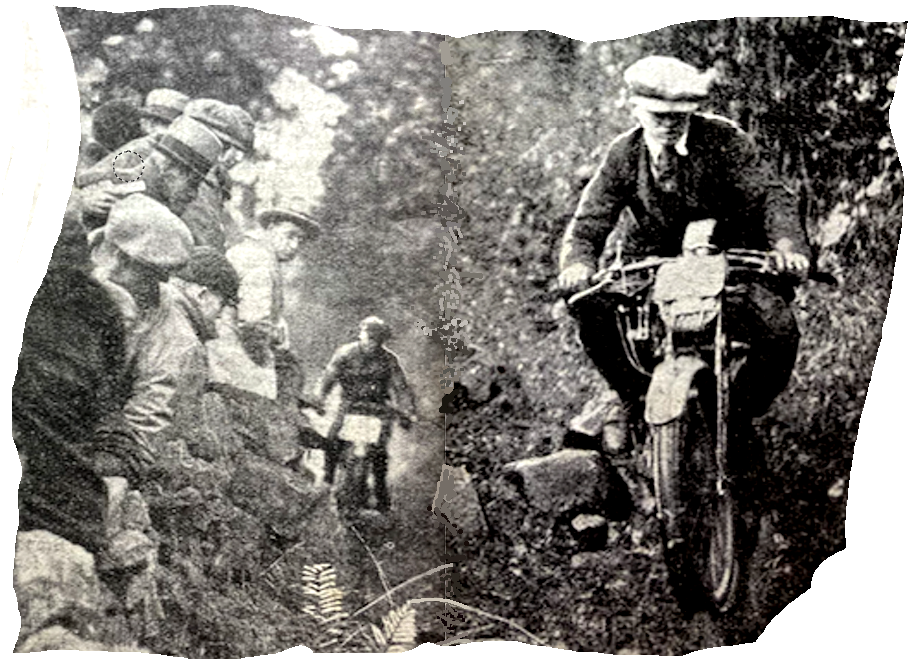
Goodman (348cc Nortim) at terrific speed. The AA man, who was directing ‘traffic’ was evidently making his first acquaintance with Graham’s methods. He was a quick learner and jumped like a hare, what time Graham TT’d aloft, endeavouring to regain the time he had lost throughout the morning due to a repetition of seizures. Walter Hillas (248cc Ariel) made a good show, but his chain came off at the top. There was scarcely the usual precision in the coffee slop arrangements, and JA Hudson (248cc Ariel) unfortunately hit a flock of sheep between the checking point and the hotel, damaging his head and his summer suitings about equally badly; after bandaging the former he pluckily carried on to a successful finish. After the coffee stop the route passed out of the ken of all but the riders themselves. Denton Moor—’five miles of frightfulness’ (as the programme said)—was generally agreed to be less frightful than of yore, but retirements were more and more frequent. E Damadian (248cc Ariel) and A Hill (298cc Scott) missed a route direction and so were automatically retired. H Fearnside (490cc Norton) lost his electrical energy; D Buckingham (346cc New Imperial), WW Hey (499cc Rudge-Whitworth), and G Ashon (348cc Velocette), also got no farther. George Rowley (498cc AJS) knocked an oil pipe off and suffered a puncture; he, too, retired. Another half-dozen people retired in the late stages and so missed the two circuits of Jeffsfynde, that stone-strewn galley that is the last sting in the tail of the event. A Jefferies (298cc Scott) had had two punctures to repair, J. Williams (499cc Rudge) had had a chain break, and WM Mason (596cc Scott), having pulled a tyre valve out, cut his tyre away and did the last ten miles on the bare rim. Povey was the first finisher, at a little after 1pm, but J Williams (Rudge-Whitworth) and GE Mines, on his two-speed Scott, were early arrivals, closely followed by TE Flintoff and VN Brittain on their Sunbeams; obviously the zero time lay amongst these stalwarts. MacGregor (Rudge-Whitworth) finished without bearings in his front wheel, and M Greenwood (346cc New Imperial) fell as he crossed the finishing line and was so relieved to find himself laid on the smooth grass that he stayed there. R Baron (172cc OEC) finished very late, and called to a certain scribe (who has carried ‘No 1’ on occasions) : ‘You see, I started first and can finish last, too!’ One by one the troops came home, and never has such a number got through: riders were fresh—even Miss Everitt (247cc Baker), the only girl to finish, was quite happy—and machines were perhaps less battered than usual. Footrests, mudguards, and number plates were generally the worse for wear, however. THE RESULTS. Awards Based on Time and Observation. Alfred A Scott Memorial Trophy (star performance, time and observation): VN Brittain (493cc Sunbeam), l1 marks lost. Raymond Bailey Trophy (second best performance: TE Flintoff (493cc Sunbeam),15 . Yorkshire Evening Post Rose Bowl No 1 (third best performance): GE Milnes (596cc Scott), 20. Yorkshire Evening Post Rose Bowl No 2 (best Northerner): C Helm Jnr (493cc Sunbeam), 25. Herbert Payne Trophy (best Southerner) W Evans (348cc Triumph), 31. Hepworth and Grandage Cup (fourth best performance): A Jedffries (299cc Scott), 28. Folbigg Cull (for best Scott rider not connected with makers): J Binns (596cc Scott), 54. Special Prize (for best performance by a lady): Miss Norah Everitt (247cc Baker), 131. Awards on Time Only. President’s Rose Bowl (best Performance against standard time): TE Flintoff (493cc Sunbeam), no marks lost. Raspin Rose Bowl (runner-up): J Williams (499cc Rudge-Whitworth): 1. mark lost. Frank Hallam Tankard (third) GF Povey (340cc Rudge-Whitworth): 4.
You’ll have noticed the reference to Denton Moor as ‘five miles of frightfulness’; it clearly had a lasting effect on this competitor…
ON DENTON MOOR.
My bike is bust, it will not go
On Denton Moor.
Both footrests went some time ago
On Denton Moor.
When the Yorkshire hills are clad in snow,
And the lads are riding in the Exeter show,
I shall still be wandering to and fro
On Denton Moor.
In this Scott Trial I showed some fight
Till Denton Moor.
But every rock my crank case hit
‘Twas dented more.
I crashed through bracken left and right,
My gear box screamed, and well it might,
And so did I, such was my plight
On Denton Moor.
My silencer soon came away
On Denton Moor.
I’ve left the bike some times today,
On Denton Moor.
And rocks and stones and dirt and clay
Have filled my mouth as there I lay,
While the poor old ‘bus ploughed on its way, On Denton Moor.
I shout aloud, none hear my cries,
On Denton Moor.
The light gives place to darkening skies,
On Denton Moor.
Methinks I’ll lay me down and dies,
Till Judgment Day when all arise,
Perhaps I’ll get a special prize,
For Denton Moor.
JC
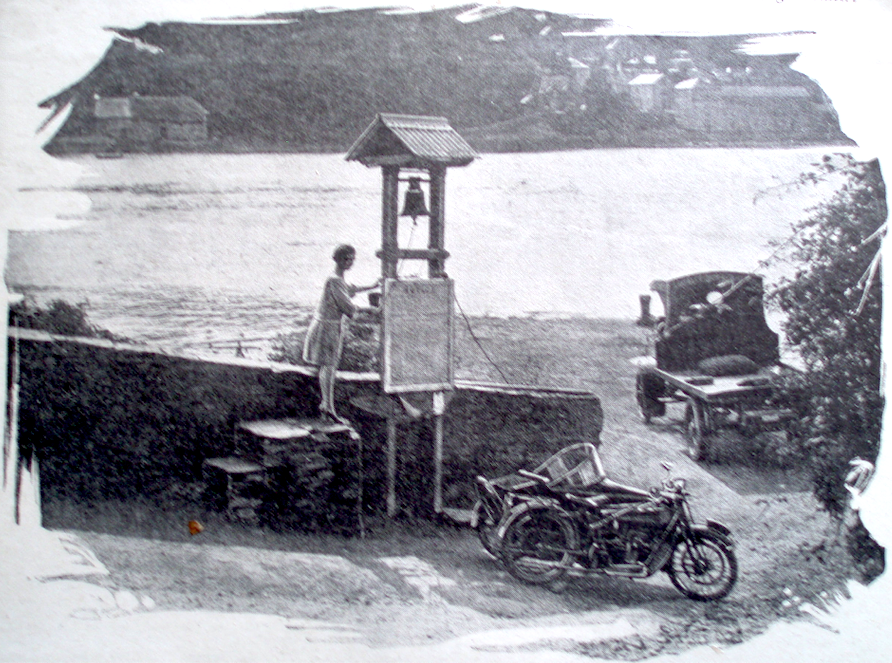
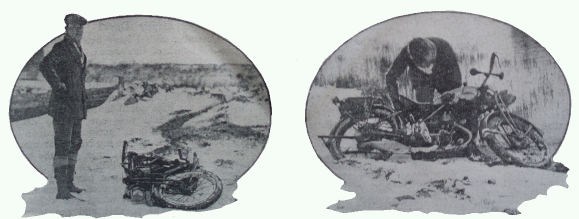
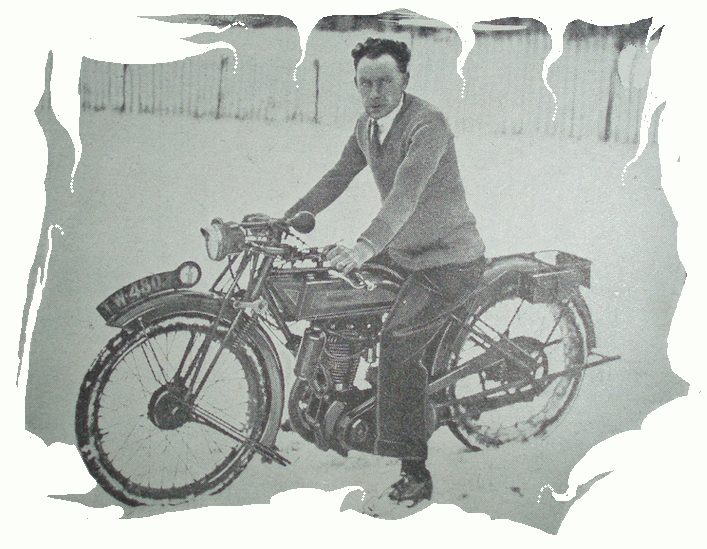
WE’LL HEAR MORE FROM Ixion anon but that reference to the Everyman Trial bears some explanation, for which we can turn to the Editor’s comment…
“A LONG CAMPAIGN ATTRACTING New Adherents. On all sides remarkable support is forthcoming for the ‘Everyman’ motor cycle trial, for which this journal has offered £500 in cash prizes. This support is extremely gratifying, because until last year The Motor Cycle ploughed a lone furrow in its demand for silent, easy-to-start, docile machines. Never did we allow lack of support to deter us from our set purpose, since it was becoming abundantly clear that the lines of motor cycle development ever since the War were such that in time the movement would inevitably become narrowed down to a purely sporting pastime. In short, the quest for speed involved ever-increasing weight and noise, and deterred many from joining the ranks. At that time-our insistent demand for silent and more refined machines was even distasteful to a number of motor cyclists and to manufacturers. But happily a change of feeling has come about. It is now apparent that our views are ‘widely held by riders, manufacturers, and by both the lay and technical Press. ‘We welcome this support, since it should do much to ensure the development, and ultimately the wide popularity, of ‘Everyman’ motor cycles.” Now firmly in ‘smug’ mode, the editor included extracts from past issues in 1924, 1925, 1926, 1927 and 1928 to prove his point, including a reminder that “it was The Motor Cycle which, urged a 250cc TT Race in order to foster the lightweight machine, and though the ACU would not at first organise a separate race for this type, our trophy was accepted and awarded in 1920 and I921…Later, in 1925, when phenomenal speeds were being attained with special fuels, this journal put up a strong stand against the use of non-commercial fuels, with a view to checking the development of purely racing engines in so-called touring machines…More recently, a 250 silencer competition was organised by The Motor Cycle in 1927 in a steady campaign against noise and with the object of making motor cycles more generally popular. Our main deduction was that multi-cylinder machines offered the greatest scope in the matter of silence, smooth running, and flexibility.”

“As an old motor cyclist dating book to Ixion’s earliest adventures, I read in The Motor Cycle with much pleasure of the enterprise shown by you to taking up the cudgels on behalf of our much neglected friend ‘Mr Everyman’. All sporting motor cyclists will commend you for this, because they will rejoice to know that, although ‘Mr Everyman’ may not appreciate the thrill of speed, he will enjoy in some measure motor cycling pleasures, on his daily run to and from his work, on his little utility bus. The yearly output of the ‘Everyman’ machine will, in time, far outnumber that of the sporting type, and mean employment for thousands of present unemployed, and add thousands of hours to the working man’s life, which may be spent according to the choice of his hobbies. Factories will be kept going right through the year at a steady rate instead of the violent fluctuations experienced by motor cycle manufacturers engaged in producing machines which are entirely unsuitable for winter riding.
AW CHATTELL“
“Your continual advocation of machines for the tourist and ‘general’ motor cyclist, and your emphasis of the danger of stagnation of design resulting from the ‘speed at any price’ policy, must have hearted considerably many men who, like myself, regard a motor cycle as a means of pleasurable and economical transport rather than as a sports outfit. There are two items in the very desirable ‘Renaissance;=’ of motor cycles, however, which I take the liberty of adding to those with which you have so exhaustively dealt: (1) The rendering of a motor cycle a compact unit instead of a collection of apparatus. (2) The adequate provision for the carriage of luggage, etc. Those who traverse bush roads in summer need no reminder of the enormous amount of work involved in keeping the machine tolerably clean, and when removing caked red dust from innumerable ‘dirt traps’ we sigh for a clean crankcase-gearbox-magneto-oil pump which could be wiped bright with the minimum of inconvenience…Now providing provisions for the carriage of personal luggage…My ideal equipment…would be…The carrier to be built well forward so that the front cross member may be used as a hand-rail by the pillion passenger, and also that the maximum weight may be over the centre of the wheel. Brackets to be welded to the side stays for the optional attachment of large metal pannier bags.
TRUSTY T, New South Wales.”
“I note with great pleasure that you are offering a substantial prize through the medium of the ACU for the development of a utility or ‘Everyman’ motor cycle. As a designer I am naturally much interested in this, and wish the project every success.
TH JONES, OK-Supreme Motors Ltd.”
“May I be permitted to compliment you upon your initiative in the matter of the proposed ‘Everyman’ motor cycle? I believe that the step you have taken is of vital importance to the manufacturer, and, above all, to the would-be driver of a motor cycle…I believe that an entirely new public would adopt motor cycling for business and pleasure if a trial were conducted to develop and to measure all these items of conduct. Comfort is a part of efficiency, and may be defined as the absence of the unintentional. It would be very amusing were you to offer a prize for the reader who succeeds in placing, in the most popular order, such features as springing, silence starting, weight, speed, cleanliness, hill-climbing, and reliability.
AM LOW MIAE, etc.”
ARIEL BOSS JACK SANGSTER wasn’t short of talented designers: Val Page led a dream team including Edward Turner and Bert Hopwood. Having won the Maudes Trophy for two years running Ariel stayed in the limelight when Harry Perrey and FE Thacker crossed the Channel in three-and-a-half hours aboard a 497cc Ariel ‘amphibian’. They must have enjoyed themselves as they immediately rode back again.
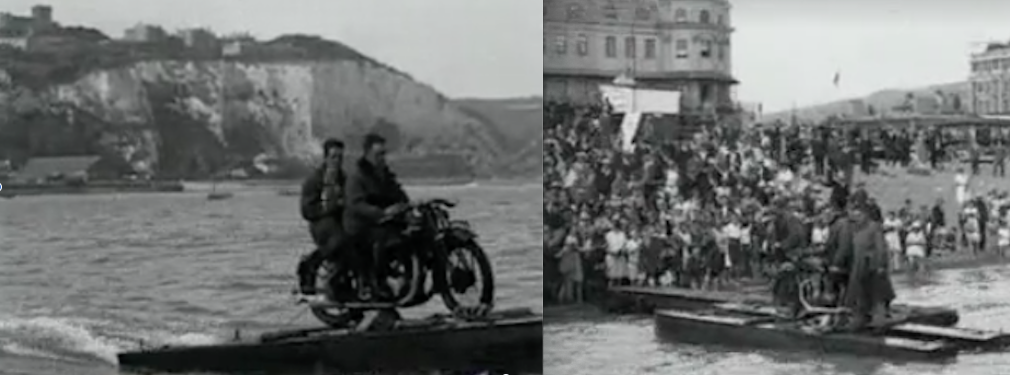
THE ITALIAN OPRA (Officine di Precisione Romane Automobilistiche) boasting the motor cycling world’s first dohc transverse-four lump, was raced at the Belfiore circuit in Mantua by Italian champion Piero Taruffi. He led the field until the penultimate lap when the engine blew up, as it had in its 1927 debut.
DANGEROUS DRIVERS IN BUCHAREST risked being handcuffed and paraded through the streets with signs round their necks reading “BAD DRIVER” (or, this being Romania, “ȘOFER RĂU”.
THE AA REPORTED THAT traffic outside major population centres had risen by 12% in the previous year—and by 500% in six years.
THE WALL OF DEATH followed speedway into the UK; the first venue was the Kursaal Amusement Park, Southend-on-Sea. And the first star of the new attraction was Tornado Smith from Boxford, Suffolk, starting a Wall of Death career that would last until the late sixties by which time he had ridden thousands of miles horizontally, often carrying a lioness in his sidecar. Mrs Smith rode the wall too, under the stage name Marjorie Dare. Rather than Spandex, bespectabled Tornado rode in brown riding boots, grey trousers, white shirt and tie, plus a black beret with a skull and crossbones badge. Reflecting the stunt’s American roots, for many years Indian Scouts were the bikes of choice.
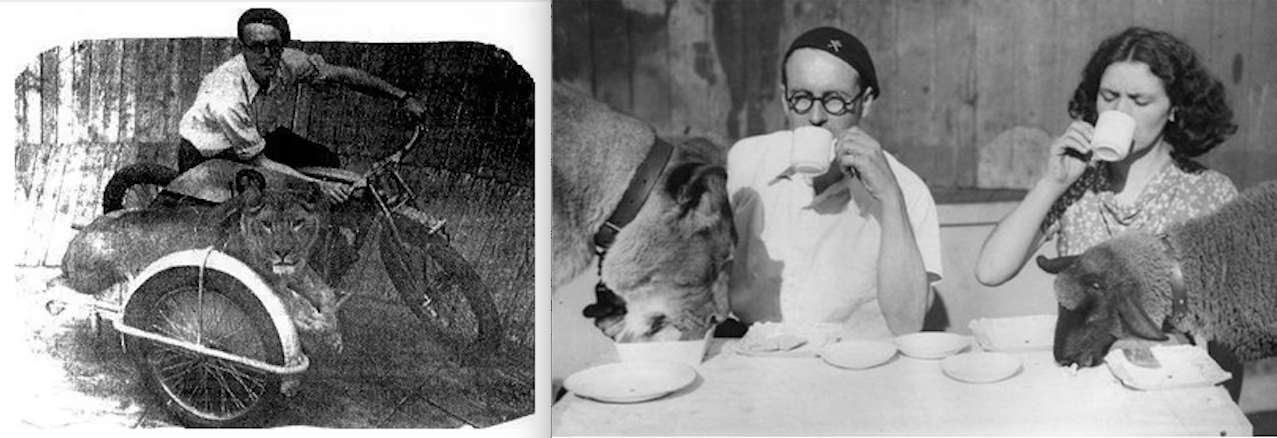
“A DROP IN THE SOUTHERN OCEAN. The number of motor cycles registered in New Zealand at the end of last October was 38,710. The number of machines in Indo-China is about 15,00.”
“A DIFFERENT ROAD RACE RECORD: The equivalent of 217 miles of all-concrete road were laid in the British Isles during 1928, and this constitutes a record in this country for any one year.”
“NOW LONDON WANTS TO PLAY! Automatic traffic control is to be tried again at two points in London. Red and green discs will be used, and there will probably be semaphore arms raised and lowered like railway signals.”
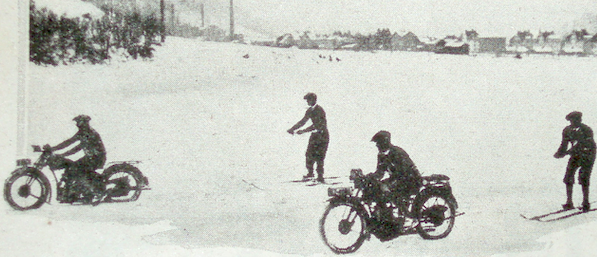
“WHY NOT BRITISH RIDERS?’ British machines will be used by three Swedish motor cyclists who will shortly start an expedition from Stockholm to Capetown.”
“WEST (VERY EXPENSIVE) RIDING. Motor cyclists will be sorry to hear that the cost of providing traffic police in the West Riding of Yorkshire amounts to £20,000 a year.”
“OCH, OIRELAND! ‘It was very wet in the Midlands on the night of 27th-28th December, and this may have accounted for the large number of failures in the London-Exeter Run.’—An Irish paper.”
“SWAN SON (PIANISSIMO). Every evening, it is said, there is a noise trap in operation between Fair Green and ‘The Swan’, Mitcham. It is therefore inadvisable to employ the loud pedal in this vicinity.”
“OF COURSE (TWICE). During 1928 over 10,000 cases were dealt with by the RAC ‘Get you home’ service, and this, of course, easily constitutes a record. The majority of the breakdowns occurred to motor cars.”
‘HE’S AN AIRMAN. Another TT winner has joined the ranks of ‘plane owners. WL Handley, true to his tradition, has purchased a ‘hot’ single-seater—an SE5A. This machine previously belonged to Mr Will Hay, the comedian.”
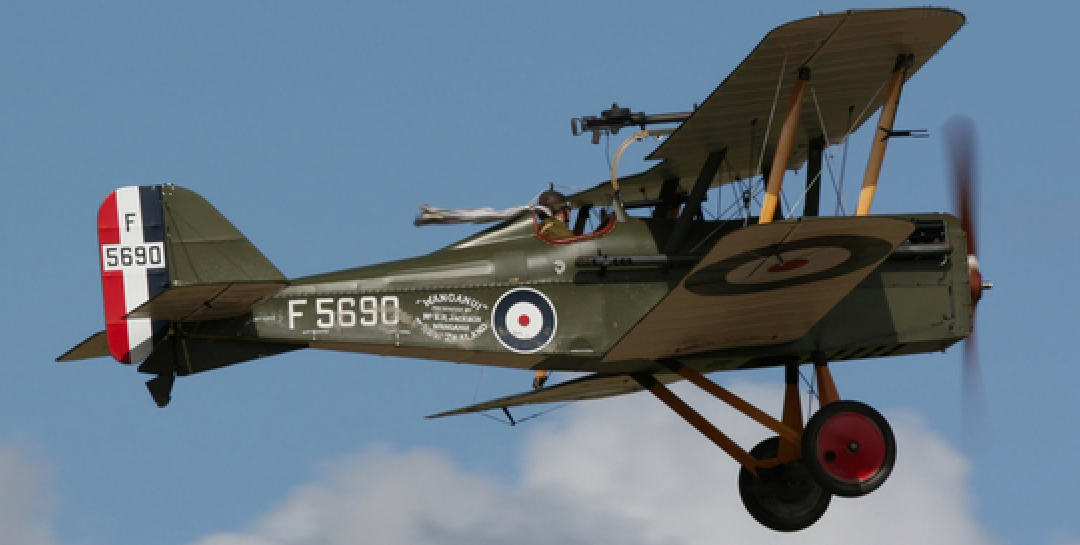
“THE BRAKE. In Spain now motorists are imprisoned for not less than six years if they knock a man down, and for not less than twelve years if they kill him. This is an inexorable rule. There have been no motor accidents in Madrid since the law came into force on New Yard’s Day [three weeks before].”
“THE CHOICE: BLIND OR UNABLE TO SEE? A correspondent in a daily paper says that the best way to guard against blinding headlights is to wear sun glasses while driving at night.”
“ABOUT TO BE BY-PASSED. Coventry is the latest city to be by-passed, and Shrewsbury has also decided to fall in line.”
“SILENCE! Motorists in Calcutta, under revised regulations, may not use cut-outs, exhaust whistles, sirens, electric horns, or noisy applications of any description.”
“THE ASSOCIATION OF PIONEER Motor Cyclists is holding an innaugural rally and Social run…Prospective members are reminded that to be eligible they must have owned or driven a motor cycle or quadricycle before December 31st, 1904, and must have held a motor cycle driving licence prior to this date. All right, grandpa!”
“BACK INTO HARNESS. There are one or two glimpses of motor cycles in the British war film ‘Victory’, and it is to the credit of the producer that he went to the trouble of obtaining WD Triumphs for the purpose. In one scene, however, he slips up, for a ‘P’ model—first made in 1925—is discernible.”

“‘AUSSIES’ DON’T CARE! The distance between Bendigo and Melbourne in the State of Victoria is 100 miles, and some time ago a solo Rudge-Whitworth carrying four men accomplished the journey and back again in slightly under eight hours. Subsequently the Bendigo Dunelt agent decided to make an attack on this ‘record’, with the result that a 249cc Dunelt has travelled, four up, from Bendigo to Melbourne and back in 5hr 59½min. The men who made the trip must have been rather heavier than the Rudge riders, for the Dunelt equipage weighed 63 stone, compared with the 41 stone of the Rudge outfit.”
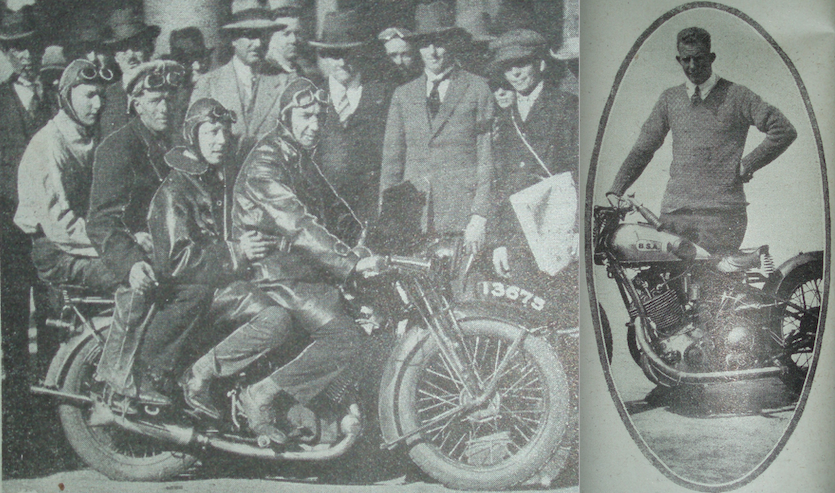
SEVEN 350S WERE SELECTED from AJS, BSA, Douglas, Francis Barnet, Matchless, New Hudson and OEC for evaluation by the Army. Before the tests were completed the War Office stepped in to set up a comparison between Douglas and Triumph, both of which had supplied successful DR bikes in the Great War. The Duggie L29 was selected over Triumph’s NL3 but orders were subsequently placed for BSA ohv V-twins and Matchless Silver Arrows.
NSU SENSIBLY STOPPED MAKING sports cars to concentrate on bikes, and for the first time it appointed an agent in Japan, as did Guzzi and BMW. They were competing with a new range of 350 and 500cc sv singles and a 500cc V-twin from the newly formed Japan Automobile Co (JAC).
WITH ONE EYE ON THE EXPORT market, Depression-hit Harley Davidson launched a 497cc sv single. The Japanese—biggest importer of Harleys after Australia)—persuaded Harley to sell them the rights, blueprints, machine tools to the obsolete 1,200cc twin’ with the loan of personell to show them how to set up a modern motor cycle production line. The Japanese learned about workshop cleanliness, precision manufacture of spare parts, assembly line operations; in short, everything they needed to mass produce motor cycles. The Harleys the Japanese company built were dubbed Rikuo (Continent King) and became the standard mounts for the Japanese army. The Japanese began adapting the machines for military use straight away, developing a combo with sidecar drive and plenty of ground clearance. Delegations from other Japanese factories visited the new plant.
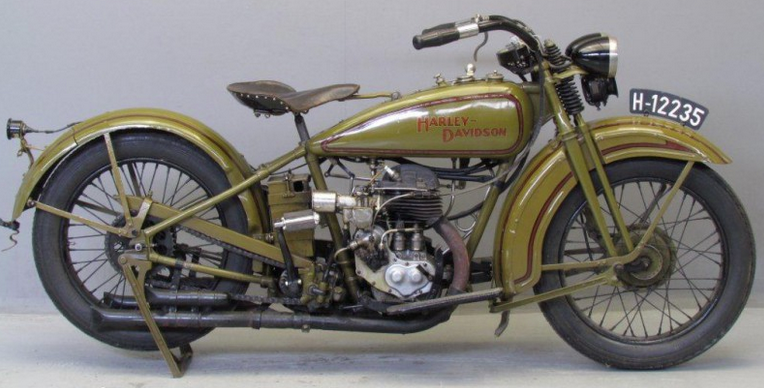
A JAPANESE CORK MANUFACTURER names Toyo Kogyo Co Ltd developed a 250cc two-stroke motor cycle and made six machines in its first year. Before long Kogyo changed its name to Mazda.
BERT LE VACK WENT TO Arpajon to raise the flying-kilometre world record to 12.83mph on his Brough Superior–his fourth world record and the last time it would be held by a naturally aspirated bike. But after seven years in British hands the record was snatched by Germany when Ernst Henne in a streamlined suit and lid, did 134.68mph on a supercharged 735cc BMW WR750—the first of his 76 land-speed world records.

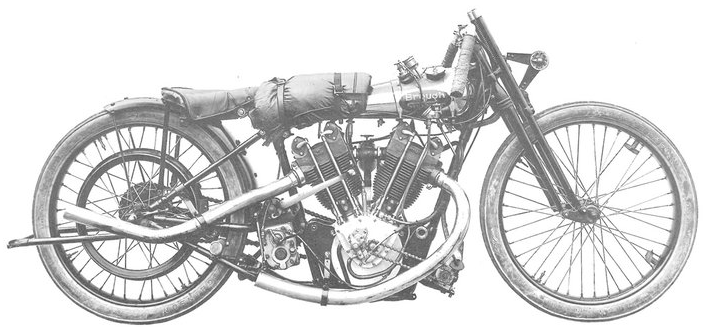
HERE’S A TT REPORT from the guru—Geoff Davison, editor of the TT Special and author of the definitive Story of the TT: “The most memorable race in 1929 was the Senior, in which Charlie Dodson repeated his success of the previous year. On this occasion, however, the weather was good and Charlie’s average speed was 72.05mph—the first time that a race had been won at over the seventy mark. Also—an interesting point—Charlie’s time was 32min better than his winning time in 1928. The race was notable, too, for the fact that Rudges were really in the picture for the first time since 1914. Tyrell Smith was the Rudge favourite and he led for the first two laps. Then he crashed at Glen Helen, to allow another coming star, Tim Hunt, to take the lead. Tim was delayed in the fourth lap, however, and Charlie Dodson came to the front to win from Alec Bennett, on another Sunbeam, by nearly five minutes, with Tyrell Smith less than a minute behind. It was clear that one had to reckon with the Rudges. ‘Why was your fourth lap so slow?’ I asked Tyrell. ‘ Slow!’ he exclaimed. ‘It was nearly a case of stop altogether! I had a lead of about three minutes, I think, when I came to Glen Helen on the fourth lap. It was a pretty tricky bead in those days and I took it a shade too fast. The exhaust-pipe touched the road and spun me round. I crashed into the bank, was winded and tore my leather, badly. They carried me into the hotel and pinned my clothes together. After a bit I got my breath back, but had a nasty pain in my chest. However, I came
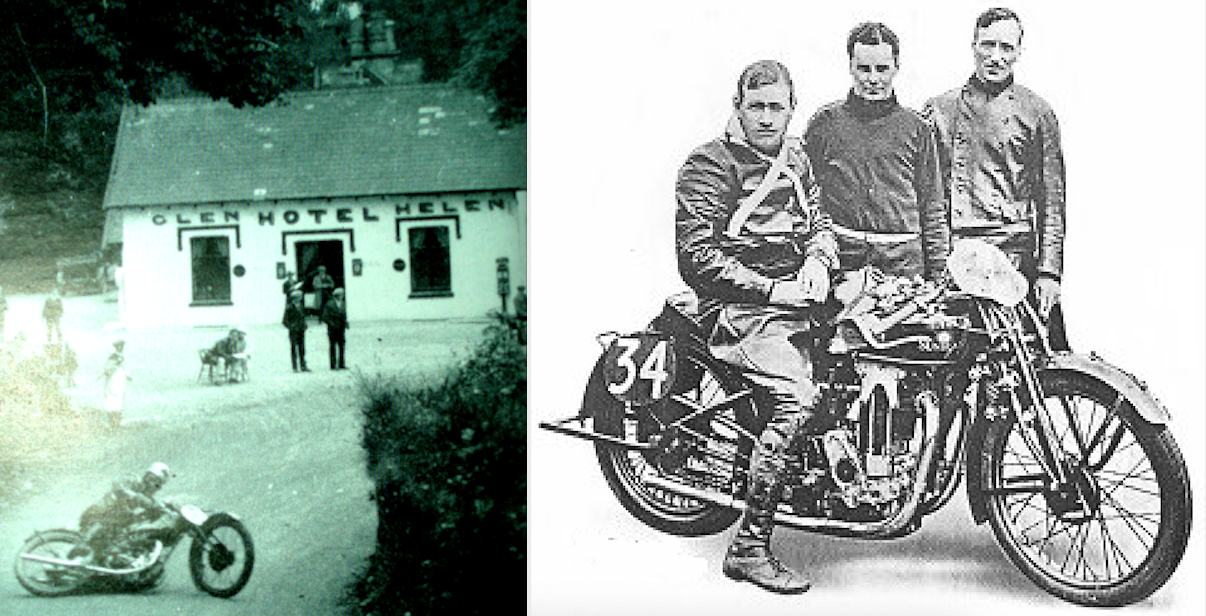
out of the hotel to see what was doing and found that someone—Bob McGregor, I think it was, but I was never quite sure for I was still rather dazed—was holding my machine up with the engine running and the clutch out, strictly contrary to regulations, all ready to move off! They sat me on it and, still very muzzy, I let in the clutch and carried on. I believe that the officials had more than half a mind to stop me and they would certainly have been quite justified in doing so, for it was discovered later on that I had cracked three ribs. I was very glad that they didn’t, however, for I was just able to carry on and I was very glad to finish third.’ [just 17sec/0.26mph behind Alec Bennett.] The Junior race resulted in another win for Velocettes—their third in four years—this time by Freddy Hicks, of Brooklands fame. Wal Handley brought his AJS into second place and Alec Bennett, also on a Velocette, was third [Hicks and Handley, of course, were both former TT winners]. Less than two-and-a-half minutes divided the first three men, as against over eighteen minutes in the Junior of the previous year. In the Lightweight race Excelsiors scored their first win, after a duel with the Italian Guzzi. Pietro Ghersi led until the end of the fifth lap, with Sid Crabtree 2in 40sec behind him. It looked like a safe win for Italy, but in his sixth lap Pietro broke down and Sid took the lead, to win by over five minutes from Ken Twemlow (Dot).” RESULTS: Senior: 1, Charlie Dodson (Sunbeam),3hr 39min 59.0sec, 72.05mph; 2, Alec Bennett

(Sunbeam); 3, HG Tyrell Smith (Rudge); 4, Percy [Tim] Hunt (Norton); 5, G Ernie Nott (Rudge); 6, Freddie G Hicks (Velocette); 7, AE Simcock (Sunbeam); 8, CW [Paddy] Johnston (Cotton); 9, Edwin Twemlow (DOT); 10, SP Jackson (Montgomery). Junior: 1, Freddie G Hicks (Velocette) 3hr 47min 23.0sec, 69.71mph; 2, Wal L Handley (AJS); 3, Alec Bennett (Velocette); 4, Charlie JP Dodson (Sunbeam); 5, Tom Simister (Velocette); 6, 0D Hall (Velocette); 7, Syd A Crabtree (Velocette); 8, 0K Burrows (DOT ); 9, Kenneth Twemlow (DOT); 10, JW Shaw (Velocette). Lightweight: 1, Syd Crabtree (Excelsior), 4hr 8min 10.0sec, 63.87mph; 2, Kenneth Twemlow (DOT); 3, Frank A Longman (OK-Supreme); 4, 0 J Sarkis (OK-Supreme ); 5, CW [Paddy] Johnston (Cotton); 6, SP Jackson (Montgomery); 7, Edwin Twemlow (DOT); 8, JW Whalley (Cotton); 9, JW Shaw (OK-Supreme); 10, H Lester (SOS). The mountain circuit was hard on men and machines alike—compare the number of starters and finishers, bearing in mind that the retirees listed here, and many not listed, were formidable TT competitors riding world-class motor cycles. Senior starters, 47; finishers, 16. Retirees included Pietro Ghersi (Cotton), Wal Handley (AJS), Ted Mellors (Norton), Jack Porter (New Gerrard), Jack Porter (New Gerrard), Jimmy Simpson (Norton), Graham Walker (Rudge) and Stanley Woods (Norton). Junior starters, 44; finishers, 16. Retirees included Pietro Ghersi (Cotton), Jimmy Guthrie (Norton), Tim Hunt (Norton), Paddy Johnston (Cotton), Ted Mellor (New Imperial), Jack Porter (New Gerrard), Jimmy Simpson (Norton), Ed Twemlow (DOT), Harold Willis (Velocette) and Stanley Woods (Norton). Lightweight starters: 33; finishers, 13. Retirees included Pietro Ghersi (Cotton), Wal Handley (OK-Supreme), Ted Mellors (New Imperial) and Jack A Porter (New Gerrard).
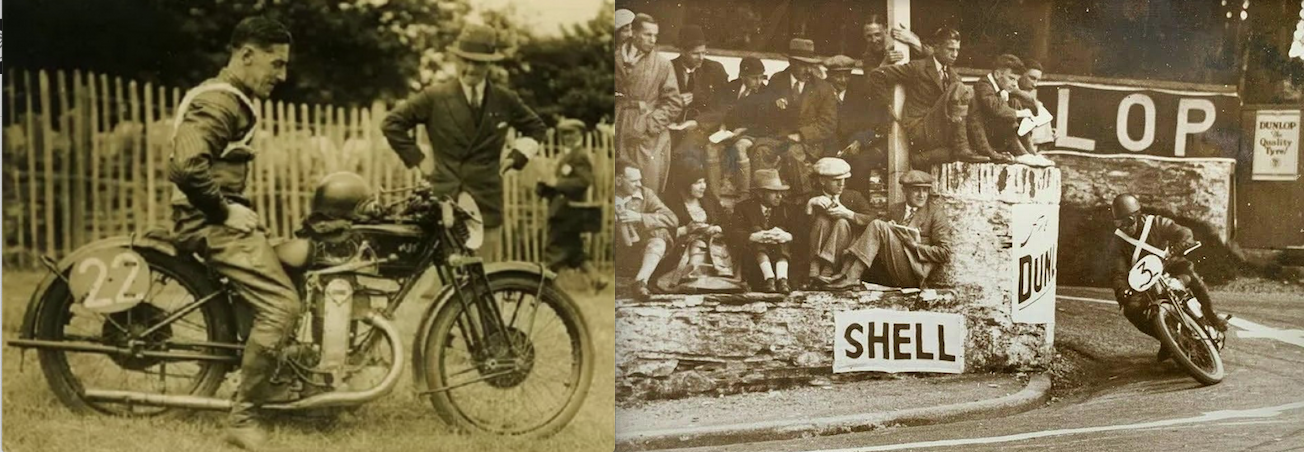
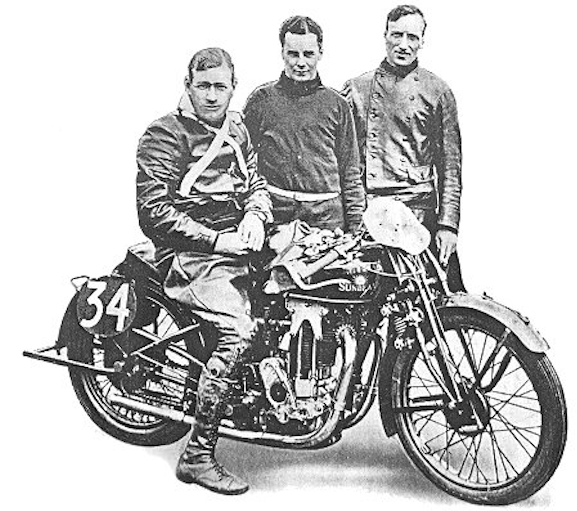
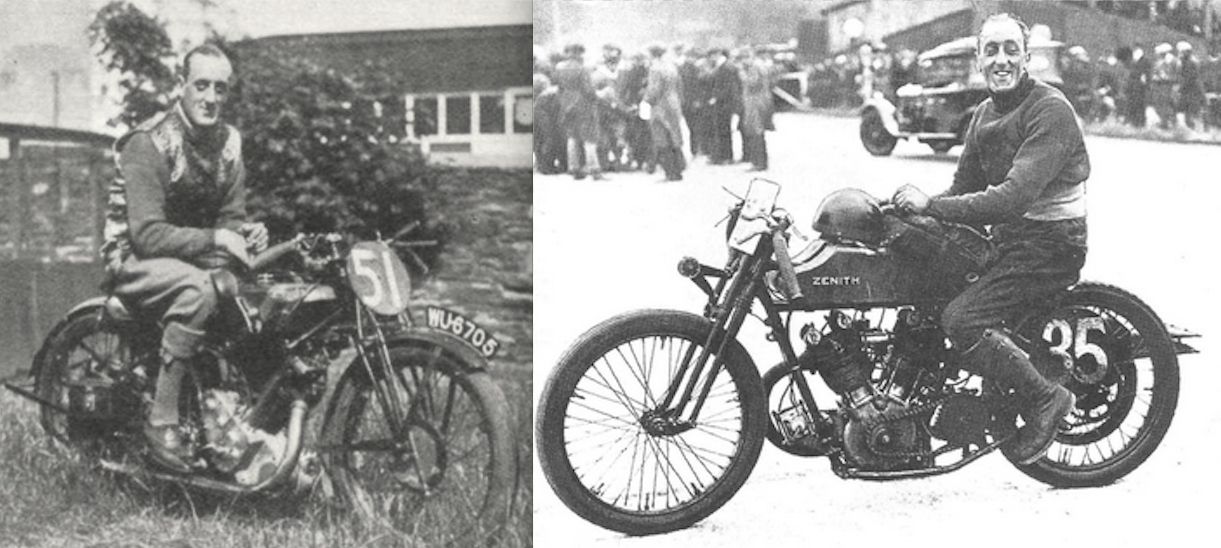
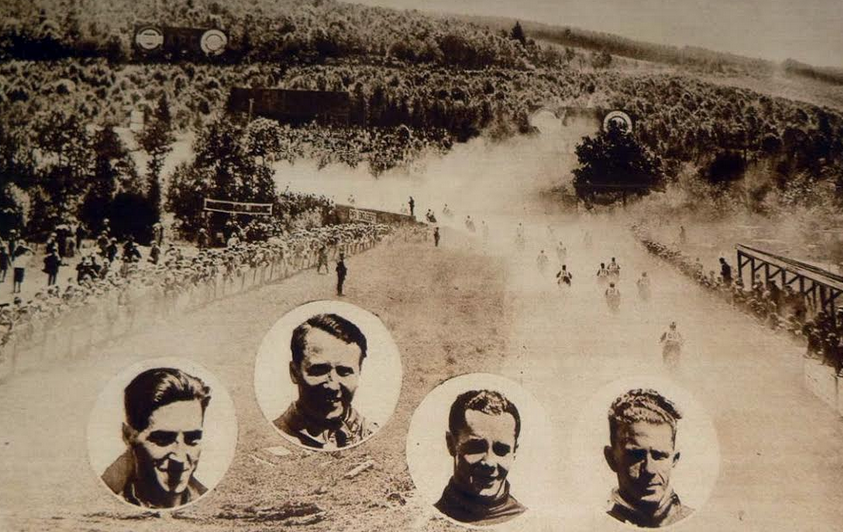
GRAHAM WALKER’S SENIOR TT was ended when his Rudge succumbed to a broken pushrod. But his blow-by-blow account of the race is an absolute delight—within a few years his gift for telling a great yarn would be put to good use in the editor’s chair at Motor Cycling. Gentle reader, you are in for a treat:
“The editor of The Motor Cycle has published articles dealing with the feelings and the methods of winners of various races, but he has now struck an entirely novel note in asking a non-finisher in the greatest of all motor cycle events—the Senior TT—to give his impressions. Possibly the best title I could give this article would be ‘The Unfinished Symphony’, or ‘The Tragedy of a Broken Push-rod’, but I have borrowed from horse-racing a title which conveys the impression I desire. I have, however, a strong feeling of dissatisfaction with this screed—it is similar to writing a serial, but with the exciting climax usual in a serial missing by force of circumstance. Some of you who read may get the impression that the TT is far from thrilling; believe me, this is not the case! It is simply that I have put down my actual thoughts during the race, and, as I am by nature a very ‘cold-blooded’ rider, the account necessarily lacks colourful excitement. It is impossible to convey in print my feelings towards the TT—they constitute an affection that is so deep as to amount almost to a religion. Well, it is the evening before the race, and the practising has been jolly good fun — the usual inevitably long working hours, the usual anxieties and spots of bother, the usual shortage of sleep; but all this has been more than compensated by the wonderful weather and the glorious feeling of being able to ‘blind’ to your heart’s content every morning on the most perfect road surface the IOM authorities have ever produced Yes, I’ve had a wonderful fortnight of riding, and—it is difficult to convey this feeling in words—I consider the Rudge-Whitworth crowd, consisting of George Hack, Tyrrell-Smith, Ernie Nott, Jim Dalton and Wills (affectionately known as ‘Gold-Flake’) the happiest and friendliest gathering it is possible to spend a fortnight with. And now I think a good night’s rest is indicated! Seven-thirty, Friday morning. Great Scott, it’s raining! If this keeps on it will upset a lot of people’s calculations. But there will be frantic excitement in the tent when we get the machines—hectic slapping-on of plasticine and oiled silk over magnetos, lowering of tyre-pressure, etc. Wonder if there will ever be a decent remedy for rain on goggles and the consequent misting on the inside of them? Must get dressed and swallow some breakfast. Nearly zero hour; we are all in position and the rain is falling harder. Have I got everything? Changed a plug m the tent before I was chased out; magneto waterproofed; tanks topped up with juice and oil; what about fork dampers?—Yes, they seem OK. Goggles cleaned and elastic adjusted; plug spanner in boot (not that I am likely to need it, as I’ve had no plug trouble in the practising); pipe in the other boot and tobacco in my pocket—feel I shall need that to-day, somehow. Now for the infernal wait—got 23 minutes to hang around after No 1. How I hate the waiting! Loud-speaker music seems a great improvement on the band we have previously had. Ah! there goes the maroon! Sounds as though the rain has damped its ardour a bit. Ebbie has dropped his fag, and off goes Charlie Dodson—and the second maroon, no advertisement to its maker! Move tip a bit in front there! Getting near my turn now—always feel like a Frenchman going to the guillotine during this starting business. Time for a final cigarette, anyway. Where’s my wife? Ah! there she is—the son and heir is apparently having a heated argument with someone behind him; no, he’s seen me and is waving—-Cheerio, son! On the front grid at last—petrol on; flood carburetter; bottom gear and wheel her back against compression. What’s the matter, Ebbie?…Don’t like my smoking?… This is a race?…Never! Well. to satisfy you, I’ll dispense with my cigarette, but you’ll be smoking that foul old pipe of yours in the timing box all the time I’m barging along smokeless. Besides, although a trifle ancient I’m still as nervous as a novice until the engine fires. ‘Five Seconds!—4—3—2—1—GO!’ Shove hard—it’s all downhill—she’s fired! Easy down Bray Hill—give the oil a chance. Careful for Quarter Bridge—easy to misjudge it the first lap…that’s all right. Now Braddon—very difficult this year; somehow I can’t get into the right-hand gutter as I used to, and that memorial stone on the left undoubtedly is stone! Union Mills, and an unknown friend waving—every year that chap is them, and yet I’ve never spoken to him. Engine feels very dud; is it my imagination or is it really fluffy? Always get this feeling in a race, so had better see it I can change up at the usual spots—that’s a pretty sore indication as to whether power is up to scratch or not. Hullo, there is that girl at the top of the Crosby rise—she is very faithful to the race; never a morning’s practice goes on without she is sitting on the bank. This year she has acquired a fiancé, judging by the way he has his arm round her! Now the downhill swoop to the Highlander, with the horrible jump that seems to twist the model all shapes in mid-air…Umph, it’s a lot better this year. Can’t think why more people don’t watch there. Very careful now—this is the worst bit of the circuit; in fact, the only really dangerous bit when wet—tree-lined and shiny polished tarmac instead of the wonderful non-skid type of surface all round the rest of the course. And now for Greeba Bridge…Easy now, the road is slimy…brake…change down to third…cut in to the left…easy…hello! 15, 32, 42, ivy torn off the wall and the kerbstone crashed; let’s see, 42 is Arnott, 32 is Lamb, 15 is Wal Handley…Someone was laid out—must have been either Lamb or Arnott, as I saw Handley standing up. Rotten luck in the first lap, too! Why didn’t the flagman wave me down? Ballacraine; and now for my old friend Ballig; more haste, less speed—down to third…Up!…Over…BUMP! The Glen Hotel; Creg Willey’s; and now we’re in Kirkmichael. Down to second (probably take it in third when I get wound up a bit). Lovely sensation, going flat out through the narrow village! Ballaugh (I don’t like it, and I respect it); the glorious blind flat out to Sulby; Ginger Hall. There is the crippled lady in the bath-chair; she has watched every practice and race since 1920. I give her a wave. Flat out now to Ramsey. Big crowds about to-day Third; brake…second; brake harder…first…into the gutter. Curse the footrests—hit them on the kerb! Up to second round the Picture Palace (just missed the kerb)—and up May Hill. Hello, where is the Sunbeam signalling station? Not in its usual position. It’s all right, flagman, don’t get agitated—I know the corner is bad! (He looks like a bull-fighter with his red flag.) More fast bends, and now the magic hairpin. Looks as though the tar is melting—no, it’s just the braking marks. Third; brake hard…second…first. Clutch in hand—get straight before you open up…Good! The Gooseneck (with its conscientious old flagman); the wee bridge; change down, up to third, and then really wind it up. Where is my private signalling station? Ah! I’ve seen yon—next time round I shall get my approximate first lap time. Now we’re well on the heights and—Curse, here’s the mist! Steady…slow up, or I’ll be into the Shepherd’s Hut bend too quick. Ah! here it is…hate that corner. The tricky
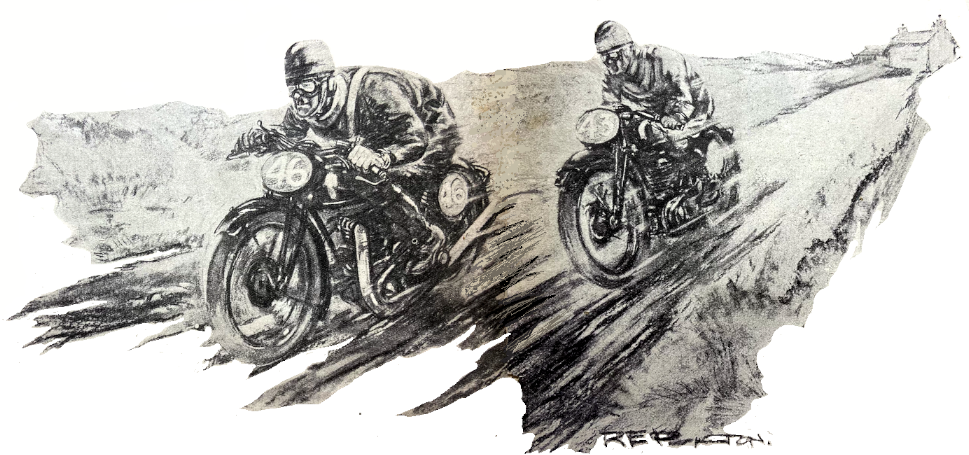
bridge at the 30th milestone—where is it? Curse this drifting mist! Ease up…there’s the John Bull milestone. Mist getting thicker; careful for the Bungalow—can’t see it, mustn’t lift my goggles. Where’s the red mark across the road?…There it is—blessings on the man who thought of the idea. Bump! over the tramlines. That’s better, the mist is rising. Very carefully through the second mountain gate. Here’s the mist again; awful pity—as it is drifting so much it means some riders will get it worse than others. Where is Windy Corner? Where is it? Oh help, here it is!—brake hard…All right, there is plenty of room to skid…Round, and we breathe again! Must give my goggles a wipe before the accursed 33rd milestone comer…here it is…all in order. Can’t miss that bump before Keppel Gate however I take it. I’m through the gate. Now were moving: Craig-ny-Baa—brake hard just before the white patch…hard!…harder!! I Change down! Curse!—missed the gear—kick it—hard! Round! Funny thing how you can hear your name shouted on this corner and on no other—must be the comparatively slow speed. Now to Brandish Corner, like blazes; round with an inch or two to spare. Hillberry—lovely swooping sensation that is! Ease early for Signpost, it’s deceptively downhill. The Nook—too slow there. Governor’s Bridge; what a battery of cameras—great temptation to charge them. Mind the skiddy bit at the bend; Glencrutchery Road; the Pits. Wills, as I pass, has his mouth open and looks startled—I must have gone a bit quicker than was anticipated. Flat down Bray—gird up your loins—hold it…Managed it! Quarter Bridge; Braddon (no faster there, my lad, or you’ll buy it—toes touched well and truly); Union Mills (I was slow here last lap)…Great Scott! That’s much too quick! Landed all shapes, and in the gutter at that! Bet that startled my unknown friend; it certainly startled me, and a wobble always looks worse to a spectator than it feels to the rider. Engine seems to be much better now, and I’m changing gear at the usual marks. Must have been my nerves and imagination which caused the apparent lack of power in the first lap. Wonder what has happened to Jimmy Simpson—I expected hint to pass me at the end of the first lap; something must have bothered him—great pity if both he and Wal Handley are out of the running. Crosby; the Highlander Inn; Greeba; Ballacraine; Ballig (I see that chap with the vivid red hair is here again. He is a regular spectator at all the races); the Glen; Creg Willey’s; Kirkmichael (settling down now, and it doesn’t seem so long between the different planes); Ballaugh- (slow here last lap; that’s better—just missed the cottage and did a reasonable jump); Sulby Straight (getting deaf—wind pressure always affects me): Sully Bridge. Ramsey already—shan’t attempt the gutter this time…that’s better! Ah! there’s the Sunbeam signalling station, on the other side of the road this year. George Dance, Mr Bowers and that wonderful timekeeper, Jimmy Beck. Pity the TT is not a massed start affair—soulless job, racing against the clock. Charlie Dodson and Alec Bennett are in the first four, and I’m 46 at the other end of the list ; besides, I have a bad tendency to slow down at times when there is no one to scrap with. Come on, less reflection and more attention to the job! Here’s the hairpin; and the Gooseneck, and Father Flagwagger still active. Wonder what the mist will be like this lap? Ah! I’m due for a signal this lap—where’s the signalling post?…’32’—that means my standing lap was between 3min 30sec and 32min—faster than schedule. I’m filling at the end of this lap so shall get some news. The first gate. Oh! curse the mist. Slow down, mind the Shepherd’s Hut…that’s better, I can see the Bungalow. Hullo! who’s this in front? Thank goodness for a break in the monotony and someone to scrap with. The second mountain gate…looks like Longman . Windy Corner … 43I—Yes, it is Longman. Can’t pass him .safely on this section. ‘Get over, Frank!’ (Don’t be daft, of course be can’t hear you.) KeppeI Gate; now flat on the tank and pass him before Craig-ny-Baa. That’s done that. Now for the corner; don’t brake too late…just managed it! Brandish; Hillberry; Signpost; Governor’s Bridge; the Straight. Get petrol and oil caps open—ease up—change right down—carefully up to the Pits. There is Ernie Nott just leaving. ‘Petrol, quick! Can you get at the oil-tank. Flake? What’s that, Hack?—one, too, three?—don’t get you…Rudges first, second and third?…excellent! Where am I…Second? Thirty-one forty-nine standing lap? Right; no drink, thanks; oil cap shut? Cheerio! Go on, shove harder…we’re off ! How dud the model sounds after a pit stop! Due to deafness, I suppose. Quarter Bridge; steady, I’m wide…I’m round. Must be careful after filling up—it takes time to settle down again. Braddon; Union Mills—that’s better, no ‘rough stuff’ this time.
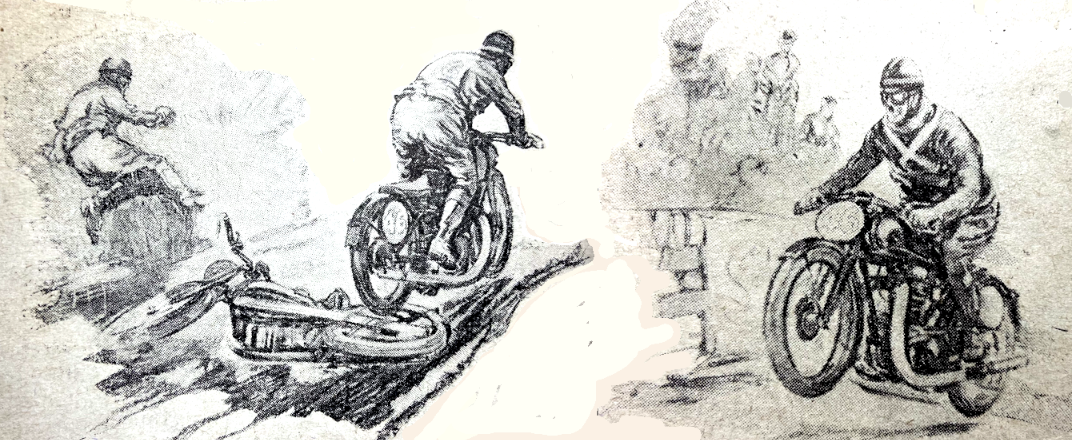
Curse the petrol, must be coming out of the filler cap vents—makes me feel sick and mists my goggles; mustn’t sit up, though—too much wind resistance; happy thought, slide forward a bit—that’s better. Greeba; gee, that broken kerb and torn ivy look unpleasant. Ballacraine; Ballig; someone touring in front. Get on your own side, man; get over, for heaven’s sake; how on earth do you expect me to pass you? Oh, curse the man! Go round the wrong side and risk it…that’s done it. Kirkmichael; Sulby (they slip past quickly now the job is well on the way); Ramsey; the Gooseneck. Shall get my second lap time now. What’s that? ‘31.30.’ That means between 31.00 and 31.30—not too bad. Third lap will be slower, though, as it will include my filling time at the end of the second lap. Oh, help! it ,will be longer than I anticipated—the mist is coming across again. It’s here; it’s like a blanket. Now a crawl to the Bungalow—mind the bank. Oh, clear away, mist, and give me a chance! Or is it like this for all of us? Steady, here’s the second gate. At last—Windy Corner, 33rd milestone, Keppel Gate, and daylight. Funny thing how we can ride with one hand, wiping one goggle continuously with the other hand. Wouldn’t do that normally for all the tea in China at this speed. Craig-ny-Baa. Leave it a bit 1ater on the brakes—must make’ up time now!…That’s all right. Brandish; Hillberry; Signpost; Governor’s Bridge; the Pits. Sixth? Great Scott, things most be close if my pit stop has dropped me from second to sixth. Yes, Bray Hill is decidedly good fun ‘all out’ this year. Someone’s had a beauty at Quarter Bridge—tar in all torn up. Braddon Bridge—can’t get that gutter at all. Ballacraine already—wonder where Ernie is? He can’t be far away. Don’t think I can manage the Glen much quicker—I seem to be using all the available space. Perhaps I’m a bit tired; usually feel it fourth lap and then get ‘second wind’. Kirkmichael; Ballaugh; Sulby. Feeling fit again now. Must make up time—come on, my lad, pull your socks up! Let’s see, I’m due for a fill-up again at the end of this lap. Very lonely existence to-day; either everyone is going the same speed or those that have broken down have got off the road quick (it seems to he the thing nowadays to disappear promptly with a broken model—we never used to worry about that in the old days). Ramsey and up the Mountain again. Where is the signal for the third lap? Under 32 minutes—not so bad as I had anticipated. I’ll know more when I fill. No mist, apparently—thank heaven for that, as my goggles are sweating inside badly for some peculiar reason. Seem to be wafting round my old enemy the 33rd milestone bend all right to-day. Keppel; Craig-ny-Baa; crowd are shouting and seem pleased; wonder what it’s all about? Perhaps I have picked up a place or two. Brandish; Hillberry; Signpost; Governor’s Bridge. Get caps opened again—change right down—goggles up. Hello, there is Ernie Elling again. Steady…nicely. ‘Quick, the hose…Can’t hear you, Hack. Dodson leading me by approximately 30 seconds? Has he got to fill again?…Yes?…Right! No, my goggles are OK—Cheerio!’ Shove hard (knees seem stronger than in the second lap fill)…we’re off! Well, that’s over half-way. Now some clear thinking is indicated. I’m thirty seconds down, but have finished filling. Charlie Dodson has to fill again—(careful! Here’s Quarter Bridge)—that means he will have a standing start to his sixth lap—(Mind—here’s Braddon). I shall have flying sixth and seventh laps, all being well. Time? I’m apparently doing under 31.30 and have not yet had a flying lap—let’s see, first lap standing start; second, coming in to fill up; third, standing start ; fourth. corning in to fill ; fifth, standing start. Should mManage under 31 for the sixth and seventh laps. Anyway, it will be close. Must squeeze out a bit more speed by later braking and squeeze myself out a bit more on the model. Ballacraine already? Ernie can’t be far away. Suppose to the spectators he and I most have constituted a good scrap, although I’ve never seen him except at the pits. Ballig—faster this time…Wallop! (that gave the forks. something to think abort). Glen Helen—up Creg Willey’s—the beastly right bend. Hello a woman holding a red flag over the garden wall and smiling amiably. What does it mean? Where is the flagman? Surely she would wave the flag if there was any danger. It’s queer, though; I’d better ease off…By Jove, I’m skidding…Oh! heavens, there’s a machine across the road…I’m broadsiding—feet down, quick! Hold it! Its poor old Ernie…I can’t miss his machine…He’s jumped for the bank…go for his back wheel…BANG!…I’m off!…I’m not—I am…No; I’m definitely not!
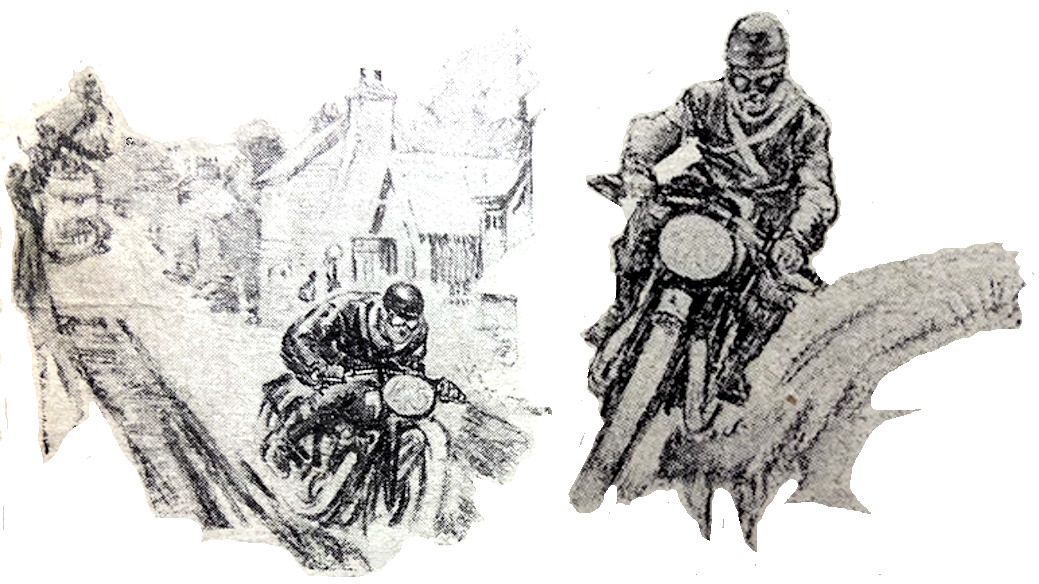
Loud cheers! That was a near do! Ernie most be all right or he could not have jumped like that. Amazingly treacherous on that corner. Must have been a local shower. The thought of a rider crashed round a blind corner has been one of my greatest fears for years, but, like most fears, it is not so bad when the actual experience comes. Still, I’m glad I was in second and not flat out in top gear! Come on, get on with it, there is thirty seconds to wipe off—what a pity it was not a massed start—Charlie and I would be in sight of each other at times if it was. Kirkmichael; Ballaugh (that’s got it to a fraction); Sulby Straight (flatter on the tank, arms in; that’s better); Sulby Bridge (a bit faster than before). Mind Temple’s Corner—rash to risk it there. All out round these bends and flat for Ramsey—BANG! What on earth is that? Most be the plug blown through the tank. Pull up quick, it may mean fire. Felt as though I’d been hit in the chest with a spent bullet. Good-bye to a win! Off, quick. No. it’s not the plug. Exhaust push-rod and tappet are missing, inlet push-rod is bent; tank is dented underneath—that must have been done by the tappet flying out. Ah! here’s a man running with something—half the exhaust push-rod. Thanks, very. good of you—interesting specimen, but a trifle expensive! Well, that has finished me—to-day there will be no exciting climax like last year’s Ulster Grand Prix, so far as I’m concerned, anyway. Two weeks’ practising—two weeks real hard work—many weeks of the Firm’s time (and much of its money) gone west. Another year to wait. And the motor going better than ever till the infernal push-rod saw fit to break. Still, it’s no use grousing, but I wish I could have had a flying lap, anyway. Where’s my pipe?…that’s better. Must get a message through to Elsie. Ah! here is Joe Sarkis pulling up. ‘What’s your trouble, Joe? No oil? Right; take some of mine if your motor will function. Here, sonny, get me a tin or something from that cottage. Give a message in at Ramsey Box for me, Joe; tell Mrs Walker, in the Grandstand—Block D, seat A1—that I’ve broken a push-rod and am walking into Ramsey and am all in order myself—Cheerio!’ This lady, hurrying, up, looks worried—hope she isn’t about to sympathise. ‘I’m sorry, Madam; this business makes me deaf; would you mind repeating it? DREW ME IN THE SWEEP?!!’ (that explains the worried look!) “‘Well, I’m sorry; if that’s the case, there are two of us unlucky to-day. You can tell your friends, however, that the money didn’t fall off; it merely faded away.’ Well, that is certainly one of my funniest TT experiences, and she seems genuinely annoyed with me, too! Oh, well, a hit of humour relieves the strain, anyway. Must try to find the missing piece of push-rod and the tappet for laboratory examination…There goes Ernie—so he is all right; and Freddie Hicks—his bus sounds beautiful. Can’t find the other pieces, so had better push the model to Ramsey. There goes Charlie—he must be leading comfortably; then Alec; and now Tyrrell…in nautical terms he is ‘showing his sternsheets’. He must have been off pretty badly, as I can see that his green corduroys are torn, exposing his white shirt. Poor kid is standing on the footrests, too, so he must be hurt. There goes Hunt; near as I can tell, Charlie is leading, with Hunt, Bennett and Tyrrell scrapping for places, and Nott well up. Warm work, this pushing. To-day’s pleasant thought: a large White Label with a very minute ‘splash’. Will call for George Dance and drink in good company. Ramsey at last. ‘What’s that? What’s wrong? Broken posh-rod—can’t be helped…thanks, just shove her in that shed—that’s fine!’ Hello! there goes Charlie on his last lap—excellent performance two years running. Well, here is the Sunbeam signalling station. . . . “Congratulations, Mr Bowers—a splendid performance. Alec second?—excellent! What about the team?…all right if Simcock comes round? Well, I hope he does, as ‘Digger’ is a good rider and a good sportsman. ‘What’s that? Mr Bowers will take me home in his sidecar? Excellent—many thanks. Well, cheerio, George, see you next year—and I hope see have as good a scrap again!'”
BERT PERRIGO WON THE inaugural British Experts Trial for BSA, which also launched a three-wheeler car powered by a modified (transverse) version of its 1,021cc V-twin bike engine. It featured reverse gear, electric start and front-wheel drive. More than 5,000 would be built.
REMINDING US THAT THE French could still build bikes with panache, Automoto came up with a sporty cammy single in 348 and 499cc and a twin-port 175cc twostroke featuring a separate oiltank and metered lubrication, as well as more conservative 250 and 350cc twostrokes.
THERE WERE 48 BRITISH MARQUES at the Olympia show, the same as the previous year. The Blue ‘Un noted that they “constitute the recognised standard by which motor cycles are judged in almost all parts of the world”. But it warned against any complacency, “especially in view of the progress which other European countries are making in motor cycle design”. Germany, Belgium, France and the USA had bikes on show. Matchless drew crowds with a 400cc narrow-angle (26º) monobloc V-twin, the Silver Arrow. It wasn’t fast, but it was smooth and comfortable, with a remarkably modern looking cantilever sprung frame.
AFTER FOUR YEARS IN England the ISDT moved over to the Continent. From Munich the route passed through Austria, Switzerland, Italy and Switzerland to a final speed test in Geneva. The editor of The Motor Cycle concluded: “Men in the competition movement are apt to describe each succeeding Six Days International Trial as the worst ever held. Be that as it may, the Six Days International Trial, which concluded at Geneva last Saturday, must be characterised as one of the most gruelling events ever organised. To Britishers unfamiliar with terrible road surfaces, often inches deep in dust, and with successive mountain passes ten to fifteen miles in length, with scores of difficult hairpin bends, the long daily distances proved a real trial; consequently, it is good to be able to acclaim victory once again for the British Isles not only in the all-importance contest for the International Trophy, but also in that for the International Vase. Generally speaking the trial will prove valuable propaganda for the motor cycle movement in the five countries embraced, for at every important centre along the route the event evoked enormous interest…almost to the end the issue was to be in doubt; the British teams were closely pressed throughout…In the contest for the International Vase the British victory was a sweeping one, for while our No 1 team lost no marks at all, the runners-up, the French team, lost no fewer than 24. Only four of the 16 Vase teams finished. The second British team, the ladies team, having the misfortune to lose one member through a collision, and was not among the four…the conditions under which the competitors rode had to be seen to be believeD; mile after mile of towering mountains; sweltering heat and choking dust; precipices; tunnels; these were but a few of the difficulties…The arduous daily rides are graphically described in the following messages despatched by The Motor Cycle’s representatives who accompanied the trial: “PARTENKIRCHEN, MONDAY. Five-thirty AM is an unearthly hour for a start, but a fine, sunny morning made some amends, and the mass effect of 168 motor cycles roaring along behind a German police car was enormous…Six kilometres out the multi-voiced monster swerved through a gate, the leader flung a hand heavenwards, the monster halted, and everything was ready for filing out through a second gate, three per minute by numbers…The morning run of 95 miles to Oberau…crossed the central
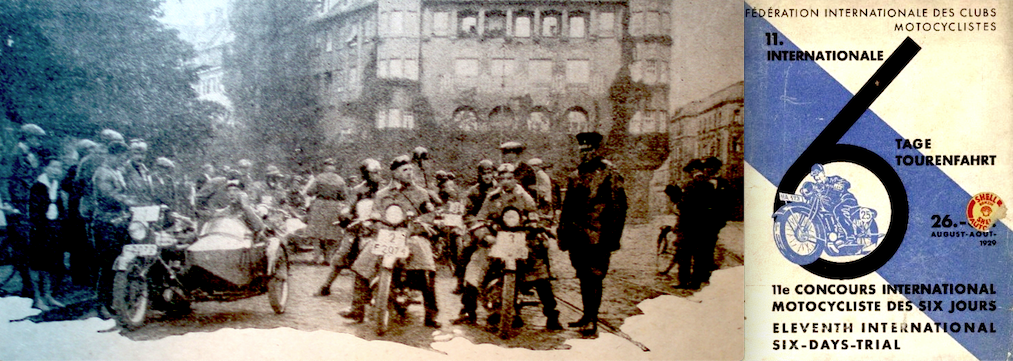
plateau of Bavaria…the minimum speed of 25mph leaves no time to consume a helles bier or photograph an Alp when the going is colonial…If, in addition, you don’t get your check card back until 17 minutes after you’ve been timed into a control, punctuality begins to assume the dimensions of a miracle…Tyrell-Smith remarked at lunch that it was rather like a road race; and he ought to know…a few yards from the checker began the ascent…up the Ettalberg…Here the scenes soon beggared description…this narrow, bouldersome, gulleyed, eternal 1 in 4…was easily the finest competition hill The Motor Cycle man had ever seen…the sidecars were mixed up with the solos. It is not a sidecar hill…At one time there were 28 machines stuck simultaneously…within a space of 20 yards. The air was so thick with burnt oil fumes that it was literally impossible for a competitor to see the man next to him. The stench of burnt oil, dope, tyres, and clutches was nauseating. Some of the foreign riders, clad in heavy leathers, were so exhausted that they simply sat over their stopped engines and panted…On the average our men showed far more machine-control snd presence of mind than those of other nations. Mrs McLean (348cc Douglas) got the loudest cheer, but Miss Betty Lermitte (346cc Royal Enfield) was splendid under greater difficulties, rounding one awful jam by climbing up a grass bank and down again…Poor Van Kooten (743cc Harley-Davidson), of the Dutch A-team, burnt his clutch out on the hill and retired…there are 13 foreigners riding British machines, exclusive of those who are astride colourable imitations of our designs. FELDKIRCH, AUSTRIA, TUESDAY. Seven AM is a far more rational starting hour than 5.30am…The scenery up to lunch at Reutte was simply magnificent. The roads were so easy that a very old lady could have driven a baby car over them without the least agitation. The Austrian gendarmes wore their best swords in honour of the occasion…a Jager band welcomed the competitors at Reutte with much clashing of cymbals though they ceased to salute each individual rider when they discovered that there were nearly 200 of them…the morning run was, as one lad put it, a ‘beer and camera’ section…But the 78 miles after lunch taught many that a main road in the Alps is not the Portsmouth Road…some of the sidecar passengers were literally terrified. For some five miles the line gyrated along a blind, twisty rock shelf hewn out of the living cliff, with often a sheer drop into a gorge 1,000 feet below…At Lechleiten the trial entered Voralberg, a district of
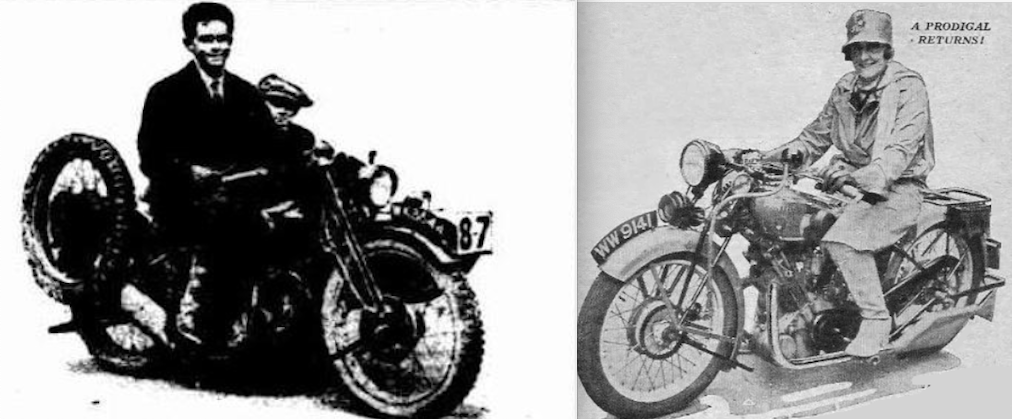
Austria so independent that it reverses the Austrian rule of the road, and keeps to the right, German fashion…when you meet another fellow on a rock edging a precipice, and he takes the same side as you do, matters may become awkward…then began the indescribable descent of the Arlberg Col—20 miles…along a gash scored at a failing angle against a colossal rock with a sheer drop of 2,000 feet, passing at intervals through cloistered tunnels…After the final check…the local petrol merchant had stacked about enough juice for 20 machines, and when supplied failed he would send a lad with a hand-truck to fetch eight more times from a distant garage…Some of the men have had time to buy green Tyrolean hats with shaving-brush decorations, and long pipes of the German model, which keep the stomach warm in winter…Our girl riders are all in and have vastly enjoyed their first taste of the Alps. PALLANZ, ITALY, WEDNESDAY. The check sheets are in such a mess that no official information was available except the retirements…157 men started out to cover the 110 miles before lunch at Hospenthal, near the foot of the St Gothard Pass…Corners were incessant. The village streets were often indescribably narrow. Dust soon rendered everybody completely unrecognisable…uncertainty as to whether the next check would occur at the scheduled distance…caused the trial to degenerate into one prolonged and mighty blind…We passed through four douanes to-day as easily as one enters the Arsenal footer ground…between Faido and Bellinzona a covey of Englishmen had to wait at seven separate level crossings for one and the same goods train…the afternoon section will be remembered for life by everybody. The narrowish road winding under the low cliffs which fringe Lake Maggiore. There is not a teaspoonful of tar on the entire length and the visibility was about 30 yards…At every village and corner the populace were gathered to cheer the ‘race’…Our boys tumbled to the fact that they could go as fast as they liked, and most of them did. With men like Tyrell-Smith in the lead, the pace was simply terrific…The trial passed through Locarno…Hundreds of bathers scrambled out of the Lake to see the lads go by and returned to the water immediately to wash off the granulated soil of Italy which the tyres had deposited on their bronzed and naked bodies. MOUTIERS, FRANCE, THURSDAY. At home 210 miles is hardly reckoned a really good day’s run but this distance to-day has punished the lads pretty severely…Bumps, dust and blistering sun were the conditions, with every corner for Fay Taylour to slide them if she had been so minded. Every mile or two an Italian village, with its narrow, sweltering, pave street, full of children…a Colonial section culminated in. a 15-mile climb up to the 400-yard tunnel piercing the mountains above the famous Sanctuary of Oropa. When it is said that the tyrants who govern this fearsome run only asked the men to average 12½mph up this 15-mile climb, it can be guessed that it was a genuine machine-smasher…An eight-foot shelf, cut out of a sheer face, zig-zags incredibly, clinging precariously to the mighty slopes. The surface is uniformly atrocious. One famous road racing man—a member of his national team_barely managed to cover this section on time, although it included a three-mile descent of good
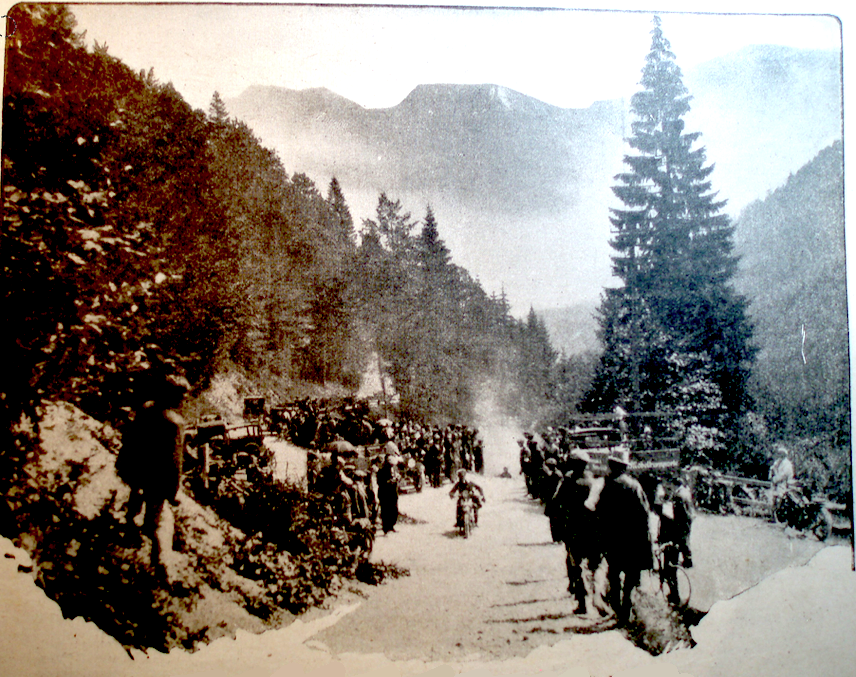
surface, and he went clean over his handle-bars in the attempt…not a share of the solo entry can show a tidy pair of foot spindles and quite a number are limping. FW Clark (346cc New Imperial) hit a wall so hard that he had to see a doctor. FR Forbes-Taylor (499cc P&M) had four spills…When the surface is loose all day, sooner or later attention is relaxed for a moment, and over the model goes…France, mercifully is a land of tar and the entire entry revelled in smooth, dustless going to Moutiers for the night. Nothing can exceed the hospitality and sportsmanship of our Italian friends, but we simply cannot love their waterbound, mud-faced roads. At Moutiers the organisation was immense. A banner across the road, ‘Soyez le Bieuvenue!’ A gentleman with a megaphone who bellowed each man’s number to the timekeeper as soon as he rounded a distant corner, so that he was probably checked in early. A lovely lady waiting to present each feminine rider with a bouquet. A free bar for competitors, staffed by the belles of the town, who gave them dry wine or sweet as they preferred. A service if motor buses to convey the lads to billets in three neighbouring towns…[But] no official results results were obtainable this morning and most probably none will be published tonight…Wallis, on the Dunelt sidecar, was delayed on Thursday with chain trouble, due to a spring link coming adrift, and was rammed by a car in the dark…but is carrying on. GP Wills (499cc Rudge-Whitworth) and Forbes-Taylor (499cc P&M) got off the course this morning, picked up the afternoon’s arrows…and are naturally disqualified for having cut out the worst 100 miles of the day’s route. Many others await the results of protests due to foreign checkers, who could not understand their statements snd wishes. Messrs Loughborough and Ebblewhite [the ACO officials at the trial] are probably wising in giving imitations of the elusive pimpernel…CHAMONIX, FRANCE, FRIDAY. This has been a day of national and other tragedies in the history of this most searching of all six days trials. Most people started to-day’s run all weary and battered after their terrible hammering of Thursday over the harsh Italian roads. The luggage lorry wandered about futilely last night, arriving very late in one of the three towns where competitors were billeted, two of them miles away from the motor cycle park. No real organisation existed for transporting competitors from billet to park. Bed were scarce. One lady competitor staggered round Brides-les-Bains till 9.30pm, got abed at last, lay down in her clothes, was bitten by noxious insects, went out and got to bed in a cleaner house at 1.30am, to arise at 5am…The Husqvarna sidecar driven by Malmberg retired at lunch with its back wheel damaged beyond repair, and so put the Swedish team,
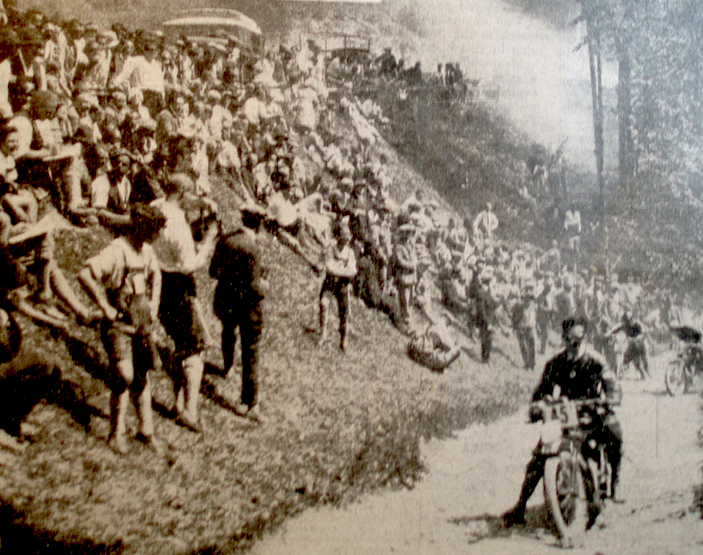
weakened by Göthe’s puncture yesterday, quite out of the running. Profound sympathy was felt with them all three, as their gallant riding of fine machines had made them the universal favourites. On the top of this, Trapp’s Victoria sidecar, Germany’s passenger representation in the Trophy, struck tyre trouble after lunch today. This makes the Trophy a gift for the British team, assuming that they all finish; and at the moment Austria and France stand equal for the vase, both being 10m points down on maximum. Nor does the tale of pathos end there. Poor Miss Sturt (495cc Matchless) had her clean sheet spoiled by an awkward puncture which made her late this evening, and she finished almost in tears; it was a cruel disappointment after surmounting tribulations which have overcome so many of the alleged stronger sex. There have, as a matter of fact, been no fewer than 24 retirements to-day, of whom seven are British, namely, GP Wills (499cc Rudge-Whitworth); FW Plastow (488cc Royal Enfield); WF Bicknell (488cc Royal Enfield); AA Hamilton, (499cc Rudge-Whitworth); CF Wise (348cc AJS); FR Forbes-Taylor (499cc P&M), and FW Clark (346cc New Imperial). Of these, Wills and Forbes-Taylor, as reported, merely lost their way; but Bicknell’s fate has befallen other unfortunates, for example, LA Welch (488cc Royal Enfield). Bicknell’s timing gear began to admit strange noises near Oropa on Thursday. He drove gently, hoping to get his machine on to French soil for easy Customs clearance home. But it gave out entirely, and thenMiss Betty Lermitte towed him 80 miles, though she herself was half crippled through being charged over by another competitor, who had fallen asleep in the saddle from sheer fatigue! At last she could tow him no longer, and to-night Bicknell wires that he is stranded inside the Italian frontier, his passport and Customs papers being in France aboard an official car. Furthermore, most of the official and Press cars have broken down. There were great doings at the Franco-Italian frontier on the summit of the Little St Bernard Pass last night. Mr Loughborough taxied there from Pallenza, 170 miles away, and wired for another taxi to meet him there, and Mr Ebblewhite made a somewhat similar journey, his German driver having collapsed from the strain. Officials and benighted competitors were descending the pass in the dark, to an obbligato of hail and lightning, and arriving at Brides-le-Bains at all hours of the night, only to find every hotel crammed full to its very bathrooms. It is thus that the most fantastic week in the history of motor cycling draws top a close. Some competitors have spent absurd sums in the effort to retrieve damaged machines from the wilds. Johnny Douglas, knowing his mount was an experimental 1930 model, spent £6 transporting it to a railway station. Miss Foley, after a crash which knocked out two teeth and probably fractured a rib, struggled gamely into Chamonix to-night, rather than leave her bus by the roadside in a strange land. Plastow parted form his model as it went over a cliff, and bribed umpteen peasants to drag it up again. Miss M Newton (348cc Douglas) cut inside an official car on a hair pin to clear the dust-clouds, met an unexpected boulder, and carried on minus footrests, with both legs waving in the ear. Rowley (348cc AJS) saved his clean sheet by riding innumerable hairpins on a flat tyre. H Langman (298cc Scott) had no bottom gear, but still contrived to climb all today’s cols. Thumskin Airdie’s sidecar rolled over on a

bad corner, and he came in streaming with blood…there were 194 corners on a single pass…there was a lot of really foul going, and the whole constituted a veritable ordeal for sleepless riders and battered mounts. Tarmac was scarce, loose metal almost incessant, and cornering never ceased. Chamonix, the tripper centre of French ‘Switzerland’ gave us a truly royal welcome, with tiny girls presenting bouquets to all the lady riders…Incidentally, the arrowing to-day was far from good. Nothing is more upsetting to a trials rider within sight of his gold medal than to reach an unmarked road junction, but the French clubmen do not realise that to a Briton anything up which a goat would clamber is a potential trials route…Nobody will ever forget this trial, and the people who come through with clean sheets and no falls deserve statues in Trafalgar Square. GENEVA, SATURDAY. A rather depleted band of survivors enjoyed an unforgettable experience at 7am. The rocky gorge leading up from Chamonix to the frontier was still in deep shadow, but the climbing (yet still invisible) sun was just beginning to catch the mightiest peaks of the giant ranges on either hand, and the loftiest snowfields of Mont Blanc were suffused with rose. The sheer heavenly softness and beauty of a scene of this kind has to be seen to be believed…Everybody admires the sangfroid of grey-haired Mrs Edge, who sits quite unmoved in her son’s sidecar round the most appalling places; Colin Edge himself is still limping badly after his crash on the dirt at Liverpool, but he contrives to handle3 his outfit well [you have to wonder if, when Colin asked his mum if she fancied a run out on his combo, he told her the run was the ISDT]…Lunch was taken early at Ouchy, on the shores of Lake Geneva, and some 40 miles of tarmac—real, smooth, dustless tarmac—brought the lads to the final speed test on a road
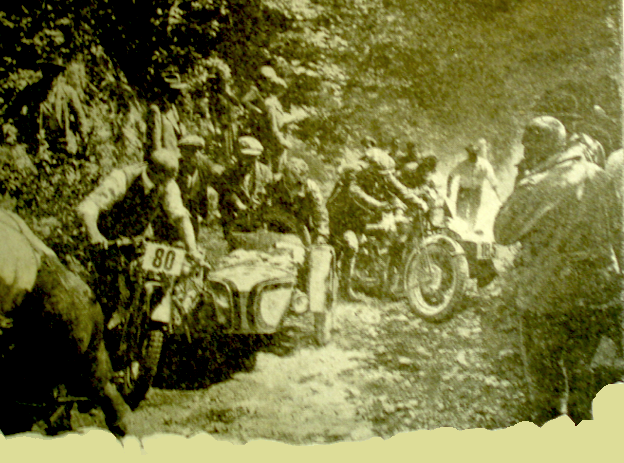
encircling Cointrin Aerodrome. Here arose certain amount of international friction, probably due exclusively to mutual ignorance of languages and to the German reverence for a given order. Everybody had to do an hour’s speed, ranging up to 49mph for 500cc solo machines. No touring plug will stand this. No sane rider will use a racing plug on the road, because it will inevitably oil up. The Englishmen assumed that they would be allowed to insert racing plugs at Cointrin; they had been told so. The Germans had been told more fully, in their own language, that they must change plugs, adjust oil pumps, etc, outside the Cointrin control. So all the early starting foreigners entered the aerodrome control ready for business. The first Britons to arrive were the Irish, whose numbers were in the twenties. They slid into the control and began changing plugs. Instantly a horde of excited German and Swiss marshals dived on them, shouting, gesticulating, and even pawing them. The Irish began to square up, and a free fight was imminent. No British officials were present—this is nothing new—but an English journalist intervened, and temporary peace was restored. Finally Major Watling arrived, but the foreign officials were adamant, and some of the Continental riders obviously gloated at the spectacle of men like Tyrell-Smith attempting to lap at 60 odd on a roadster plug. Meanwhile a picket was posted down the road to put the other Englishmen wise, and as their earliest rider was No 105, there was just time to warn them. It is unfortunately true that much jealousy existed over our standing first at this stage for both the Trophy and the Vase. The track was the course for the Sunday’s extremely crazy Swiss Grand Prix—twelve hours’ lapping of a four-mile circuit without change of riders—a feat calculated to render any intelligent man perfectly insane. Fortunately the six-day men had only to do one hour. In shape the circuit is a mildly distorted square with practically rectangular bends at each of its four corners, all banked the wrong way, rather loose, and slimy with fresh tar oozing in the sun. Two hundred yards from the start is a nasty S-bend, studded with dangerous telegraph posts and trees right on the edge of the road. The entry was divided into three batches, which made massed starts at 2.30pm, 3.45pm and 5pm. The first batch were all foreigners, except for the Irishmen, of whom the pardonably enraged Tyrell-Smith decided to risk disqualification by changing his plug in defiance of his tormentors. The start was a horrid sight. Massed on a turn, in a close jumble of all sorts and sizes of solos and sidecars, with a dangerous S-bend close at hand, all engines racing and the air pungent with blue oil fumes, the men got off somehow without collisions, but the corners all round were an appalling spectacle. A couple of sidecars and four slow baby two-strokes arrived at one bend en masse with fast Rudges and BMWs chafing on their tails and another bellowing, snorting covey of mixed machines close behind. Somebody fell on nearly every
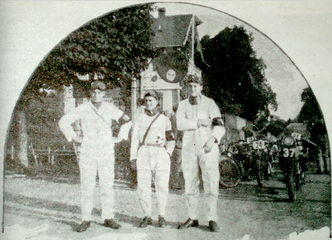
corner for the first lap, and one Dane removed the entire seat of his leather breeches, his woollen undies, and his skin as well. This first hour soon developed into a furious duel between Tyrell-Smith on a Rudge and Soenius on a BMW. Tyrell was better on the corners, but the bigger German engine was faster on the straight, and, though Tyrell rode as only a very angry Irishman ran ride, he was fractionally outpaced. As usual, no official information whatsoever was vouchsafed, but the tale is that only five of some forty riders contrived to average the speeds specified for their gold medals. One reason was that the small foreign two-strokes, being very slow, were most abominably in the way. But this was not, of course, enough to spoil really fierce machines like the flying Rudge and BMW; it just proved fatal to men whose buses would have qualified with a clearer field. Batch No 2 included Miss Marjorie Cottle, Fraülein Köhler, and Mrs McLean. None of them had ever done any road racing in their lives. The Englishwomen had to average 47mph for 60 minutes on a dangerous and crowded circuit, and Fraülein Köhler, on her larger BMW, was set to do 51mph. Plus the ordeal of a particularly stupid form of mass start, this was enough to put the wind up a strong man, and the girls were plainly rather scared. However, they faced it nobly, started steadily, and accelerated when they had settled down a little. There was a nasty crash in the first few minutes. Drew Macqueen’s 493cc Sunbeam tried to round a jam of men on the S-bend, cleared a telegraph pole by millimetres, but caught its iron stay with his bar. His ‘Beam reared up, shot vertically into the air, and seemed to hurl Drew fifteen feet up. He fell on his head, and was carried into the Aerodrome hospital a few yards away. He soon recovered consciousness and is not badly hurt. This second batch was very slow, and few riders can have done the speed necessary for gold medals. Baylon, a very fine rider on a big BMW, lapped the bulk of the field twice or three times, and nobody could hold him. When the third batch started at 5pm everybody was bored to tears with waiting in the terrific heat. Nearly all the English riders were in the crowd. Another terrifying massed start, a
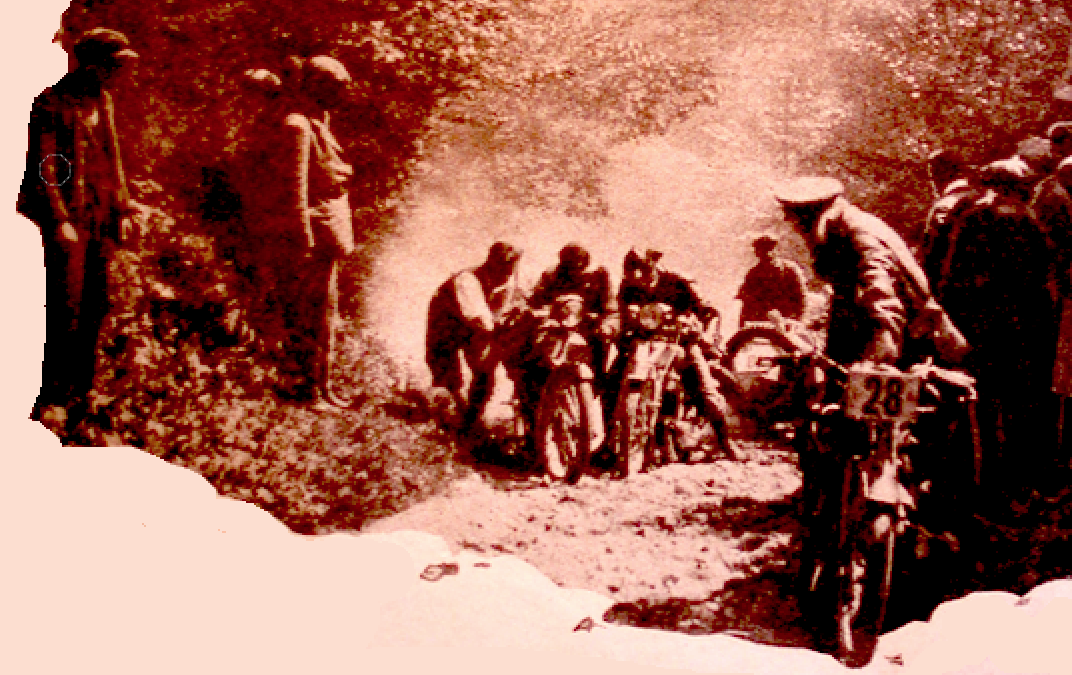
generally high average speed in the comparative absence of slow Continental machines, and a hectic duel between Williams on a Rudge and Pattison on an Ariel, who rode neck and neck for most of the hour. Many of this batch undoubtedly qualified as there were fewer tortoises to cramp the cornering. Miss Lermitte (346cc Royal Enfield), Miss Herbert (497cc Ariel), and Miss Sturt (495cc Matchless) figured in these final acrobatics, but poor Miss Sturt’s plucky Odyssey was terminated by a bad tank leakage. So the great trial ended. ISDT RESULTS: The International Trophy. (1) Great Britain: GR Butcher (499cc Rudge-Whitworth sc), no marks lost; GE Rowley (348cc AJS), no marks lost; FW Neill (498cc Matchless), 1 mark lost ; total marks lost, 1. No other team competing for the Trophy finished complete. The International Silver Vase. (1) Great Britain No 1 Team: LA Welch (488cc Royal Enfield), no marks lost; AR Edwards (346cc Levis), no marks lost; HS Poetry (497cc Ariel), no marks lost; total marks lost, nil. (2) France: C de Lavalette (348cc Peugeot), no marks lost; G Bonnard (499cc Gnome et Rhône), no marks lost; H Naas (499cc Gnome et Rhône), 24 marks lost; total marks lost, 24. (3) Holland No 2 Team: H Vintges (498cc FN), no marks lost; Hans Dolk (498cc FN), 34 marks lost; M Flinterman (498cc FN), 4 marks lost. Total marks lost, 38. (4) Austria No 1 Team: Hobel (248cc Puch), 28 marks lost; Oswald (248cc Puch), 27 marks lost. Total marks lost, 57. Manufacturers’ Team Prizes. 250cc Class.—(1) Puch Team—Hobel, Cymral, Oswald; lost 57 marks. (2) BMW Team—H Winkler, A Geiss, L Steinweg; lost 81 marks. 350cc Class.—(1) AJS Team—GE Rowley, LH Davenport, CE Wise; lost no marks. (2) Raleigh Team—Miss M Cottle, GW Hole, R MacGregor; lost 15 marks. 500cc Class.—(1) Rudge-Whitworth No 2 Team—J Williams, CF Povey, Pyecroft; lost no marks. (2) BSA Team—L Berringer, J Humphries, AE Perrigo; lost 1 mark. 600cc Sidecar Class.—(1) Rudge-Whitorth Team—lost 2 marks. (2) BMW Team—E Henna, H Soenias, FH Kohler; lost 16 marks. One hero completed the ISDT on a 175 and earned a silver award. Statistics. There were 11 250s, whose riders won two golds, one silver, two bronzes and four certificates; two retired. The 50 350s won 10 golds, 16 silvers, two bronzes and five certificates; four finished with no award—the remaining 13 retired. Forteen of the 69 500s won gold, with 21 silvers, 11 bronzes, four certificates, one no-award and 13 retired. There were 19 750s—five golds, five silvers, a bronze, a certificate, two no-awards and five retirees. Another hero tried his luck with a 1,000cc solo but didn’t get it to the finish. Four out of 11 600cc outfits won gold with two silvers, a bronze, a certificate and three didn’t finish. Half of the six outfits up-to-1,000cc failed to complete the course; one won gold, one silver and one finished but no cigar. So of the 168 starters 36 won gold, 47 silver, 17 bronze, 15 certificates, eight no-award and 45 took an early bath.
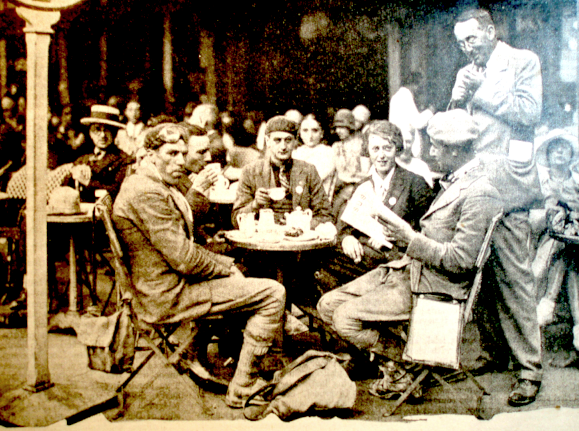
“WELL MAY IXION WONDER how those competitors fared who, having retired from the International Six Days Trial, were left eight frontiers or so from home, with neither passports for themselves nor customs papers for their machines. Those whose machines became completely unrideable suffered most; their adventures were varied and expensive. Those who ‘executed repairs’ and continued—though too late for any award—were compensated by the marvellous scenery, through which they were no longer compelled to blind at 40kph. Their troubles came later. The writer, having burnt out his clutch on the Etallerberg on the Monday, secured a tow to Obentmmergau, where the Hotel Alte Post produced innumerable corks with which to restore it. These were cut to shape with the enthusiastic assistance of the proprietor’s daughter (who is cast for the part of the Virgin Mary in the 1930 Passion Play) and his youthful son, the rider of a 174cc Raleigh. The number plate of the latter machine was almost as large as the motor cycle itself, but the lettering was almost entirely defaced. Thus works the official mind on the Continent! When the clutch had been repaired, the machine was headed for Partenkirchen, the official stop for the night. Here many competitors ventured on the funicular railway to the top of the Zugspitz, a climb of almost I0,000 feet, producing both deafness and giddiness. On Tuesday the Austrian frontier was successfully crossed without any questions being asked, and Feldkirch was reached for the night.
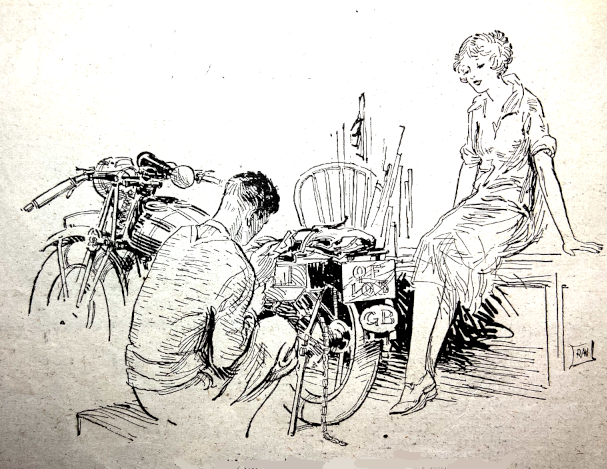
Here the event of the day was the appearance in the street of the municipal band, with a drum so large that one man towed it in the procession on a trolley, while the drummer followed behind, smiting it whenever he came within reach. Here, also, the ACU, which had collected all the competitors’ papers, was supposed to have sent me mine. They did not arrive. The Wednesday, it may be remembered, saw the competitors traverse Switzerland from north to south, Italy being reached in the evening. The Swiss-Italian customs houses were at opposite ends of a bridge on the shore of Lake Maggiore. Here the guards at the Swiss end were suspicions, but, as I was leaving their territory and not trying to enter it, they eventually let me by. The Italians, at the other end of the bridge, were made of sterner stuff. At no price would they let the passportless stranger go on to Pallanza for the night; and now the trouble became serious, for, on recrossing the bridge. I found that the sturdy Swiss who had been prepared to speed the parting guest were not anxious to welcome him upon his return. I pointed out in my best French (though this was not the occasion when a similar effort produced the amazing reply, ‘Pardon me, but are you Scotch?’) that I could not stay for ever on their charming bridge and would like to telephone to Baron Tindal, the Clerk of the Course, at Pallanza. This they allowed, but unfortunately he was in his bath (pardon Baron, but you know this is true!) and could not be persuaded to leave. When he did it was only to inform me that my passport and carnet were at Feldkirch, in. Austria. And that, roughly speaking, was that. Thus, with a sickening feeling of loneliness, I saw the last hangers-on of the trial vanish into the evening, with hotels awaiting them at Pallanza, while I remained marooned on the bridge. At last, probably because they feared another outburst of ‘French’, the Swiss took me along, under guard, to the nearest prefect of police at Brissago, from whom I obtained an excellent cigar and permission to remain at Brissago protem. On Thursday I thought it better to telephone to Feldkirch before starting off on a possible wild goose chase. There was nothing of the ‘100% Talkie’ about this telephoning, but a good deal of ‘Silent Drama’. I explained what I wanted said (still using Scotch-French) to Madame of the Hotel du Myrte. She put it into German and told her husband, who put it into Austrian, and then into the transmitter of the telephone. Where it went to I do not know. It cost a lot of money,
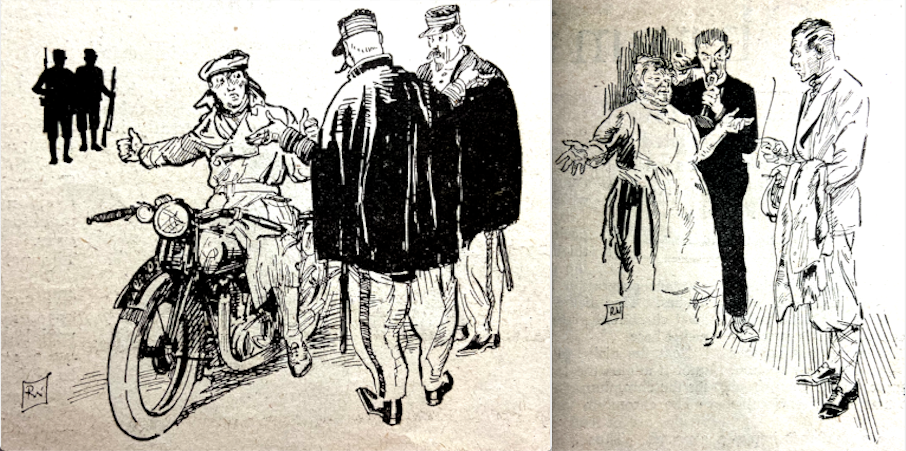
but produced no passport. After this I tried telegrams, but this meant collecting the postmaster, an elderly but charming man, who was usually to be found on a raft a hundred yards or so out of the municipal bathing place, where he disported himself in the company of a bevy of Italian belles, each of whom could have got at once into the front row of Ziegfeld Follies. While he swam hack to dispatch my messages, I deputised for him on the raft; but he sent off those telegrams with unwonted despatch. Friday came, and still no news; but then friend postmaster (who had begun to wonder whether I was a visitor or a visitation) produced a map by which it appeared that it was possible to get to Geneva, the finishing point of the Trial, without leaving Swiss soil, providing—and here was the rubs—one was prepared to go back through Locarno, Bellinzona and Airolo, reclimb the St Gothard Pass, go over the Furka Pass and the Rhine-Rhone watershed, and down the valley of the Rhone.He said the road was easy; very easy, in fact. Reflecting that what Hilaire Belloc had done on foot (though I suspect him of cutting the comers) I should he able to do on a perfectly good motor bicycle, I set off on Friday afternoon. The passes were memorable chiefly for being lonely and cold. One Morris-Cowley appeared, boiling furiously. When I called, ‘Hello, GB!’ the occupants looked down their noses most orgulously, and generally intimated that they were very superior persons. The following day I picked up the Trial at Martigny, and pleasant it was to overtake the last competitor. Apart from a miraculous draught of papers by the ACU, one final impression remains: a memory of the speed trial, as seen from the seat of Edge’s Rudge sidecar, which I occupied for the hour in place of his gallant lady passenger (his mother)—an experience that left one with a higher opinion of her courage than ever.”—’DION‘
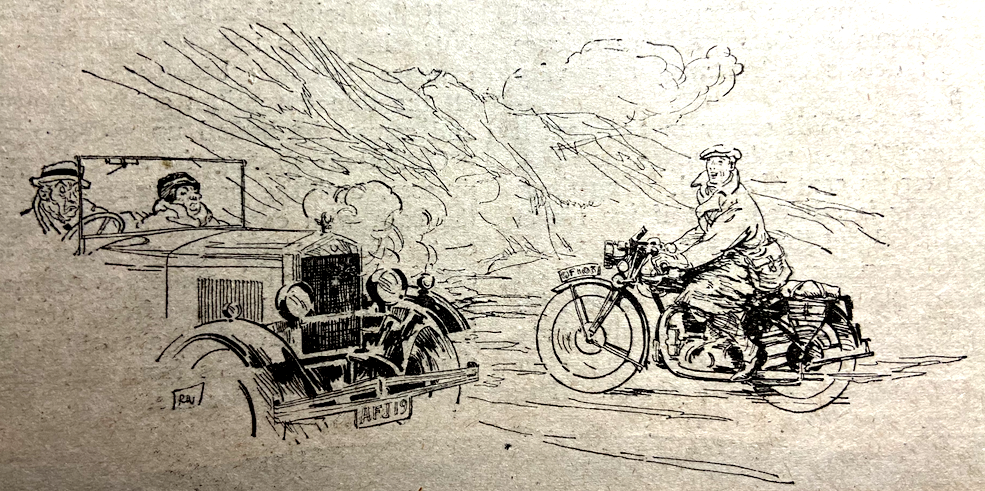
“LAST SUNDAY THE SWISS Grand Prix was held on the Meytin circuit of 6km 550m, and this year it took the form of a 12-hour race rejoicing in the lengthy name of geschwinditkeitsprufung (speed test). At the early hour of 6am the 42 competitors were despatched, and even at that early hour many spectators lined the course. All the riders were foreigners since HS Perrey, who was entered on an Ariel, failed to put in an appearance as he slumbered so soundly following the strenuous ‘International’ that he could be awakened in time. A short-distance grand prix would have attracted many British entries, while the six-day men in Geneva would also have seized the opportunity of witnessing a first-class Continental race. As it was, tired out from their struggles, the Englishmen were absent. The race itself proved most monotonous; it was just a continuous stream of riders passing on machines of all sizes and types of machines, their lap scores being recorded each hour on a huge board…the heat was stifling and in the stands there was no protection from the sun’s rays; consequently the seats presented an empty appearance. At half-distance, when 32 riders were still in the running, a commanding lead had been attained by Emile Frey on a 500cc Radco. At six hours he had covered 83 laps, the second being Marius Cudet on a 348cc Norton with 80 laps, and third Francois Gaussorges on a 350cc MAG-engined Money Goyon with a lap less. The fastest rider was Alfter on a 750cc twin Indian, but trouble overtook him in the early stages, and at half-distance he had 70 laps to his credit, and was second in his class to Starkle (Scott); then he began to streak round the track in hot pursuit of the leaders. After seven hours 28 riders remained, and Frey still led with 96 laps—a distance of 639km—but Gaussorgues, with the Monet-Goyon, had overtaken Cudet (Norton) and shared second place with 92 laps. At eight hours Frey’s Radco still ran with remarkable consistency and led with 110 laps, and Gaussorgues maintained his speed, registering 106 laps; Cudet covered 101 laps and retired awhile. D’Eternod (Sunbeam) retired after 100 laps when in fourth position. At 3 o’clock the Radco was still four laps ahead of the Monet-Goyon, and now Kappeler (Sunbeam) came into the picture, lying third with 112 laps, Cudet being physically unable to continue after a trial of two more laps. Twenty-one competitors now remained. After ten hours’ running, Frey, consistent as ever, led with 136 laps, Gaussorgues (Monet-Goyon) being second with 131 laps, and Kappeler third with 122 laps; Divorne (Condor) was but a little way behind. The Flying Indian was in frequent trouble and registered but 107 laps at this hour. Generally the speeds were disappointing considering the achievement of the full-touring-trim ‘International’ machines on the same course the previous day….Interest increased as the closing stages arrived, the crowds flocked to the stands, and then there was a thrill, for with but 25 minutes to go Frey toured in on his Radco with the back tyre flat After a consultation at the pits he was advised to continue; he did so amid cheers, but his path was a wobbly one. Very soon it was seen that his tyre and tube had disintegrated and he was riding on the bare rim, and the crowd gave him loud and sympathetic cheers. Meanwhile Gaussorgues continued his speedy laps, gradually overhauling the leader. Twelve minutes to go! And the 12 minutes sufficed for him to make up the loss; when he was flagged off as the winner he had covered 156 laps. Poor Frey’s rim collapsed after two tyre-less laps.”

“AFTER THE THRILLING FORECAST of ‘A Schoolboys’ TT’ in the lunch edition of a London evening paper, matters seemed very calm down Carshalton way last Saturday. The Carshalton Club had undertaken to organise a trial suitable for those under 18 years of age, with result that 46 entries were received…The schoolboy atmosphere was entirely missing, in its place was a professional air of last minute bustling…very few wore school caps and only one pr two deigned to wear their school blazers. The course under the sweltering afternoon sun was bone dry, making extremely hard riding on the loose, sandy surface…Old Chalky proved the undoing of many. This scarred and rutted old veteran of Surrey is almost impossible when wet. The first man up was E Wheelwright (196cc James) quite three-quarters of an hour too early; it seemed that the newspaper was not so far wrong after all!…RT Newberry (247cc Excelsior) with a ‘Meet William’ expression of glee on his face kept well to the left, dodging under the bushes, to be followed by EA Dussek (490cc Norton); the latter literally romped up, exploring every gulley en route, and made easily the quickest ascent of the day. A moment of peace, until a familiar buzzing was heard, and, incredible as it might seem, Mr Wheelwright, amid roars of laughter from the spectators, appeared once more, this time on the third lap of his TTI Newman made an excellent climb on an old belt-drive Triumph of uncertain age; he was followed by EL Angus (493cc BSA sc), the only passenger man to arrive at the hill; at least two others had started. After a few anxious moments at the beginning of the rutted section he chose his path carefully and made the best of it. Soon after No 13, in the shape of EC Large (349cc BSA) appeared a la Denley, making a fast climb with feet on pillion footrests, the normal type being inconspicuous by their absence…the riders chased the dye to the Greyhound, Carshalton—the finish of an excellent organised trial which demonstrated the high standard of riding attainable by the modern schoolboy, at the same time giving a very excellent reason for allowing the licence age-limit to remain at 14 years.”

“IT WAS BORROW,” IXION RECALLED, who sang about The Wind on the Heath, and thereby joined the company of the famous. I think he got in rather cheaply, but it would never do to say so in the Spectator; I also think he was a bit of a poseur, and enjoyed the wind on the heath about as much as the minor poets are honest when they chant about the bliss of dying for love ; personally I prefer to live for the next love. But listen to this: ‘What can compare with the sting of the hail on your bare cheeks, the chill, giant pressure of the raging gale on your eyeballs, the lethal chill of the rain trickling down your manly torso, the lurch of your iron steed as the vicious wind shifts it sideways on some bald moor, the slide of the helpless tyres on some grease-spread bend, the foretaste of death’s icy hand on nose and ears as the blast congeals their blood, that sensation which comes when all feeling save that of cold quits your frame, and, physically moribund, you ride on and on, seated on a howling projectile which seems to be the only live and sentient thing in a world of cold and noise and rage and water and ice?’ No, I didn’t write it. It is a reader’s protest against some words of mine which suggested that even in mid-winter there are some days on which it is worth taking out the bus. His words affected me to such an extent that I almost began to feel a certain sympathy with a coroner who recently opined that all motor cyclists are mad; and no less with Mr Weller, Senior, who held that on a winter night a nice cosy bar, with a buxom widder behind it, and a steaming glass with a kick and a bit of spice in it, take a lot of beating.”
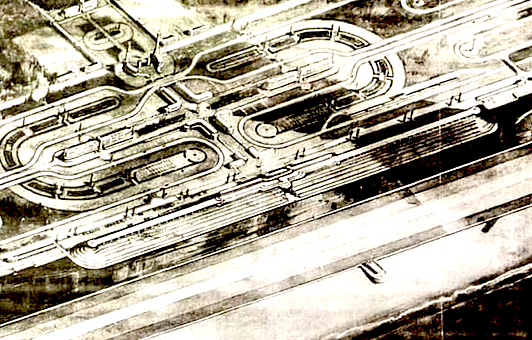
‘UBIQUE’ OF THE MOTOR CYCLE made some informed predictions about the Olympia show. “”Perhaps the first thing to strike the eye will be the prevalence of chromium plating on sports and de luxe models. To the eyes of some of us the blue-white sheen of this admirable finish is still more striking than natural; but who can deny the advantages of a tarnish-proof handle-bar, exhaust pipes and, in some cases, even tanks? Early experiments…were not altogether successful…but first-class chromium plating is now to be obtained at moderate cost…There will be a certain number of those unusual designs which the public are apt to term ‘freaks’, though it is likely enough that they are just good designs born before their time…For the benefit of the many riders who are interested in the future of the quiet, flexible, multi-cylinder engine, it is safe to say that the prospects…are more rosy than they have ever been in the history of British motor cycles; and it should be noticed that the manufacturers who have given their minds to…this type of machine are concentrating not upon highly priced luxury motor cycles but upon reasonably priced utility machines which will cost no more than some 350cc super-sports models…towards the end of 1930 there will be quite a little crop of British four-cylinders, all bearing famous names…it is quite possible that we shall see a half-way step towards the four-cylinder in the form of a novel twin four-stroke placed with the crankshaft in line with the frame. There will be a distinct tendency towards the employment of inclined single-cylinder engines…not only is it easier to house a big single in a normal frame in an inclined position, but the possibilities in regard to cylinder head cooling and weight distribution are improved. Another very interesting development is likely to be the return of coil ignition. Those who remember the coils and accumulators of 20 years ago need not shudder needlessly. Much experimental work has recently been going on, and coil ignition in its present form is thoroughly reliable and satisfactory. the main advantages…are easy starting, a big range of advance and a single rotating armature for both lighting and ignition. The only catch appears to be that the current must be switched off when the engine is stationary, and it remains to be seen whether we are to have buzzers or red lights to warn us of our sins of omission…There are so many possible constructions of the ‘Everyman’ type that it is doubtful we shall see a very definite move in any one direction, but the whole tendency of the trade is towards the development of a lighter, and more tractable type, and this is a trend in the right direction…It is more than likely that one or two firms who at present specialise in lightweights may give us their versions of the ‘Everyman’ machine, and the form which they are most likely to adopt is based on existing models plus very special mudguarding, simplified controls, and minor refinements to render riding and handling more easy than at present…the standardised control, scheme appears to have borne fruit at last, at least as regards handle-bar fittings, though it may take time before everyone falls into line with brakes and gear levers. Overhead valves have ruled the roost for some years past, but there is a possibility that a new side-valve engine, incorporating all the latest improvements of the type, will make its appearance under a name which has made a world-wide reputation for speed, reliability and first-class workmanship…In regard to frame design…there may be an entirely new spring frame propelled by an unorthodox engine unit and emanating from a works which has been famous since the early days of motor cycles.”
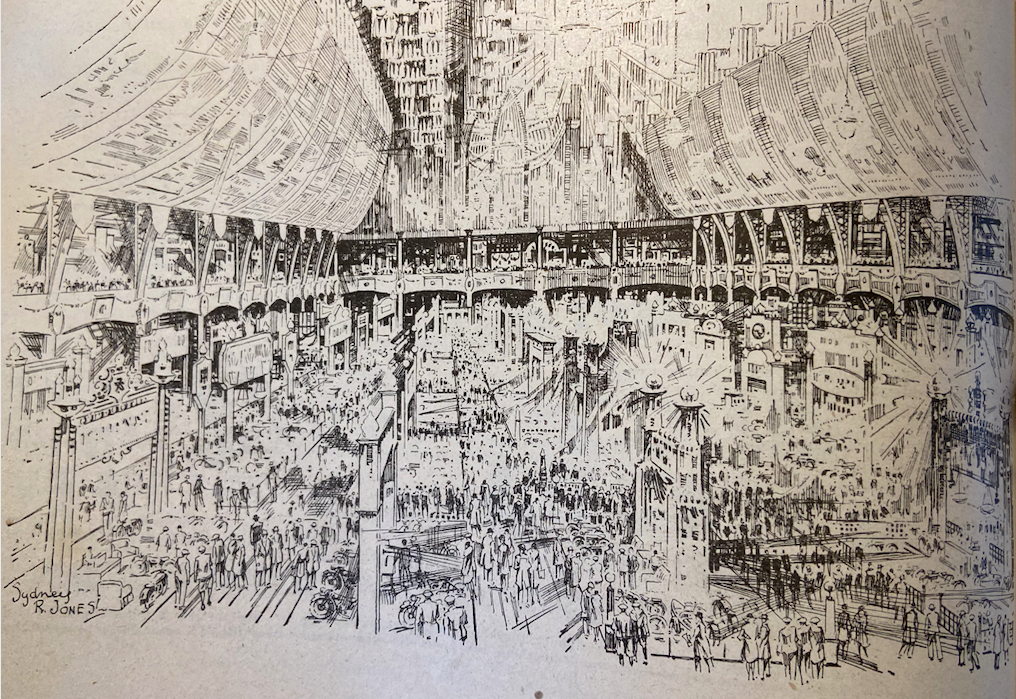
“WHEN A FIRM OF CONSIDERABLE experience [Dunelt] markets two distinct lines comprising small two-strokes and larger four-stroke machines its programme is bound to be interesting. The ‘K’ Royal De Luxe is already very well known to the motor cycling public, and has earned itself an enviable reputation for reliability and comfort…Apparently owing to the proposed increase in weight for taxation purposes the manufacturers have been able to fit 3in tyres and to carry the exhaust through two entirely separate pipes and silencers. The lines of the new tank have effected a further improvement in appearance and rubber knee grips are now fitted at no extra charge…All Dunelt models can be supplied with chromium plated tanks with a black top panel and with chromium-plated exhaust system and silencers…The 496cc twin-port four-stroke…has been designed to meet the demands for a fast and powerful roadster of even greater power than the well-known 350…In memory of the amazing achievement of covering 25,000 miles in 23 days on the Montlhéry track the latest 348cc twin port Dunelt has been christened the Montlhéry model…the most outstanding feature is the adoption of dry-sump lubrication…”Something quite new in the way of Dunelts…is one of the smartest products which has emanated from this well-known factory, and is engined by a two-port 250cc Sturmey-Archer engine specially produced for this machine. The valve operation is of the Slater type—that is to say, there is a vertical shaft at the side of the engine on which two face cams are mounted; the rocker spindles extend through the cam casing, and arms operate direct on the valve stems. This is one of the neatest and most efficient types of valve gear which has yet been introduced for motor cycle work, since the reciprocating weights are no greater than in the case of a normal overhead-camshaft design…the cam spindle and bevel spindles are quite separate, being mounted independently in their own bearings, and the connection between the two is made by a tubular shaft with Oldham couplings at each end…The engine is inclined forward in an unusually sturdy frame, and though there is but a single top tube, this is braced by a pressing carried from a point near the back of the tube to the lower part of the head lug. This pressing is designed to carry the tank.”


“NOTHING LESS THAN THE creation of a new standard in motor cycle performance has been the aim of the designer of the ‘Silver Arrow’ Matchless…At first glance anyone might take the new 400cc Matchless for a very compact, straight four-cylinder. Actually the engine is a monobloc side-valve V-twin with the crankshaft in its normal plane across the frame and the cylinders set at the very narrow angle of 26°. The frame, too, is unusual; it incorporates a very simple, yet perfectly sound system of rear-wheel springing…a real endeavour has been made to provide an extremely comfortable machine of great docility—one that can be started without effort and that will run with the mechanical and exhaust silence of a high-class car…the designer has striven to produce a machine with true ‘Everyman’ characteristics, although the weight is high—about 340lb…the engine is of 397cc, having a bore and stroke of 54x86mm. The stroke is unusually long in the hope of providing flexibility and smooth running…A single iron casting is fixed to the cylinder block by 12 accessible studs and forms the two semi-turbulent combustion heads…the valve gear is fully enclosed and has a chromium-plated cover plate that can be detached on removal of a knurled hand-wheel. A copper-asbestos washer is used for the head joint…Both aluminium pistons carry twin rings and have their crowns cut at an angle so a
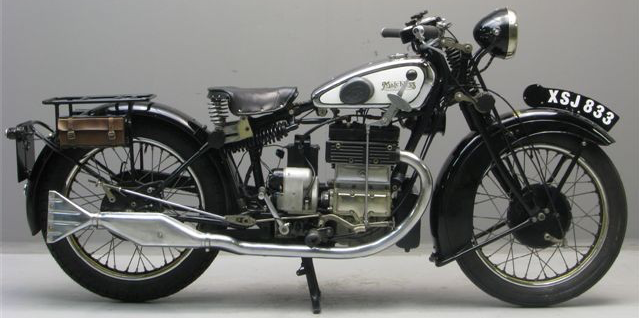
normal combustion chamber shape is obtained. The camshaft is set at right angles to the crankshaft, from which it is driven by skew gearing…Although the engine has a compression ratio if 5.6 to 1 no exhaust valve lifter is fitted, it being found that with cylinders so small as 200cc no effort is required to rotate the engine against compression. For stopping the engine, which, owing to the carburreter being fitted with a throttle stop, ticks over with the throttle lever closed, there is a magneto cut-out mounted on the handlebars; when full electrical equipment is supplied, it is on the dashboard….there is not a single external oil pipe. At the front end of the crank case…there is a bolted-on oil tank, with the necessary leads or ducts to and from the tank drilled into the crank case…In design the spring frame is ingenious in its simplicity. The centre position is of the diamond type with three straight large-diameter tubes. The top tube or tank rail carries close to its rear end a pair of compression springs…attached to a triangular rear portion which pivots immediately behind the saddle tube…Right at the rear end of the tank rail there is a massive T-lug. This carries two rubber buffers—to prevent the possibility of the springs closing up solid in the event of the machine striking a really deep pothole—and a pair of slotted steel plates which act as saddle spring mountings, and form the necessary friction surfaces for two hand-adjusted shock dampers…The Sturmey-Archer gear box is fixed immediately behind the engine unit and in front of the saddle tube, so that the pivot of the rear portion of the frame is not concentric with the rear driving sprocket…Both brakes are of 8in diameter and are interconnected. A central rolling stand and a front-wheel stand are provided. For ease of access to the rear wheel the wide, D-section rear mudguard is detachable from a point just behind the ‘seat stays’. A test of the Silver Arrow proved that it has a performance right out of the ordinary. Starting is exceptionally easy, and the machine tested had a useful top gear range of 8-63mph. No whip was apparent in the frame, while the degree of comfort afforded was very high indeed. In the matter of silence the new Matchless can more than bear comparison with the average light car.

“FRAME DESIGN HAS ALWAYS been an oustanding feature of SOS models. For 1930 even further improvements have been made in this respect, and the latest frame embodies many ingenious ideas. It has welded joints throughout, and the main frame consists of continuous tubes bent round the head, rear wheel. and below the engine, the tubes being arranged in duplicate. This duplicate construction is braced by a steel tray which protects the whole of the engine and gear box and stiffens the construction to an enormous extent…the gear box is bolted to square-section tubular runners above the steel tray. Flat steel strips are bolted along the bottom rung of the frame, and are drilled in such a manner that both footrests and brake pedal may be mounted in any position to suit the convenience of the rider. The whole frame layout is most ingenious and sturdily constructed.. On the Villiers-engined models an oil tank is let into the space between the duplex top tubes; although constructed entirely separately from the main saddle tank, it is permanently fixed between the duplex fuel tanks.”

“FITTINGS ON ALL GRINDLAY-Peerles models will be chromium plated as a standard finish, and even the tanks will be thus finished on the 350cc and 490cc double-port loop-frame models. These two are, perhaps, the most handsome of a good-looking range, and a big improvement in appearance has been brought about by a change in the tank shape. The tank is now deeper and more generous…The equipment includes a gear-box-driven, tank-mounted speedometer and a remarkably neat eight-day clock incorporated with the petrol filler cap.”

“IN ADDITION TO THE two-strokes and 350cc four-stroke Levis machines there will be two new models, a side-valve and an overhead-valve, each of 247cc (67x70mm). These new models will come as a surprise to many Levis devotees, but they are smart little machines of excellent appearance…Except for the valve gear the engines are exactly similar…These engines are housed in a frame very similar to that of the six-port two-stroke, having two top tubes, but the front down tube has been modified somewhat to suit the needs of the case. A Burman gear box with long lever control; Druid forks; and 26x3in wheels are employed, and there is a 5in brake in the front wheel and a 6in brake in the rear. Chromium plating of detail fittings is employed throughout, but an extra charge will be made for a chromium-plated tank…A very neat little gadget which will be fitted to the new Levis models takes the form of an extension leg for the spring-up stand, for use when the machine is brought to rest close to a kerb. It is often very difficult to leave a machine on the stand in these circumstances, owing to sharp camber of the road, but the small extension hinged to the near side leg can be brought into action by the toe, and thus packs up the machine to a suitable height. It is probable that this device will be placed on the market as a proprietary article.”

AJW BOSS (ALBERT) JOHN Wheaton called in Brooklands veteran George Tucker to ride the racing version of his Super Four. The ‘two wheeled car’ that had attracted so much attention at the 1928 Oympia show had been stripped of its road going equipment; its 986c Fraser Nash engine was fitted with a Cozette supercharger and, following ‘difficulties’ with handling during a Brooklands test session, a Swallow racing sidecar was fitted for the All-comers Passenger Handicap Race. Wheaton sat in the side-car and they went for a test run. As they got on to the Byfleet Banking the outfit took one leap and nearly had them both over the top. Back at the paddock Tucker said that he was not going in that again; Wheaton replied, “Neither am I.” And that was the end of the Super Four racer.
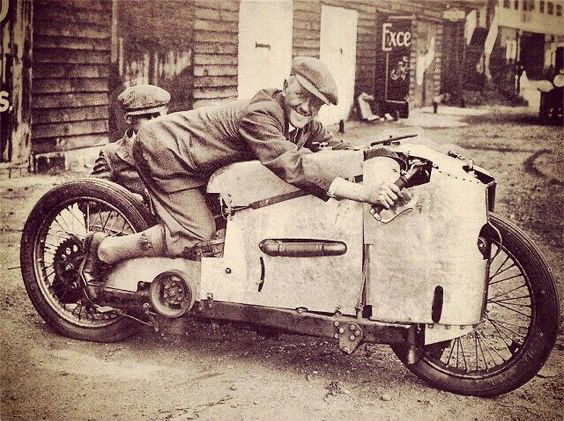
ON A MORE MUNDANE NOTE, AJW’s range of big twin and singles were joined by a range of two-stroke lightweights with the ubiquitous Villiers engines and Albion three-speed boxes. “The greatest interest,” according to the Green ‘Un, “attaches to the design of the frame. The main portion of this is made from two malleable castings running from the rear spindle to the front of the engine—one on either side. These are of D section until they reach the gearbox, whence they get very much deeper and form a solid mounting for the crankcase and gearbox…The gearbox can readily be detached through a suitably sized square hole in the side of the casting. The rest of the frame is built up of ordinary tubes, trapped, and using bolts instead of brazed lugs. A pair of long tubes run from the rear spindle to the top of the steering head, tapering all the way….Saddle tanks holding both petrol and oil have the Villiers sight feed mounted centrally between the two filler caps, and there is also a route card or map holder frame…for an extra £3 these models can be supplied ready for competition work with upswept pipes, Petrolflex tubing, ports tyres, number boards and non-inverted levers covered with rubber…Any of the four-stroke models can be fitted with a spring rear wheel working on a principle which gives very little unsprung weight, and is unobtrusive in appearance. The rear fork ends are altered to take two vertical tubes one on each side of the rear wheel. These tubes carry large phosphor bronze bushes in which slide two further members with forked bottom ends to take the axle. The movement of these inside sleeves is controlled by two main and two rebound coil springs, which abut against a solid block contained inside the sliding sleeves (these latter are slotted vertically so that this block can be pinned in position through the outer casing). The tops of the sliding tubes are bridged by a heavy cross-piece which is concealed by a metal cover made in one with the rear mudguard. The brake anchor arm is taken from this bridge piece. The rear wheel has a maximum vertical movement of 1½in, and the tensioning of the rear chain is automatically controlled by a spring-loaded jockey sprocket mounted on the lower near-side chain stay. The final model in the range is the special four-port Anzani, which also has a four-speed Jardine gearbox and is sold fully equipped.”

“FOR NEXT SEASON,” MOTOR CYCLING reported, “Brough-Superior machines generally have been greatly improved…The designs of the only addition to the range is the Black Alpine 680, which strike an unusual note in that it is the first machine that has been turned out from the Brough works with the tank finished in any other scheme than the familiar black and nickel…The frame is the same design as used on the ‘680s’ last year and can be had either rigid or with rear springing. In the latter case…the ground clearance has been increased to 5¾in, which is no mean achievement…[as] the saddle position has…been lowered to 27½in. The engine is made by the JAP concern especially for Mr George Brough and has oh valves with fully enclosed rocker gear. A new system of entirely automatic lubrication has been evolved which employs no pumps whatsoever but relies upon the vacuum and pressure created in the crankcase by the movement of the pistons…A four-speed gearbox…is standard…The petrol tank is finished in egg-shell black and is relieved by a silver-leaf line round the top portion, twin filler caps and chromium plated metal badges…A design of rear carrier is used which will make a strong appeal to sporting riders. The actual carrier can be detached leaving the toolbags in situ by removing four accessible bolts. The arrangement also allows of instant inter-changeability of the standard toolbags…and the well-known large touring valises which have been obtainable with this make for some time…A speedometer light throws a diffused light over the dial when the lamps are on ‘full’…The 8in brakes are now fitted with water and mud-excluding flanges. The famous side-valve SS80 has quieter valve gear, and the actual springs and tappets are enclosed in aluminium tubes split vertically. The front half, which is detachable, can be removed in a matter of seconds and is retained by spring pressure.///Every machine is fully equipped with special Lucas magdyno electric lighting having the switchbox mounted conveniently on the top of the tank. A dipping-beam system is standard, also a pilot bulb for parking…the large single headlamp has a cute little motif on the top of the rim.”


VELOCETTE CAME UP WITH two new models, an ohc 350 and a two-stroke 250, both eschewing mags in favour of Miller coil ignition which was “designed in conjunction with Veloce Ltd”. The twin-port KTP joined the production racing KTT and super sports KTS; it was sold with electric lights and horn as standard, twistgrip throttle and larger brakes. According to the Green ‘Un: “This machine is a serious attempt to provide a motorcycle with a good all-round performance (a comfortable 65mph is claimed), with a very comprehensive equipment, which will give trouble-free running without the need of constant adjustment…The performance of the 249cc engine is quite extraordinary for this class of machine. Veloce Ltd have always been noted for producing two-strokes capable of surprising speeds but the GTT, as it is called, is definitely far in advance of past examples. With a cruising speed of 50mph and capable of exceeding 63mph, this little engine develops the remarkable figure of over 9bhp…lubricant is carried in a compartment of the petrol tank and fed to the engine by a pump…It must be stressed that each of these mounts has been designed in conjunction with the silencing system with which they are sent out. We were able to hear both running and can confirm that the degree of silence attained is very high…any alterations effected by owners will most materially decrease the performance.”


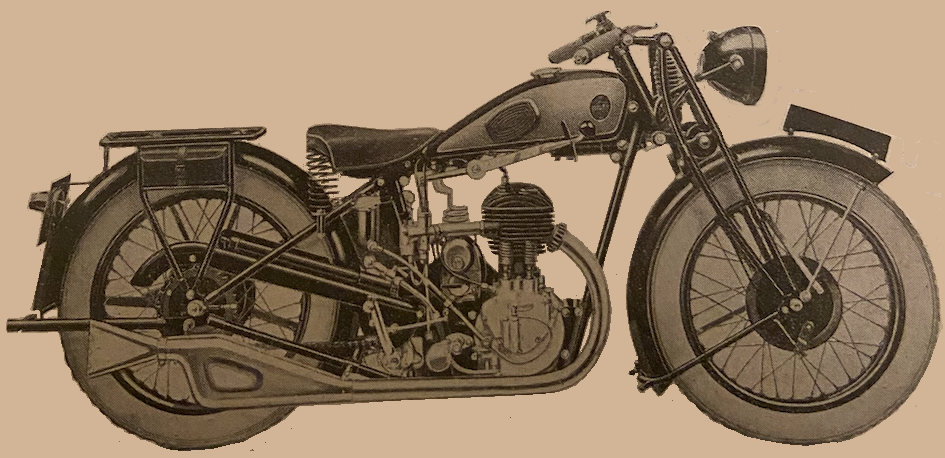
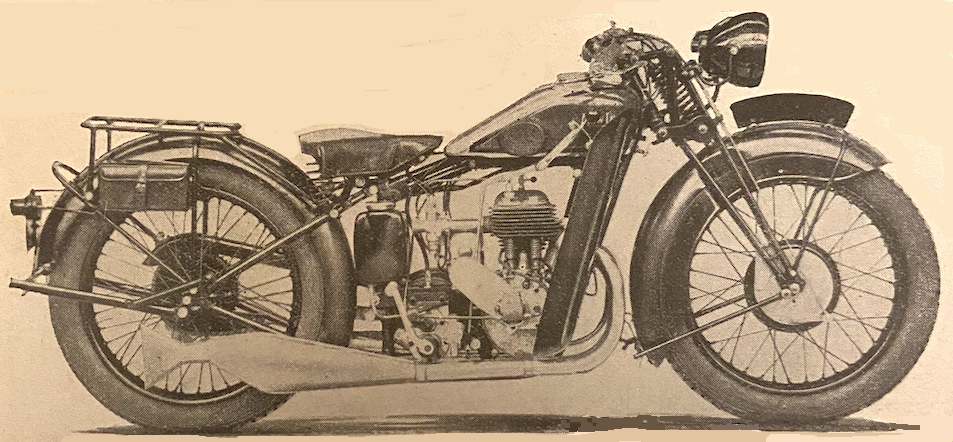
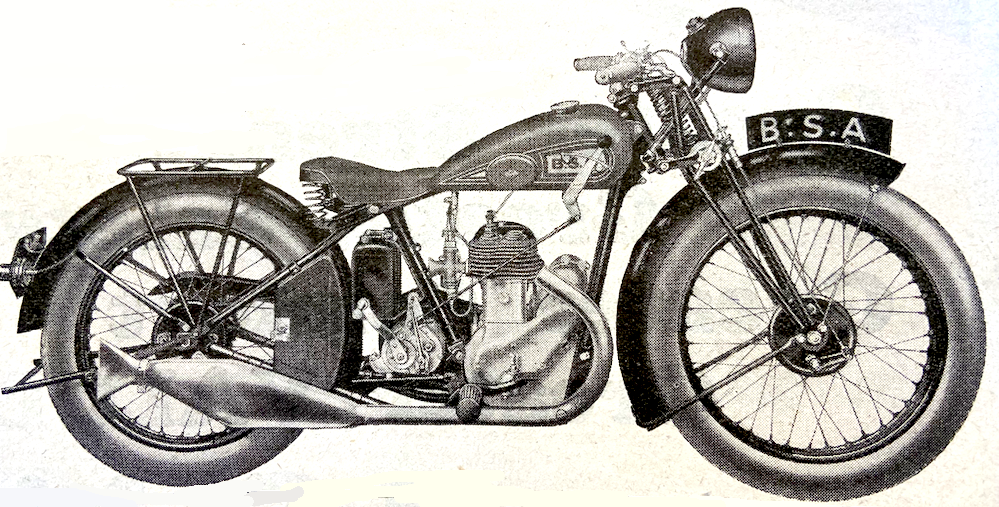
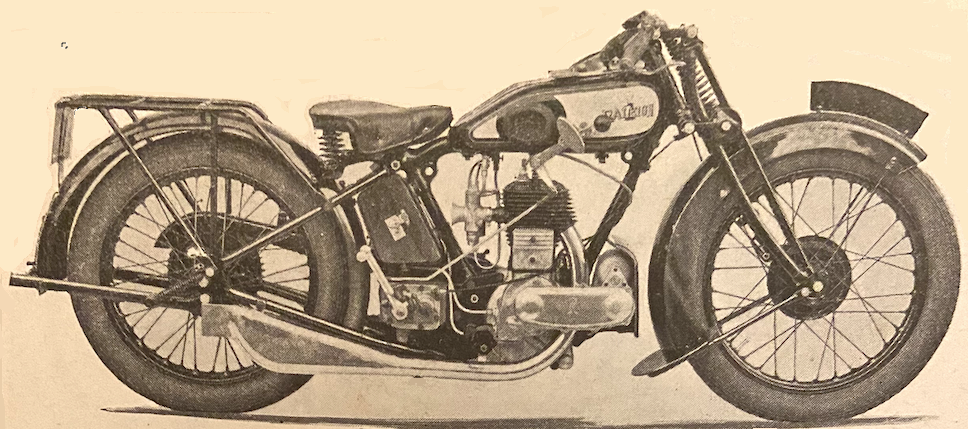
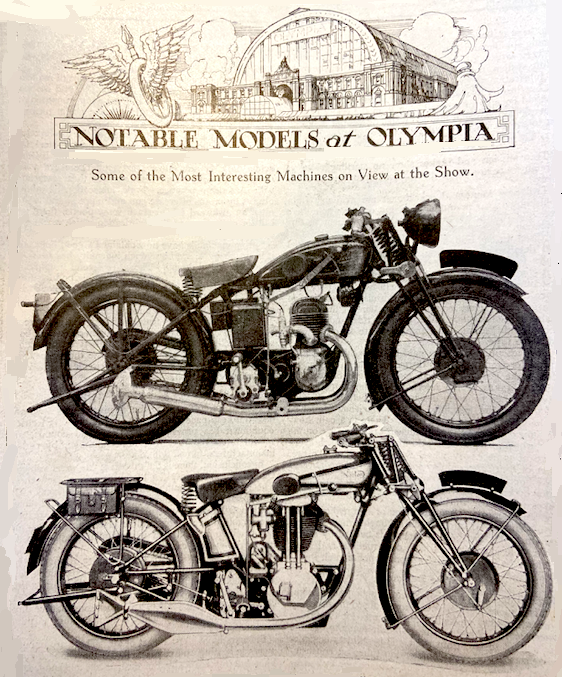
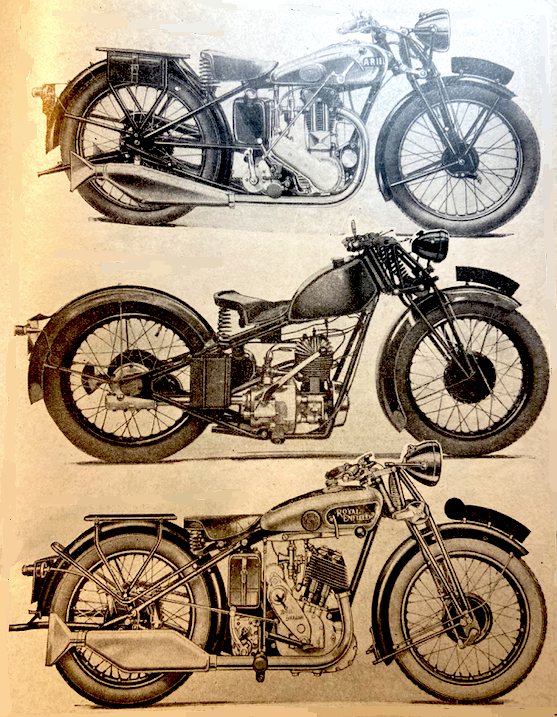
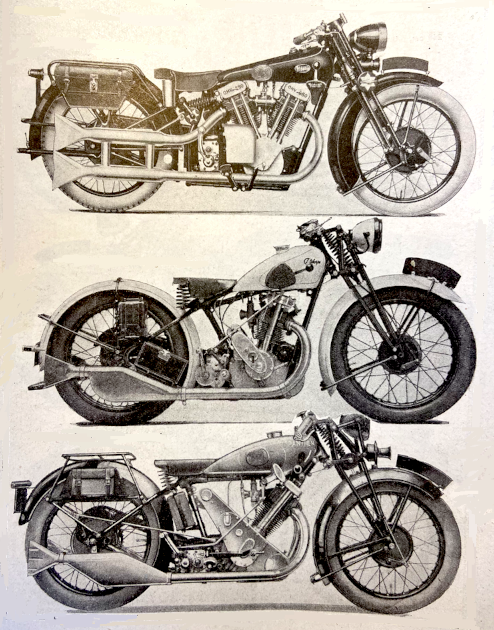
“FOR OVER 1,000 MILES a positive, infinitely variable gear has been giving satisfactory service in the hands of The Motor Cycle staff. The gear in question is the PIV…it is a simple yet most ingenious form of primary drive, consisting of two expanding pulleys, with grooved faces, between which runs a special type of chain…A 349cc side-valve BSA was used for the test…no alteration had to be made to the standard BSA footrest position. In a production form the gear, it is claimed, can be made between one-half and two-thirds of its present width…any ratio between 5 3/4 to 1 and 10⅞ to 1 was obtainable…the gear was most fascinating to use. To change either up or down it is merely necessary to rock the control pedal, the clutch being only used for getting away from a standstill and when the rider wishes to stop with the engine running…the machine was able to maintain an excellent average speed, just by the rider rocking one pedal and operating the throttle…It seems definitely proved, therefore, that the PIV principle can be applied satisfactorily to motor cycle constructions.”
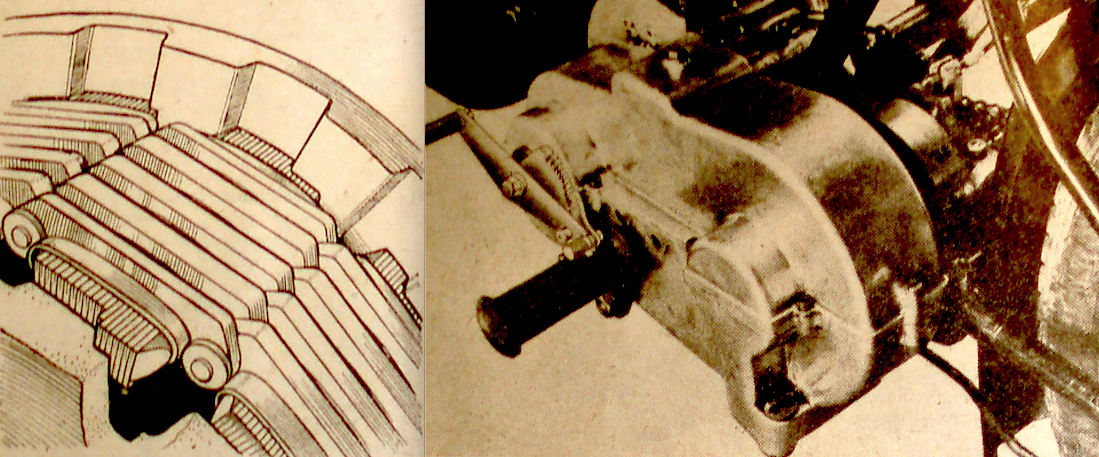


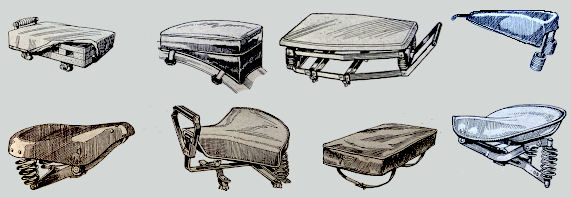



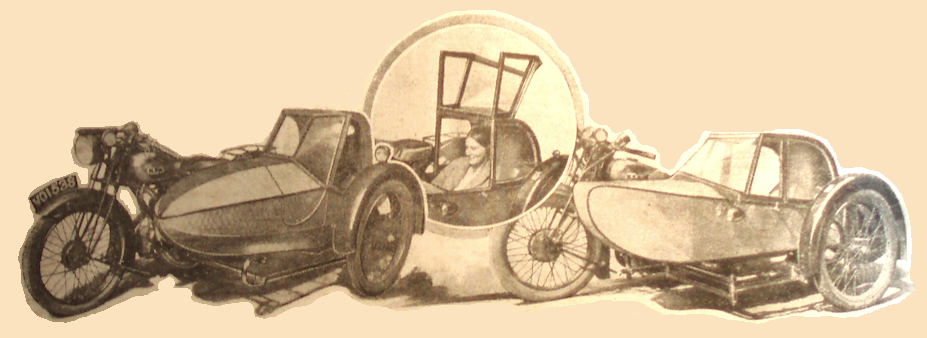
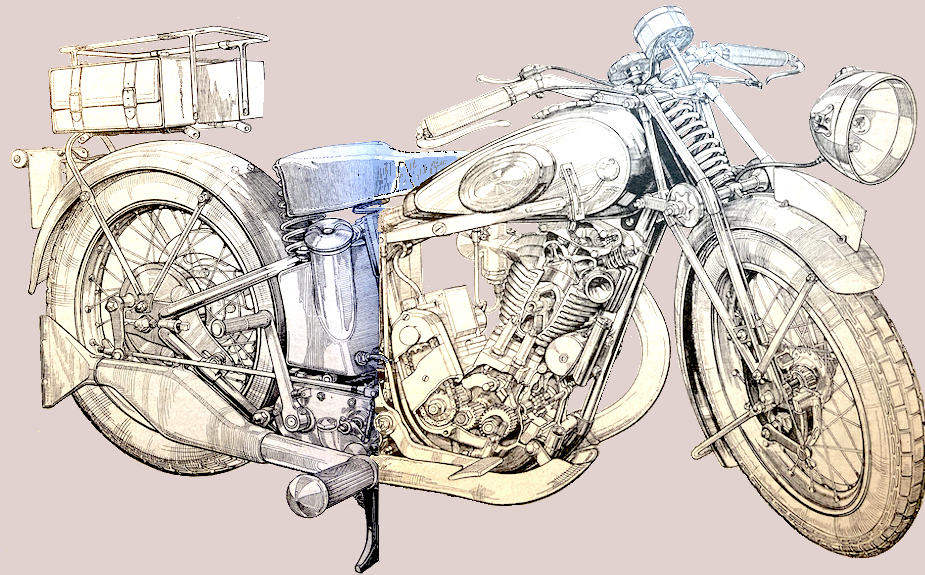
“FRENCH DESIGN FOR OLYMPIA. One of the most interesting models among the array of half-litre single-cylinder machines that will be seen at Olympia this year will be the French 500cc Alcyon. This machine embodies unit construction of engine and gear box, with shaft drive to the rear wheel, and is truly an indication of the extent to which the Continent is advancing in the matter of motor cycle design.”
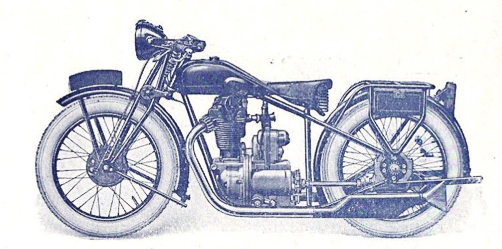
That remark about advances in Continental motor cycle design was timely…
FRENCH DESIGNER GEORGES ROY had a thing about pressed-steel frames. The New Motorcycle he patented in 1926 was not a great success (though some examples did well in long-distance trials) so he went back to the drawing board and came up with the aptly named Majestic. And this time in addition to a pressed-steel frame he fitted hub-centre steering, in line with his dream of a two-wheeled car (many years later Roy revealed that he was inspired by the Ner-a-Car). Shaft drive was an optional extra. As with the New Motorcycle, power came courtesy of Chaise and JAP, with a choice of 350 and 500cc singles, but the Majestic could also be ordered with a JAP twin. Roy sold the rights to Delachanal, the firm behind the Dollar range, and went back to work in the knitting industry. But Dollar went under in 1933 and that was the end of the line for the Majestic. Only about 100 were ever made, mais c’est magnifque!

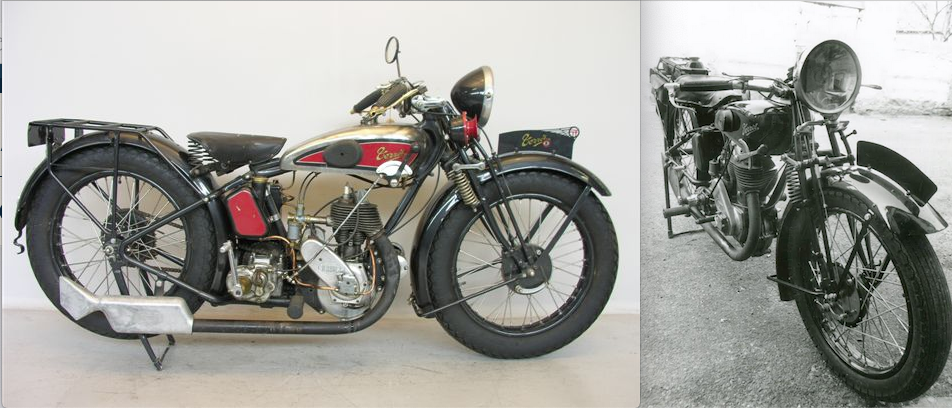
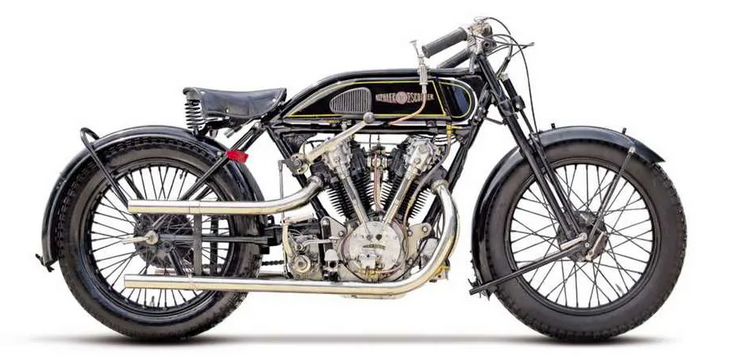
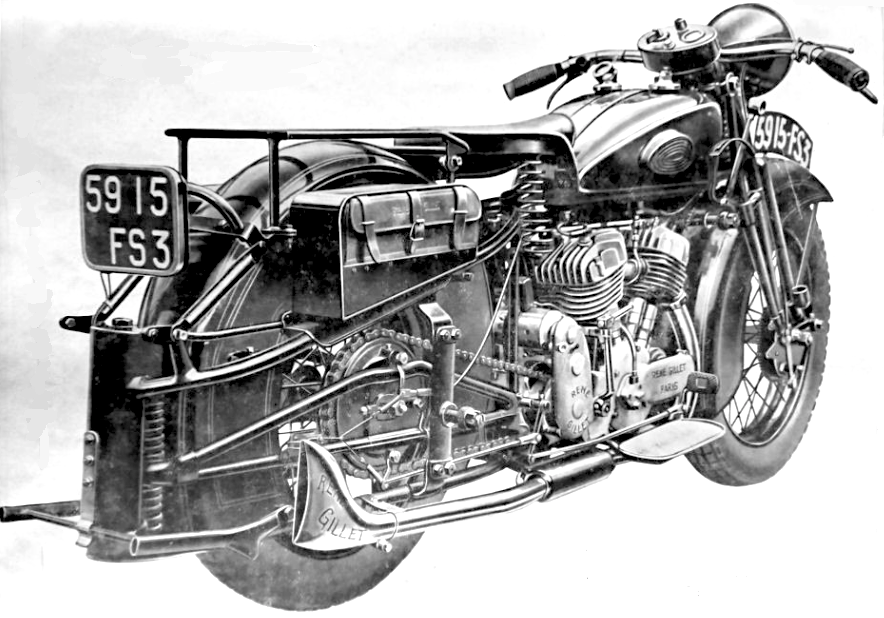
A YEAR AFTER TRIUMPH founder Siegfried Bettmann set up his motor cycle factory in Coventry (1902, as I hope you knew) he set up another, in his home town of Nurnberg producing almost identical bikes (though after 1913 the German factory began production of two-stroke 250s). So why is this relevant to1929? Because things were getting a little tense in Germany. The Wall Street crash wrecked the German economy and a jolly soul named Heinrich Himmler became chief of the SS. It was time for the German Triumph to go it alone. Bikes were exported under the Orial banner but there was a defunct French marque by that name so the German Triumph became Triumph Werke Nürnberg (TWN). Instead of Coventry-made parts TWN bought in MAG engines from Motosacoche (MAG stood for Motosacoche Acacias Genéve). With production topping 13,500 TWN ranked third among German manufacturers after DKW and Zündapp.

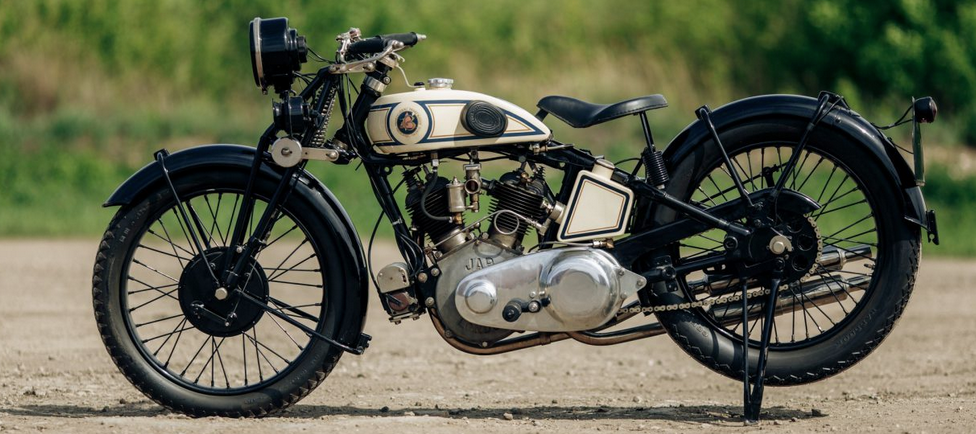

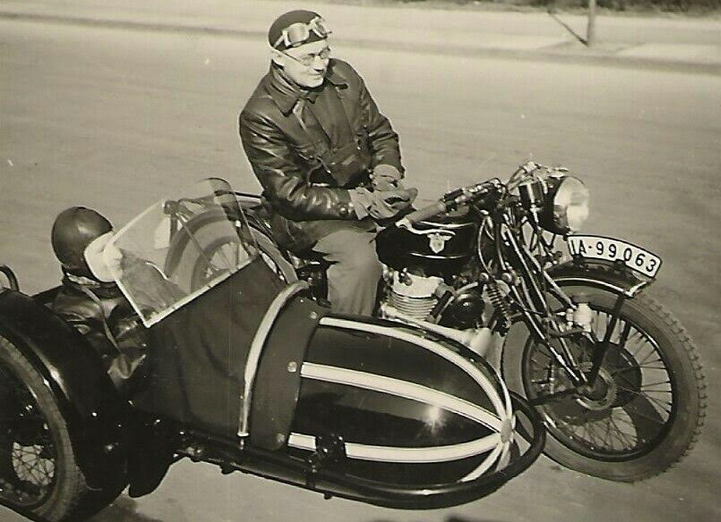
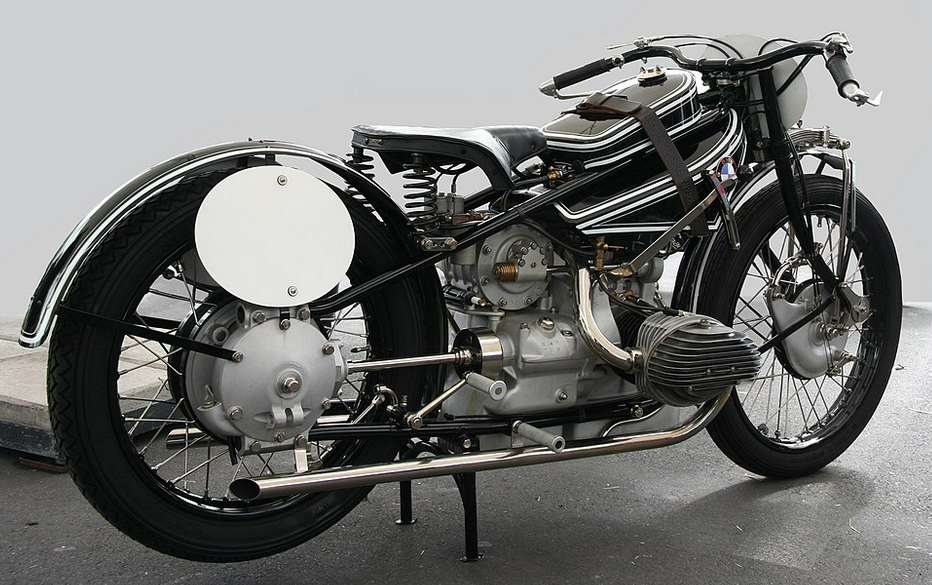
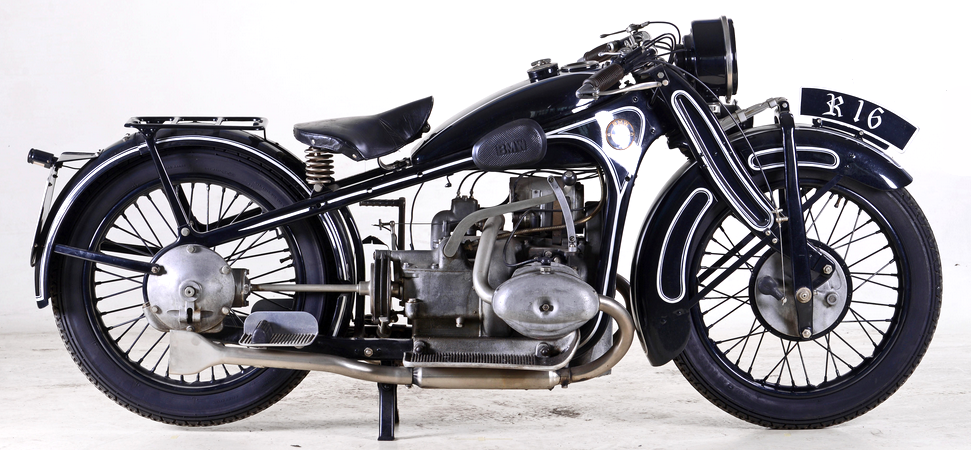
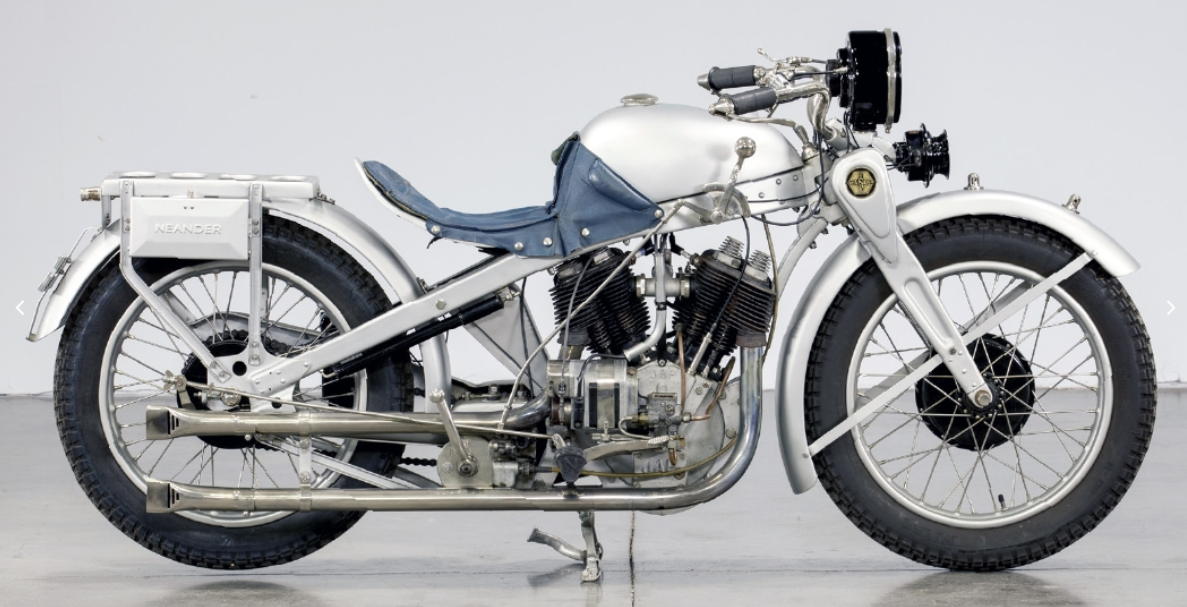
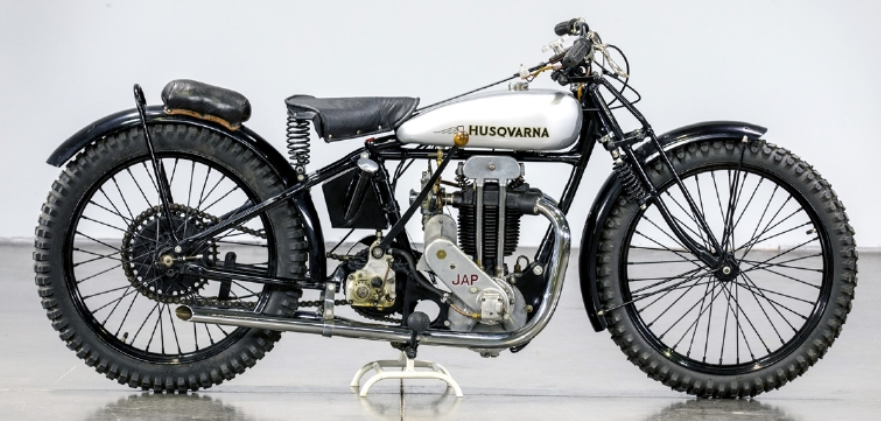

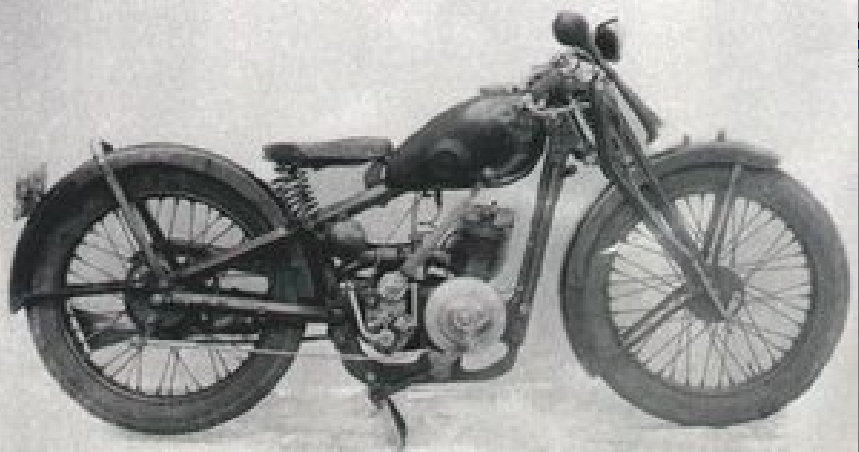
IXION took a stroll round Olympia; here, for your reading pleasure, is an excerpt from his report. “Value is the keynote of the OK series, and has been demonstrated in many a tight race as definitely as it is proclaimed in the catalogues. The Panther bares its teeth in a feline grin of derision, noting how many of its rivals are coming round to the inclined engine which it has always preached; but they cannot get their weight as far forward as the big cat, because it holds the patents for mounting the engine as part of the front down tube. Quality, workmanship and performance is its slogan, and the year-to-year changes seldom amount to more than varying details of a design that was always right. Enfield machines have been brought bang up to date, regardless of factory expenses, and they display one of the neatest dry-sump oiling systems in the Show. As its record since the old quadricycle days implies, this firm possesses that indefinable quality we call ‘class’. Take over a brand new machine from these works, and you will find, for example, that mechanical noise is at a minimum, and that every control moves properly, neither tight nor resistant. Little things, but they testify to quality. The Rudge has had a magnificent year, and deservedly draws vast crowds to its stand. Its successes have been so facile and consistent that they can neither be ascribed to that spice of luck which every good bus needs, nor yet to the possession of several super stars as jockeys. It has almost uniformly developed an extra knot or two, coupled with an immunity from breakage which has been the marvel of all beholders. These two facts indicate great brains in the drawing office, and real conscientiousness alike in materials and in machining. For 1930 there will be no resting on laurels. Still more engine power, backed by stiffer transmission, all the old features, not forgetting the four-speed box, which few makers offer; one of the best stands (not the Olympian variety!) in the Show, new lubrication, more durable valve gear, quieter all-round running…this is indeed a great exhibit, and will cause the heart of the foreign designer to feel like melted wax within him. The big Scotts evince interesting detail alterations, and many will welcome the Olympia début of the ‘half-Scott’ which did so well in the International Six Days when it was scarcely weaned. Sunbeams have shared the principal honours of I929 with Rudge, and the directors evidently consider that a few inside alterations will keep them at the top in 1930, too. As a matter of fact, it is not racing success which has made the ‘Beam a household word wherever motor cyclists forgather—numerous and distinguished as its racing victories have been. It has long ranked as the Bentley of the two-wheeled world; not so large and expensive as the Rolls-Royce Brough, but just big enough to give all the speed which skilled youth can ordinarily use, and priced to add quality to its speed proclivities. I know many men who ‘potter’ on Sunbeams ‘because they never give any bother’; and other men who buy them because ‘you can get such fine prices for them second-hand’. These two testimonials are independent of racing, and fine tributes to merit. The ’90’ represents every youngster’s dream unless he chances to prefer [Rudge ace] Graham Walker to [Sunbeam ace Charlie] Dodson.”
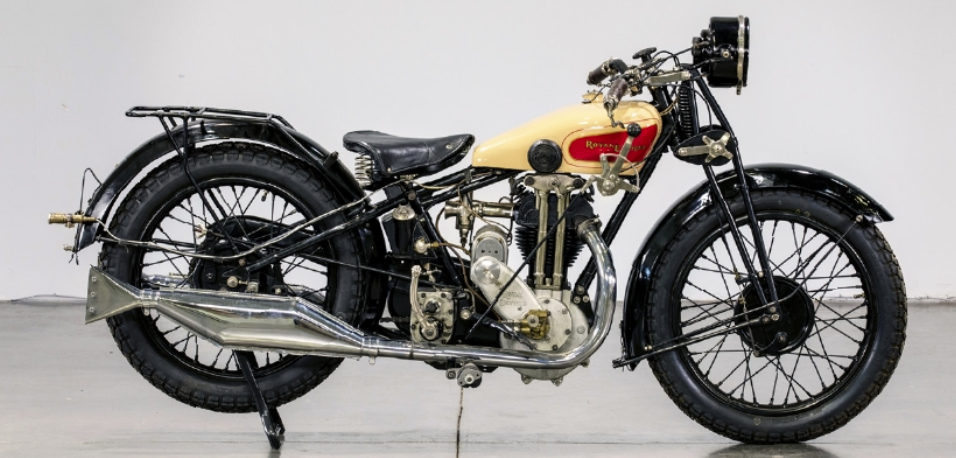
…TALKING OF GRAHAM WALKER, he also featured in the Blue ‘Un’s show issue under the heading ‘What the TT Means to Me’. Here’s an excerpt: “It is practically impossible to get across in print how I really feel about it, as the sentimental attraction of the TT is to me tremendous. As a small boy of twelve I first took an interest in motor cycles and had my first ride on one. The next year—at the tender age of thirteen—I owned my first machine (strictly illegal, but even magistrates break the law!). Coincident with this event, my interest in the TT arrived. I knew the Christian names of all the riders, the details of their machines, even their private hobbies. I was a walking vade-mecum [handbook] of TT information, and the riders were my gods. Although I had never seen it, I could recite the names of all the corners on the course, and imagined that I knew it by heart. Thus, at a most impressionable age, I had TT fever of the most virulent kind. Then came the War. I was a despatch rider, was eventually fairly badly wounded, and was told I would never ride again. My enthusiasm was still with me, however, and I can recollect going to a fancy dress affair as a TT rider. And any man who could brave the heat of leathers in such circumstances was undoubtedly an enthusiast! In I9I9 I went to Norton Motors, Ltd, and managed, in spite of the pessimistic forecast of the Army doctors, to ride a machine again. I was lucky enough to win one or two hill-climbs, and Nortons picked me as a possible candidate for the first post-War TT. I wonder if you, O gentle reader, can imagine what that meant to me? I had gone into the Army in I914 a boy of eighteen, with all a boy’s ideals and enthusiasms…I had come out of the Army in 1918 a man, with a lot of disillusions, physically crocked and rather embittered. Here was an opportunity to regain one of my boyhood’s enthusiasms and to dispel some of the disillusions. I was taken over to the Island by that father of riders—DR O’Donovan—to see if I was capable of doing the job. Imagine my stage fright, and imagine if you can my sinking heart when taken round a strange road, totally different from my boyhood’s conception of it, the only familiar thing being the names of the corners. When told I must do a qualifying lap in sixty minutes, I felt like packing my bag and fading away to England before I made a fool of myself. Suffice to say that O’Donovan was kindness and understanding personified, and passed me out as OK. Shall I ever forget the feeling of pride? I shall certainly not! And now I believe I am one of the only three still riding who took part in that Senior TT in 1920. I have ridden in every Senior, with the exception of 1924, and in a couple of Sidecar Races and one Junior. I suppose I ought to be blasé or bored, but I am not. Each year I get the same thrill when the Island looms up out of the mist; each year I recapture for a fortnight the feeling of an enthusiastic boy again; each year I think ‘Just one more and I must retire,’ but the fever is in my bones, and I am beginning to dread the time when I must give it up.” Walker kept riding in the TT until 1934 (when he rode Rudges to 3rd place in the Lightweight and 6th place in the Senior); he won the 1931 Lightweight, was runner up in three TTs and 3rd in two. The writing skills demonstrated in this piece were put to good use as editor of the Green ‘Un from 1938-54.
“PATH RACING IN THE LOOSE. For last Saturday’s path-race meeting at the Crystal Palace the mile course was in a worse state than ever, for, in addition to all the usual looseness, rain had, in parts, made the surface even sticky. The racing, however, was full of brightness…after a 500cc three-mile event, in which HL Daniell (490cc Norton) and TF Hall (495cc Matchless) ran away from the rest of the field, for the former to win, the machines were wheeled out for an A-grade three mile sidecar race. As usual, FH Brackpool (495cc Matchless sc) pocketed the race from the start. Soon after, however, Brackpool did a thing which for two years or more has seemed inevitable…he turned his outfit overt. The race, of course, then fell out of his pocket. Restarting immediately, however, he managed to put it back again almost at once. But fate, for once, was against him. At an awkward moment his sidecar wheel came off, the outfit turned over a second time, and the race rolled out of his reach, to be snapped up by LT Truett (490cc Norton sc). Next came a match race between Daniell and Tommy Hall…Towards the end of the first lap Hall had a lead of about six yards, but going up to the Maze Daniell got right on his tail…Hall’s machine meantime was snaking and bucketing all round the course…on the atrocious surface…Daniell was handicapped by his glasses having been broken by a stone. On the last lap Daniell was making a supreme effort to take the lead along the stand stretch when he happened to put his Norton over a little too far on a patch of grease and came unstuck; everyone had a splendid view. Daniell picked himself and his machine up, restarted, and came in highly amused at the incident. When congratulating Hall on his fine win, The Motor Cycle man asked him how on earth he managed to hold his machine round that course. HE admitted quite frankly that he really didn’t know what he was doing at times…he also said that he would rather lap Brooklands continuously for an hour and a half than do three laps of the Palace circuit. Hall was actually using an engine which has done over 100mph on Brooklands; the compression ratio was 10 to 1, and it was, of course, running on dope.”
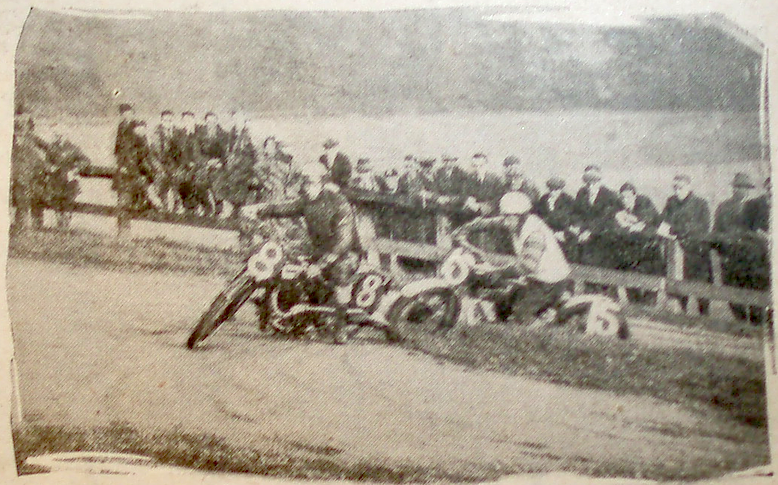
“DURING 1928 THERE WERE 31,778,203 motor vehicles registered throughout the world, of which America licensed 24,493,124 and Great Britain 1,318,169.”
FUEL AND FOXTROTS. A service station at Askers, Dorset, clears its floors for dancing from 8.30 to midnight every Thursday.”
“ALL MOTOR FUEL used in Hungary must consist of 80% petrol and 20% alcohol.”
“JW ROSSITER TOOK 61hr 22min to cover the 866 miles from Land’s End to John o’ Groats on a Raleigh pedal cycle. And on the last MCC run competitors were scheduled to take 63½ hours!”

“A PRIVATELY OWNED 196cc Villiers-engined James has been ridden with sealed tank from Chester to London; the fuel consumed was 7½ pints—which is equivalent to nearly 200mpg.”
“DENLEY AND HIS SPEEDY AJS have not been allowed to remain in peaceful possession of the famous 500cc hour record for very long…Lacey on his 498cc Grindlay-Peerless-JAP has regained it. He raised Denley’s figure from 104.51mph to 105.25mph.”
MORE THAN 20 Italian marques were turning out advanced, high revving 175s.
A PUNDIT ADVISED: “Sight is the only sense by which good drivers can proceed with safety… deafness therefore should in no way affect the granting of a licence.”
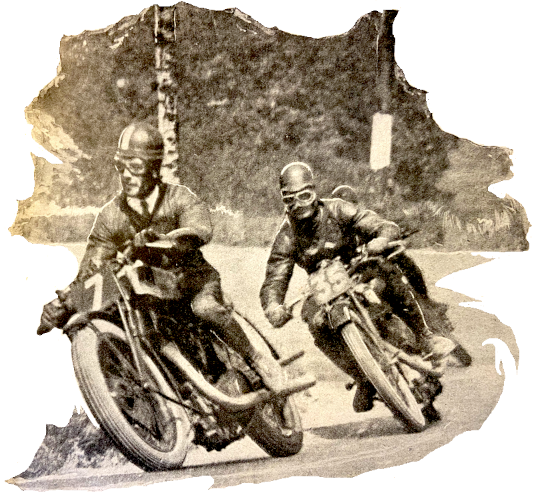
TRIALS VETERAN HARRY BAUGHAN had been making motorcycles in Stroud, Glos since the early twenties, with engines by Blackburne, Sturmey-Archer and JAP. Now he built a trials outfit with a 500cc Blackburne TT engine and patented sidecar-wheel drive which was so good that many clubs banned it from their events (shades of the ‘barred’ 1908 Zenith Gradua).
THE EXPANDING GERMAN INDUSTRY produced 195,686 motorcycles – the Brits managed 164,000. By year’s end there were 731,298 motorcycles on British roads. Numbers would decline after the recesion and wouldn’t be as high again until 1950.
VELOCETTE OFFERED ITS REVOLUTIONARY positive-stop footchange as an option on all models, even its new GTP twostroke. It also offered the KTT to all-comers – the first pukka racing bike offered to the public sincer the pioneer days when there was, in any case, little difference between roadsters and racers.
IF YOU’VE ARRIVED HERE via 1928 you’ll recall that a hero named Jeff Munro lapped Australia on a 500cc Ariel which was literally a near-death experience. A year later and two more Aussies decided to do a lap on a combo. Once again I’m obliged to Peter Whitaker of Old Bike Australasia for this yarn: “Jack Bowers’ motorcycling days began out of sheer necessity, his trusty (read:leaky) BSA delivering him to work before dawn and back well after dark each day. With 1928’s depression starting to bite like a Pit Bull in a Butcher’s, Jack and close mate Frank Smith did the sensible thing of jacking it all in and going for a record ‘lap’ around Australia. For transport they chose a Harley Davidson to which was attached a coffin-like hardwood box, the bottom of which was extended to accommodate an eight-gallon petrol tank from a Model T Ford. We’re guessing they didn’t have a mate brave enough to ask ‘Why?’. The sidecar seat was a circular inflatable cushion, spare tyres were strapped on either end and a pair of two-gallon galvanised-iron water tanks finished the oddity off nicely. Catering was by means of a 12-gauge, a repeating Winchester rifle and a steady hand…it was Independence Day [26 January] when Jack and Frank headed north from Sydney with a grand total of 60 quid in their money belt. The hardships they encountered are legendary. Through ‘blackpella’ country—where skirmishes and spearings were still common—to the far north, at the time so unexplored that the pair were commissioned to map a route from Katherine to Darwin. Food was never an issue with bush turkeys an easy-to-whack favourite.The exorbitant cost of petrol was an academic problem, matched only by actually finding the stuff. The search was harder for water, but the intrepid duo could travel like kings as long as the sun rose every day, the petrol held out, they didn’t die of thirst, they didn’t run across a Kalkadoon War Party and, most of all, they remained mates. Jack Bowers and Frank Smith returned to Sydney in triumph. With the final stamping of their Auto Cycle Union of Australia card at the GPO on September 21 they were not only recognised as the first to fully circumnavigate including the return trip to Darwin) the continent on a motorcycle and sidecar, but set a new record for any motorised vehicle by more than a month. And in Jack’s final words, ‘We also dispelled all doubts about man not being able to live with man for long periods of isolation. We really felt as though we had achieved something.'”
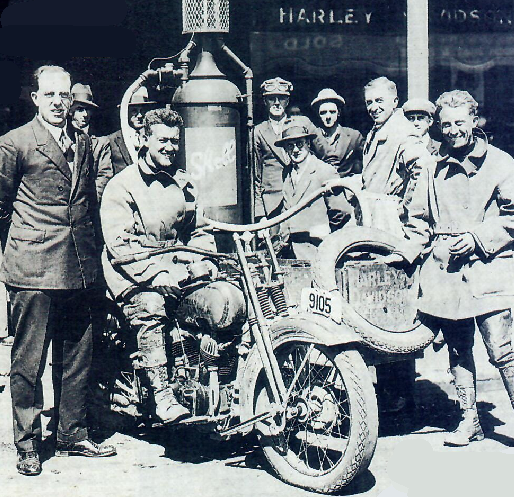
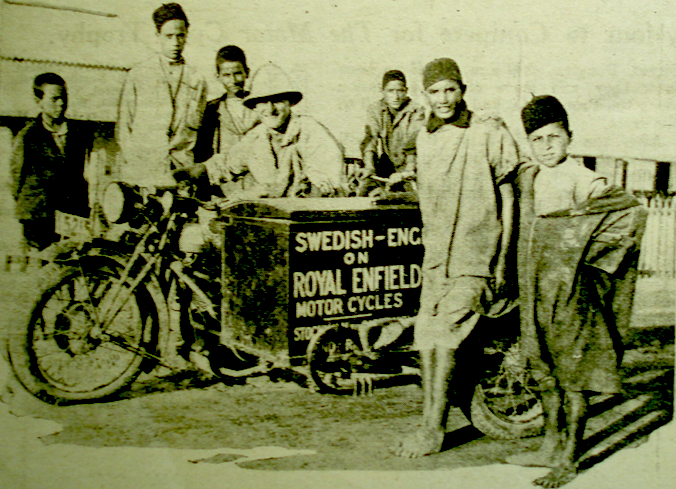

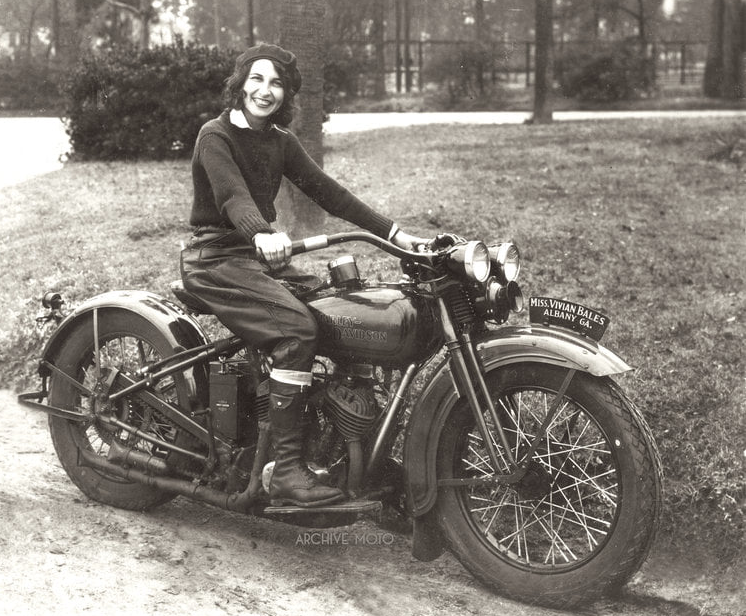
“EIGHTEEN MONTHS HAVE PASSED since dirt-track racing was introduced to this country. Now, at the end of the second season, motor cyclists can look back, not without amusement, at its stormy advent. According to some, speedway racing was to prove a kind of cuckoo in the nest; it would kill all normal forms of motor cycle sport, and it would be so dangerous that every spectator would eschew motor cycling in all its aspects. Others, however, saw it in the birth of a new era of motor cycling. What do we find? Just this, that speedway racing has settled down to its own particular niche and that club life has never been more healthy. So much for the pessimists. And as for the optimists, who can say that the speedways have had any real effect one way or the other? The number of motor cycles registered continues to increase, that much we do know; and we know that it has been increasing for years past…speedway racing seems to have had little effect other than that of providing an exciting spectacle for the general populace…but, to say the least, its general reception has been a mixed one…many of the tracks are too small and too far away from the spectators; a number of them…have a greyhound track between cinders and audience. But so far speedway racing has not been put on a national footing. If this is done by developing the league system a boom may be expected, for among speedway spectators is to be found a keenness quite equal to that displayed by football partisans, who go so far as to follow their team round the country on all its away matches.”
A SEASON AFTER THE initial contingent of Australian stars kickstarted speedway in the UK Geelong Speedway star Colin Stewart arrived and he brought his bike with him (in his cabin). With three years’ experience he was one of the best riders in the business. Having started with a 250cc Cotton-Blackburne Stewart had progressed to a TT Velo, a Norton, a Douglas and a four-valve, twin-carb Indian before settling on a Glanfield Rudge. But he was not just a first-class broadsider: working with engineer Alan Bruce, Stewart was constantly modifying the frame, experimenting with wheel sizes and rear tyre pressures up to 90psi. As well as appearance money Stewart’s contract included the best equipment. Rudge engineers duly examined his extensively modified frame and found it was twisted. In any case didn’t really approve of non-standard bikes. But they couldn’t ignore Stewart’s record and were finally persuaded to build a replica. Before long fellow Aussie Billy Galloway was using one too. Stuart spent three months in hospital recovering from injuries sustained in a crash at West Ham (though he was back the following season as captain of Glasgow White City) and within a couple of years the bespoke Rudge was outclassed by JAP-powered machines. But Colin Stewart deserves his footnote in speedway history for developing the first specialised speedway frame.
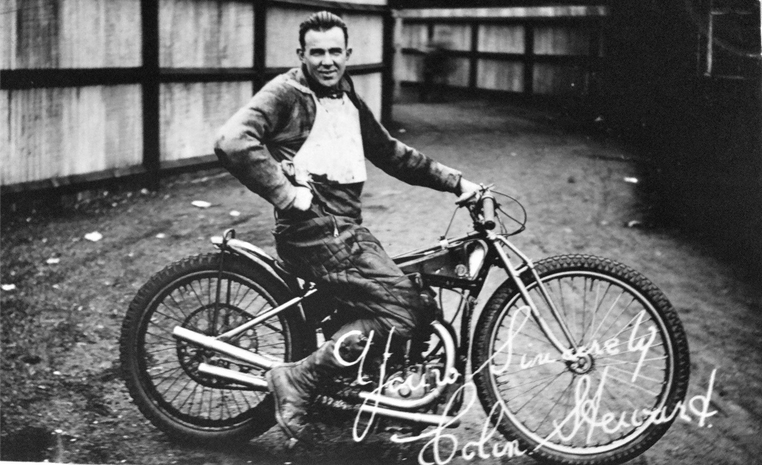
THE AUSSIE INVASION LAUNCHED British speedway but (as Caulkheads on my beloved Isle of Wight have been known to remind cocky overners), “the boat goes both ways’. Witness this antipodean newspaper report: “Riding a 3½ Douglas racer, Miss Fay Taylour, the celebrated Irish lady rider, was successful in wining the A Grade Handicap on Saturday night. She was never in danger of losing any of the events…her time in the semi-final was the fastest recorded for the season. Mis Taylour has ridden several makes of machines, but she prefers the English Douglas for reliability.”
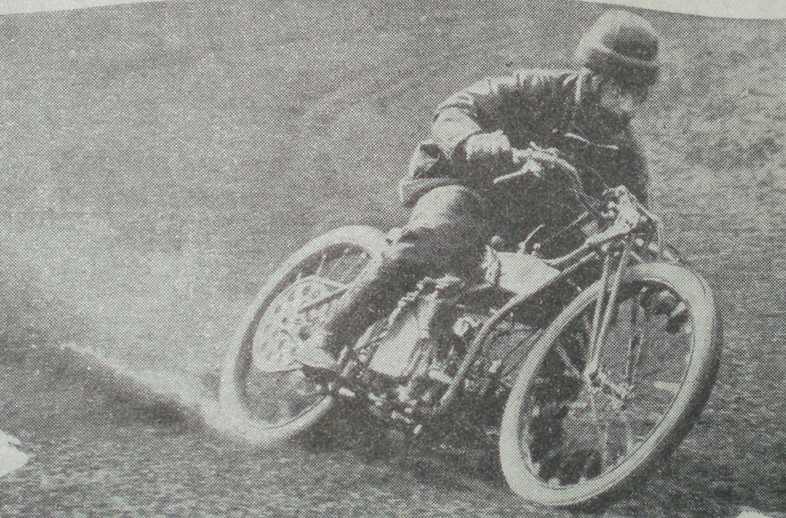
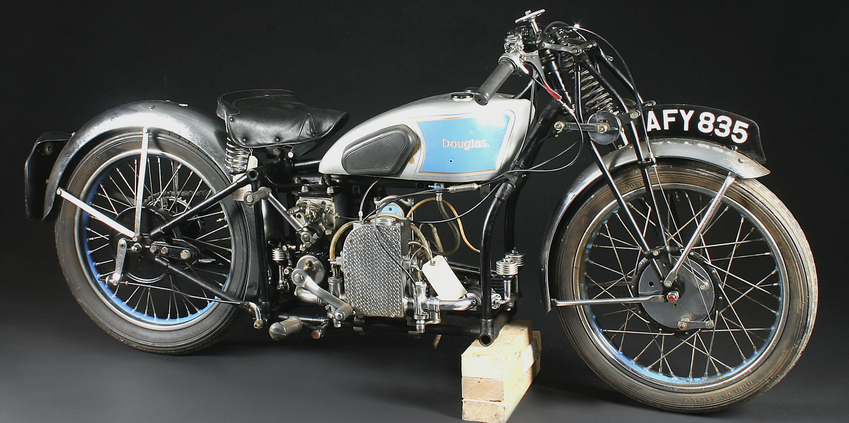
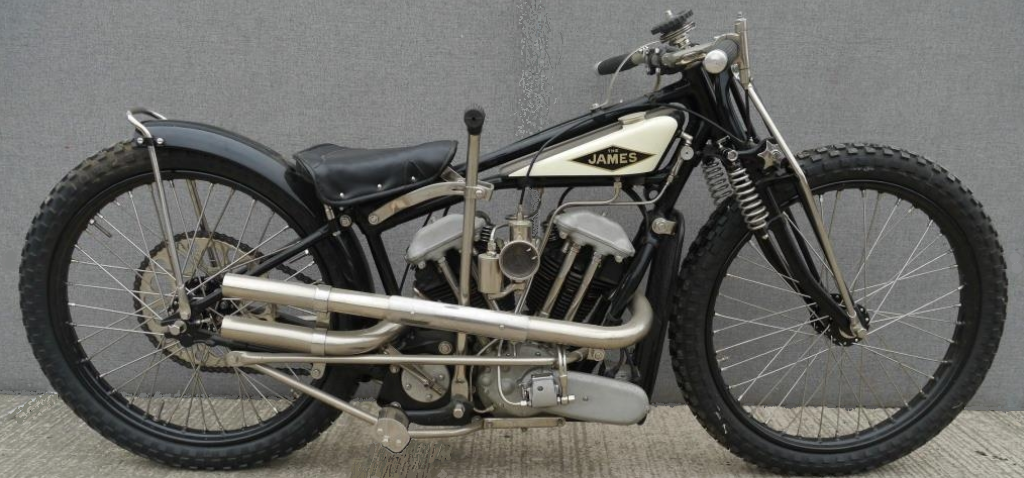
YOU KNOW A SPORT HAS hit the big time when its stars get their own set of cigarette cards…

THE FIRST SPEEDWAY Star Riders’ Championship had separate sections for British and Overseas riders because the organisers believed British riders were not ready to compete with the Americans and Australians. The first British Star Rider was Roger Frogley; Overseas Star Rider was Aussie Frank Arthur, who beat his compatriot Vic Hurley. Within a year the British and Overseas sections were merged into a single championship.
A SPEEDWAY RIDER NAMED Billie Smith fell during the grand parade before a meeting at Wembley and broke her collarbone. The St John Ambulance officers had to cut her leathers away on the track, exposing her breast. Track owner Arthur Elvin felt this was improper and banned female riders from riding at Wembley. He reported the incident to the ACU who made the ban nationwide. Women wouldn’t be allowed back on the shale for nearly 60 years.
“I KEEP NOTICING,” IXION remarked, opprobrious references to saddle tanks in our Correspondence columns. Novices, don’t take any notice of them. They are just disgruntled taunts from the Old Brigade, who, not having found any winners lately, are still riding machines with tanks of the Huntley and Palmer rectangular variety. A good saddle tank in tasteful hues does more to make a bus look decent than any other single item. Incidentally, they are strong mechanically and hold plenty of juice in very workmanlike fashion. They have only one snag, namely, the the weather is apt to shoot along their surface and damp what my old gardener always refers to as his ‘abodum’. And I believe this doesn’t happen except with abodums of the supercharged variety, which young riders out not to possess.”
SADDLE TANKS WEREN’T the only innovation to attract Ixion’s attention: “Of the little things announced as figuring on the 1930 new models, at least three have intrigued me enormously. No 1 is the clean Triumph handlebar, for I never owned an even moderately clean bar since designers dropped using chess bishops on the tank top for throttle, air and ignition. No 2 is the Douglas hand-lever starter. Of course, it mightn’t be such a success on a sulky single, but it gives a far pleasanter action than the frenzied leap demanded by a kick-starter—a leap, too, which has to be made while you are restraining 3cwt from assuming the horizontal, and while you are wearing a heavy suit of overalls. No 3 is also Douglas (and one or two others)—the central stand with removable feet. There is always a mild snag about this last, for the feet will not always be there when they are most wanted, unless we begin to keep our tool bags locked. But I have always resented the job of hoisting 3cwt of metal six inches off the ground when all I wanted was to keep the machine vertical. A clear brain will see at once that a machines wants to kinds of stand, viz, a repair stand (only needed on rare occasions at long intervals) and a prop stand (needed forty times a day). Most makers force us to use a repair stand for prop stand purposes; some No 8 hat at Kingswood has perceived that the normal stand should be of the prop variety.”
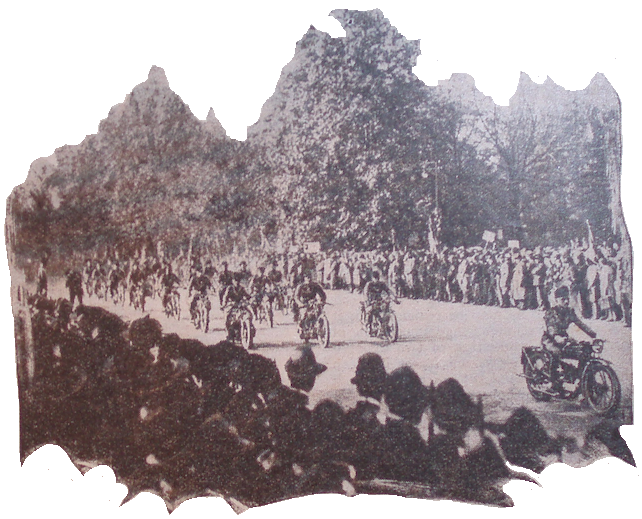
“THE PRESSMAN’S JOB,” ‘TORRENS AVERRED, is to test and test and test. Usually a score or more different motor cycles pass through his hands in a year, and no sooner does one of them become a pal than back it goes to its maker…Once in a way his luck is in, and instead of a mere 500 or 800 miles on a particular mount he covers several thousand in connection with some special test. This has been the case with a 490cc overhead-camshaft Norton that has recently been gracing my garage…it is of a breed that has won its spurs time and again. To mention that mine has covered 3,500 miles and never let me down savours of the obvious, but in this particular case nearly every one of those miles has been a real one. Beggars’ Roost, Cloutsham, Hampton, Yascombe, Meerhay. Fingle Bridge, Simms, Porlock and dozens of other lesser-known hills have been climbed, and hundreds of miles have been over tracks and by-lanes…No motor cycle is perfect—which is just as well for press critics—but very, very few faults can be found with my Norton. It is more than fast enough for use on the road, for even when it was returned to the factory, with 2,500 miles of carbon in the engine, it was capable of an honest to goodness 76mph. And what is equally important, at high speeds one does not have to hang on to the bars like grim death, not even at the speeds of well over 80 which the machine could attain while the engine was free from carbon. For fast cornering I have only met on motor cycle that is better—an actual TT mount. In braking, too, even the most critical could find no fault…Added to these characteristics is an exceptional degree of riding comfort; so for high-average work the Norton is almost in a class of its own…A close-ratio box would make a world of difference…a four-speed box with three close ratios and an emergency bottom one would do the trick, and then—well, I might even consider pensioning of Willing William and buying a camshaft. Some folk maintain that on rough roads an ohc Norton is a bit of a handful. It nay be so if they ride fey, but…at my leisurely gait it is as easy to handle as you could wish. Nor have I any complaints about its behaviour on rough tracks, unless they are covered in deep mud; then one’s work is cut out, but so it is on almost any bus, unless you turn the taps up…No-one expects a super-sports 500 to be ideal as a potterbus, but on the Norton you can trickle along at 20 in top gear…The fuel consumption was not especially good. At an average 40mph it worked out at 65mpg…Mechanically the machine was really quiet, there being very little noise except piston slap, and even that was never obtrusive once the engine had warmed up. All told, the camshaft Norton proved itself an out-and-out thoroughbred that was a joy to ride…One final criticism remains: the cam gear leaked oil.”
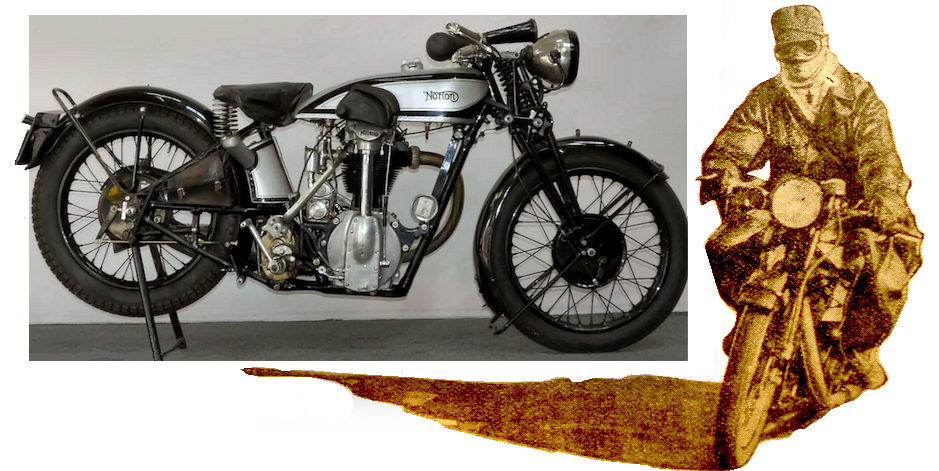
Horses for courses—Torrens’ colleague ‘Colebank’ had been out and about on “a docile touring outfit as a relief from super-sports sidecars”…
“IN THE RECENT PAST it has been my lot to sample one or two different makes of sidecar outfit. These were all of the sporting variety, where the machine itself was capable of a phenomenal number of miles per hour and the sidecar was shaped rather like a cigar. Now this type of outfit is all very well up to a point. It looks well, it will maintain an average speed worthy of the Correspondence columns, and, nowadays, it is extremely reliable. I speak the truth when I say that I enjoyed the temporary ownership of these machines, but it struck me that they do not represent the ideal of quite a number of people. It is not everyone who likes lying down to a forwardly placed handle-bar; the terrific acceleration of a high-efficiency engine does not appeal to every member of the motor cycling community; a cigar does not represent the ideal carriage for every member of the fair sex, especially if a child also is to be carried; the noise from a well-tuned single is not music in the ear of a peace-loving passenger, and it does not improve the temper of a youngster of very tender years any more than it gives delight to a conscientious policeman. There are some moods during which sheer speed, and all that it involves, is willingly sacrificed for other qualities. Speed alone palls after a time; comfort never does. Speed and comfort in a motor cycle represent an ideal combination, and the ideal is rarely, if ever, achieved in anything mechanical. One of the first concerns to recognise the merits of the sidecar was the Enfield Cycle Company, and it applied itself to the production of this class of vehicle. That its efforts have been rewarded is proved by the number of its machines that are on the road. Recently I had to take over an Enfield outfit for a fairly long-distance journey. My demands were, primarily, for something that would be absolutely reliable; secondly, that would offer the maximum of comfort; and thirdly, that would be reasonably quiet in all its departments. At the Enfield works I was shown the machine that was to be placed in my charge. It was the 488cc side-valve model, fully equipped with electric lighting, leg-shields and a touring sidecar with windscreen and side shields. It was just the sort of outfit that gave one the impression that it would go on performing for ever without attention, and throughout the 1,000 miles or so that I drove it this impression was never dispelled. One adjustment only was found to be desirable. and this was the raising of the metering needle in the carburetter to give slightly better power on hills. With this adjustment made, there was but little criticism that could be levelled at the performance, taking into consideration the type of machine. Quite the most noticeable feature was the steering,
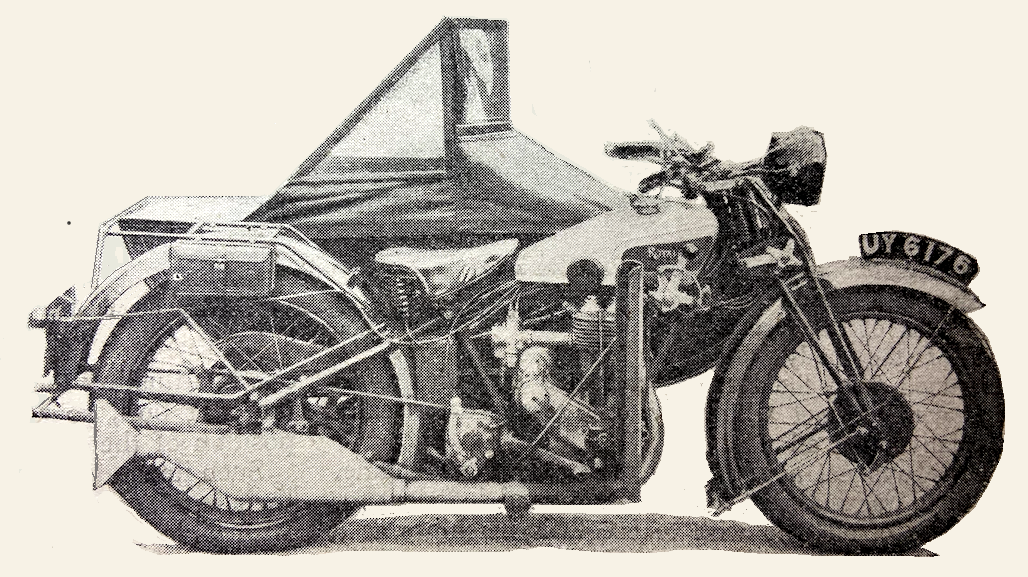
and in this respect it can quite truthfully be stated that no sidecar outfit could have handled with less effort. There was not the least trace of pull to the left; indeed, with the sidecar empty, and running on the crown of the road, the machine was inclined to steer to the right. With the steering damper screwed lightly down the outfit followed a straight course when driven hands off. Fatigue over a long distance was thus reduced to an absolute minimum; at the same time there was no undue tendency for the sidecar wheel to lift on a left-hand bend. We settled down comfortably and covered mile after mile without a falter. Heavy rain and wet roads were but minor terrors, for the legshields provided ample protection for the lower part of the legs, and the sidecar equipment gave full protection to the occupants of the ‘chair’. I say ‘occupants’ for there were two of them, mother and child, and some idea of the roominess of the body can be gained from the fact that repeated enquiries as to their comfort met with only one response—a ready affirmative that all was well. There was not a great deal of speed in the engine, but there was sufficient for our needs, and sufficient for the needs of all who wish to use their machines as a means to an end—with the exception, of course, of the fast, independent solo rider. Starting was ridiculously easy, and the slow tick-over well above the average. The exhaust was silent too, and the brakes all that could be desired from any machine. Two people besides myself who drove this machine remarked on the easy gear change and the lightness of the clutch, and the ease which which the outfit could be whipped round an acute right-hand corner. There are other points about this machine which commend it to the use of the ordinary rider. Accessibility has been studied; the rear wheel is immediately laid bare by undoing two nuts and removing the mudguard and carrier. This is an old feature of Royal Enfield design, but it is well worthy of emphasis. There is an inspection door in the front chain case through which the state of the chain may be examined. Also, when one is adjusting the chains, the brake pedal moves with the gear box, so that there is no need to readjust the position of the pedal stop. Such items, taken separately, may be insignificant, but their sum represents a valuable contribution to the ease with which the machine may be maintained. I thoroughly enjoyed myself with the Enfield, and my passengers were also pleased. It is a machine eminently suited to the person who likes to take his motor cycling quietly. I found it a distinct, and, indeed, a pleasurable, change from the high-speed, sensitive and noisy ‘cigar’-pulling mounts that I had been handling immediately previously.”
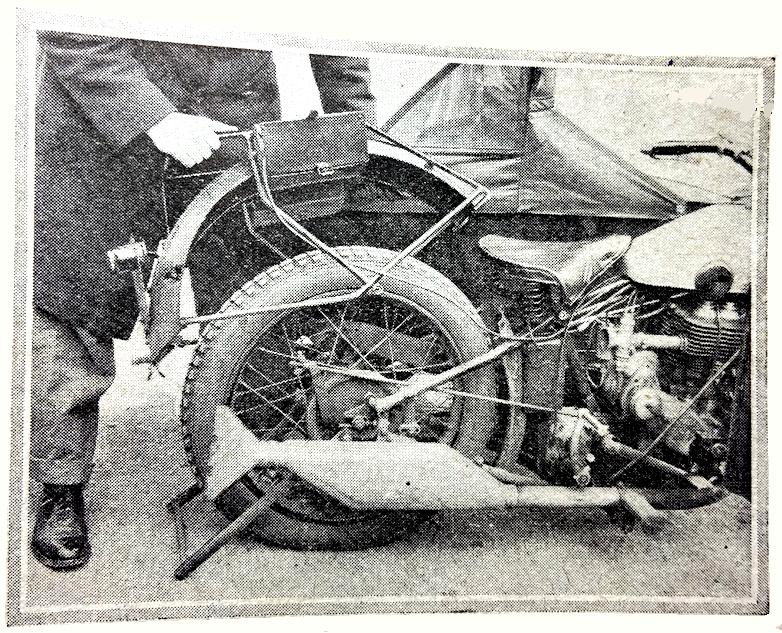
“THE WESSEX SCRAMBLE, which held over the red Hone Hill Artillery Range, near Devizes…was voted, by spectators and competitors alike, an unqualified success…the course consisted of a five-mile circuit of rough grassland, plentifully bestrewn with craters…occasional precipices and wooded dells with intriguing titles…The event was held over five laps…and was open to solo machines of every capacity from 175cc to unlimited…the complete entry of 46 got away to a massed start, and to say the sight (and noise!) was impressive would be putting it very mildly…The Motor Cycle man made his way to the first obstacle—huge basin-like depressions terminating in a stiff 1 in 2 climb for about 30 yards…J Williams (499cc Rudge-Whitworth), riding his bucking and bouncing mount with superb skill, rushed the hill apparently flat out, with his feet glued to the footrests. He certainly deserved the applause of the delighted spectators…then came a bunch of five, led by W Evans (490cc Triumph). Wheelspin spelt the fate of Evans, and he rolled backwards down the hill before the tow rope could be got into working order…WJ Barnes and DJ Barnes, both mounted on Scotts, suffered from too much power and not enough wheel-grip. FE Webb (246cc Excelsior) came into sight holding his complete exhaust pipe in one hand, and to everyone’s amazement he essayed the tricky climb. He did very well to get as far as half-way up before wheelspin claim him as a victim…By this time the spectators were worked up into a fever pit of enthusiasm and when HC Perry (499cc Rudge-Whitworth) appeared with a trickle of flame issuing from the region of his cylinder, their excitement knew no bounds. The inevitable happened, for half way up the gradient the trickle grew with alarming suddenness and before he actually knew what was happening the rider was tumbling backwards down the hill with his blazing machine quickly following on his heels…the machine burnt itself out in spite of the intense application of a battery of extinguishers…HS Perrey (248cc Ariel) arrived, and the way he jockeyed his small machine was worthy of the greatest praise. FE Thacker and B Kershaw, mounted on 248cc Ariels, were also riding with grim ferocity, and there is little doubt that this trio had its mind set on the Team Prize. It was perhaps fortunate for them that E Fernihough (246cc Excelsior) broke his rear chain on the first lap, for he was then leading the 250s, and would have needed some catching. However, it was the luck of the game, and Fernihough himself did not seem to mind. [This is an early appearance of Eric Crudgington Fernihough who, in the 1930s, was to win Grands Prix for Excelsior and set solo and sidecar land speed records on a Bruff-Sup before a fatal crash ended his illustrious career.]…Williams and his Rudge ran home winners in the excellent time, considering the conditions, of 1hr 2min 31sec for the 25 miles…the non-finishers numbered 24, which in itself speaks volumes for the severity of the course…It was decided to give a certificate of merit to all those who finished.”

“I NOTICED A LETTER in your paper…re flat-twin revs. It may interest some people to know that the Douglas DT engine can be made to do 7,000rpm witout difficulty. Indeed, the ‘EW’ type 350cc side-valve has actually done 8,000 on the bench, running on coal-gas. This was in a destruction testy, and the motor maintained those revs for a week non-stop, and was none the worse afterwards! Concerning high speeds, it is a fact that before the BMW did the 134mph, the tuner of OEC-Temple’s machine expressed the opinion that there is no reason why the 600cc ohv Douglas should not attain 150mph. A short time after, a comparitively untuned and unsupercharged 600cc Douglas did 110mph on Southport Sands. So there is hope for us yet.
AL Bashan“
” I WAS INTERESTED TO read in The Motor Cycle how a Brooklands rider was stopped by a wasp on his spark plug. Your contributor jokingly asks, ‘Is this a record?’ I have many a time been held up by locusts.At about midday the locust swarm settles on the ground for a feed and a quiet smoke before resuming its journey, and at such times the whole landscape is thickly carpeted with them. If you try to ride slowly through them they will fly up in such dense masses that all vision will be obscured, and one’s face becomes so bombarded with their hard, heavy bodies that further progress becomes impossible. The best method is to say your prayers in shorthand, open out to 45 or 50mph, and chare through. The locusts rise in solid crowds, it is true, but owing to the speed the insects have time to ride only as far as one’s knees, leaving the face and eyes unmolested. Now, while charging through, the engine is liable to become completely hidden by a vast bank of locusts, and unless the plugs are protected the engine will cut out in the first ten yards, leaving one to divest the plugs of their coating od zizzling corpses, while the startled swarm fairly makes the air boom with the beating of countless wings.
B6773, Kenya Colony.
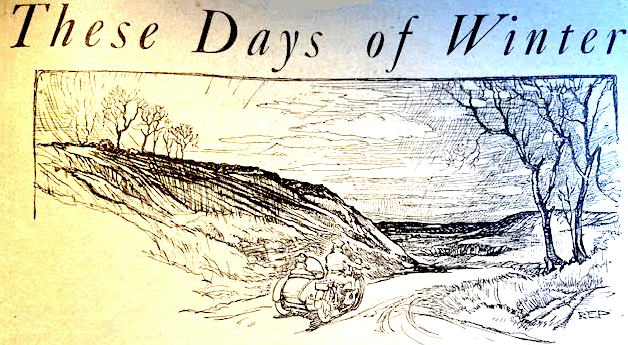
“A Woman Passenger Speaks of their Joys, and Adds some Hints on Clothing. By MARION DAWSON.
BRR! UMPTEEN DEGREES OF FROST on a winter’s night and a fifty-mile run in prospect. No one in his or her right senses—not even a motor cyclist—would contemplate such a trip purely for its own sake. That is the opinion of the fire-worshippers; though some of the same dear folk, with perhaps just a shade of regret that their own inclinations do not take them beyond the hearthrug, prepare a hot meal against the return of the couple of adventurers. As someone more or less famous once remarked, it is the point of view which counts, and a night when all the world is moonlit and the hedgerows and stark trees bedight with sparkling gems can provide an hour or two’s exquisite enjoyment to many who love the open road. Not that the scene is always so well laid, perchance, for crisp moonlight nights are few and far between, and the elements are often served up mixed-grill fashion in our delightfully unstable climate; but in scarcely any mood does the weather deter those whose chief pleasure it is to be abroad with the old bus. Speaking for myself, sidecarring in the winter months has been responsible for many pleasant memories in spite of the attendant slight discomforts of cold toes, and a realisation, as the sidecar has been directed homeward, that my nose reflected the same hue as the setting sun. But if these trifles had carried weight I should not have been aware of some sunsets at all, and certainly never could have visualised the beauty of some of the pictures displayed by Nature at the close of a winter’s afternoon. Sometimes a pastel—a lazy river meandering across the sombre landscape, steely-grey in the pale light, with softer greyish mists rising from the low-lying meadows; or perhaps an etching—a huge shoulder of ploughed earth, intensely black, reaching up to the reddening sky, the trees on the crest sharply silhouetted against the clouds. “You and your sunsets,” jeers my partner, overlooking me—a reprehensible habit which he alleges has become second nature due to our relative positions, his up on the saddle and mine down in the sidecar. His chief concern at dusk is whether the temperamental lighting outfit is functioning, and secondly if, when and where we shall be fortunate enough to get tea; but we are both in agreement that we have obtained as much satisfaction from the sport in winter as in the milder days.
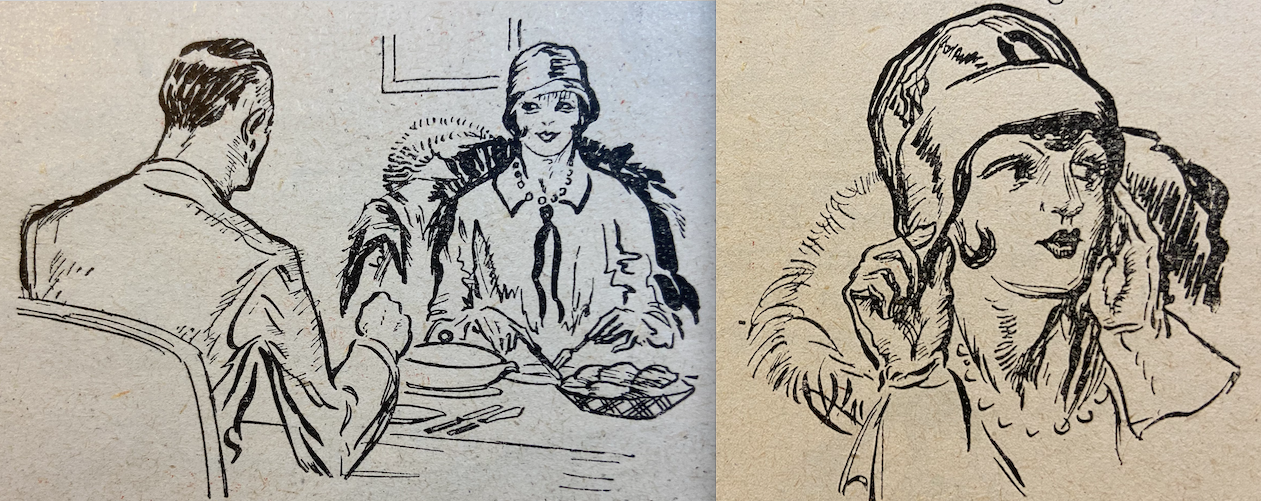
It was in January some years ago that a party of kindred spirits, soloists as well as sidecarrists, ventured into North Wales, and spent an exhilarating week-end endeavouring to climb the wonderful hill which forms the descent into Vortigen’s Valley. This hill is known to-day by a name which aptly describes its winding characteristics. Some made successful climbs unaided, others did not; but the scenery and the fun was worth all our endeavours. The snow was falling when some of us again visited Wales, and that outing is memorable largely on account of a certain alfresco ‘supper’ eaten in coaching days. We had yarned away for hours as we sat under the eaves, as it were, of the huge fireplace, and it was well after midnight when we unanimously decided that another meal would not come amiss; so we raided the kitchen and larders and regaled ourselves with sausages, cold pheasant and cake, eaten picnic-fashion, as the cutlery was locked up for the night. In the morning we looked out on the Snowdonia mountains, white-capped and lovely in the brilliant sunlight. Incidentally, we made our way homeward the following day in a heavy downpour of rain. Another recollection is of a trip late one November. The day was one of slight mishaps and delays, so that we did not reach the object of our journey (a ‘new’ hill discovered by the organiser of the party) until the edge of darkness, when it was too late to try conclusions with it. We were all many miles from home, and as we retraced our steps the mists came down and blotted out the scenery. For hours we carefully crawled over moorland tracks and through narrow lanes, and all heaved a sigh of thankfulness when we reached a little town where we were able to get a meal. Did we enjoy the ham and eggs? We did, likewise the steak and chips which followed; which only goes to prove that one of the greatest blessings bestowed on the motor cyclist is a good appetite. It is only common sense, of course, in the interests of health and pleasure, to aim at keeping warm when passengering in the cold days, and from experience I can say that a good meal before starting goes a long way towards ensuring comfort. Clothing should be plentiful, and the outer garment waterproof; for preference, it should not be leather as it holds the rain, though a leather jacket worn beneath a raincoat is a boon. The top coat should be buttoned up to the neck, and sleeves drawn in at the wrist right at the start; once the skin is chilled it is hard to get warm again. Any small hat which can be pulled well down over the ears is serviceable, but the beret is not so suitable in bad weather as a felt or suede cap. Footwear should be strong and, to ensure warmth, should be easy-fitting. Rubber Wellingtons have much to recommend them, though personally I prefer leather boots, or leather shoes and gaiters, permanently keeping pair of rubber overshoes in the sidecar to slip on if I have to alight on to wet ground or in the snow. It is fatal to get a caking of snow on one’s leather shoes before settling in the sidecar. It is a good plan, too, to carry a small rug or piece of matting on which to rest one’s feet. Some of the non-elect comment on the fact that the sidecarrist is ‘so exposed to the elements’. Well, to many of us that is one of the attractions of the pastime, and, after all, there are sidecars as enclosed and well-equipped as a modern saloon car for those who desire them. The average windscreen, however, plus a side-screen to ward off the persistent draught which is deflected from the driver into the sidecar, is all I could wish for. Tucked away in the locker I keep an ancient waterproof cape, and in a really heavy shower it is admirable protection against the rain getting into the sidecar body, as it can be well spread out over the sides. One last wrinkle. Warmed gloves are very comforting on a bleak day, and I came across this knowledge in a rather curious manner. I was pulling on my gauntlets while my partner settled the bill at a cottage where we had fed when I discovered a small hot roast potato in each glove. Our kindly hostess confessed to having put them there and explained that as a child, when she had to walk three miles to school, she usually carried a warm spud (her word!) inside her gloves in very cold weather. She also added, rather diffidently, that the young gentleman was welcome to a couple if he, too, could manage with them.”
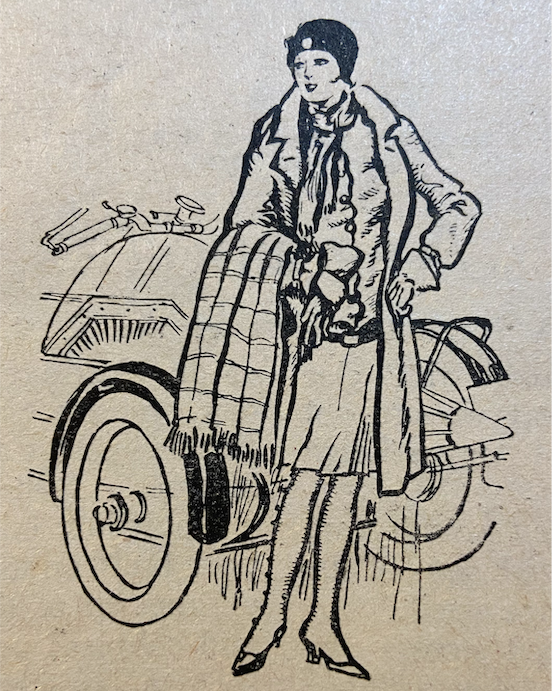
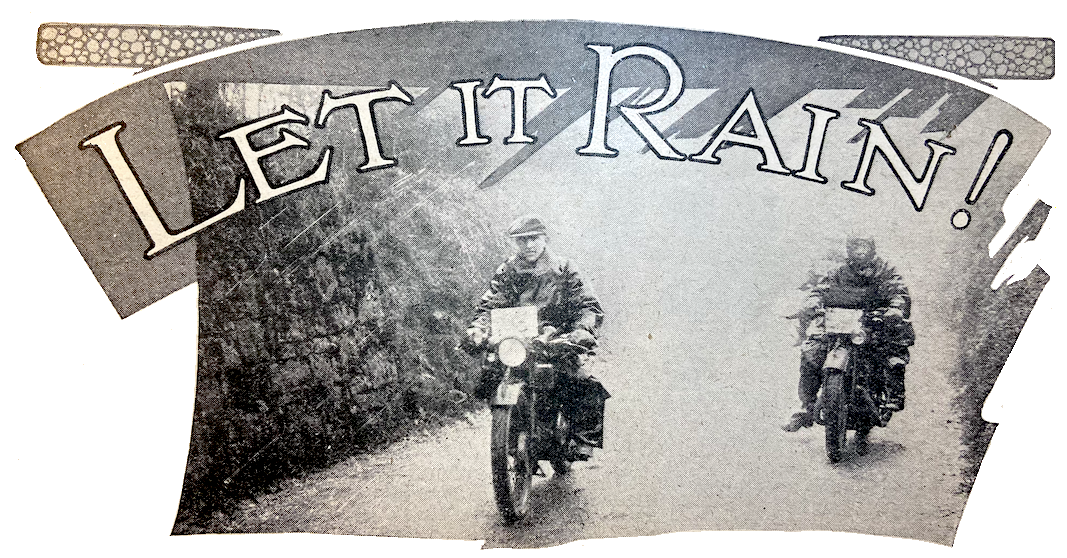
A Few Hints on Keeping Dry and keeping Warm: ‘Deep-sea Fisherman’ Kit the Solution in Really Wet Weather.
By WHARFEDALE.
ALL-WEATHER RIDING demands all-weather kit, and, except for those butterfly souls who only license their machines for the summer quarters, any riding in the British Isles is apt to be all-weather riding. What did Browning say? ‘Oh to swim in England, now that spring is here!’—or at least something like that. Now, if you ask me, there is only one kind of kit for warmth and ‘dryth’ in this country all the year round, and that is what I call ‘competition kit’. And by competition kit I don’t mean the Scott Trial or Rough Riders’ Ramble sort of kit, where one has to sacrifice weatherproofness to agility and a reasonable chance of keeping cool when rough-stuffing. No! I mean the ordinary trial riders’ attire as assumed by the great majority of those knowledgeable fellows who ride in winter trials, all-night runs and six-day events. Practice has made perfect, and they have become as skilful in avoiding discomfort from the elements as they are cunning in getting round rules and regulations. Starting from the feet upwards, I regard full-leg-length waders as the first essential of the all-weather kit. Above the waders a rubber coat (or sleeved-cape is the better word) of the poncho type will keep out the worst kind of rain, especially if there is plenty of scarf round the neck, and on top of all—crowning the noble edifice of man, as it were—an oil-skin sou’wester. This kit is absolutely stormproof; but (shall we say?) it looks it, and many ordinary riders object to looking like deep-sea fishermen. But what would you? Deep-sea fishermen don’t look like deep-sea fishermen because it is necessary to look like that to catch fish. They look like it to keep dry under very wet circumstances, and the same applies to the motor cyclist who insists on keeping dry above all things. Now the kit I have described does not make any special provision for warmth—it is wearable in summer. In winter it is desirable to clothe oneself for warmth before the all-weather garments are assumed. Thus I would strongly recommend whatever sort of ‘undies’, if I may mention the matter, the individual person finds most comforting and heat-retaining, while a good rough tweed suit cannot be beaten for conserving bodily heat by virtue of the peculiar texture of the material. Then I would suggest, for those cold souls who need all the clothing that they can get on, that a woollen pullover, or much better still, one of those woven-but-look-exactly-like-suède golfers’ jackets is most desirable. The last-named garment I think is even better than a leather waistcoat (although I often wear one myself) of the sleeved variety; the only snags with the leather waistcoat are that unless it is warmed and aired before it is put on it feels uncannily and clammily cold at first; and if it does happen to get wet it is still more clammy and takes an unconscionable time to dry again. Scarves? Yes, one must have one big one that can be wound twice round the neck, or two shorter ones in really cold weather. One of my friends, who does a lot of winter riding, always wears a scarf topped by a big turkish towel, which, being very absorbent, arrests all those uncomfortable trickles that sooner or later try to get down the back of one’s neck. It is not a bad idea. Perhaps, at this stage, it will become glaringly evident that I have not mentioned gloves. Actually, in a real continued downpour I prefer to ride without gloves, but if the cold is too intense for the hands then something must be worn; I personally have failed to discover any gloves that are permanently waterproof, but I have heard of some rubber gloves that are on the market, and they are said to be the goods, though inclined to get clammy inside. I have kept hands warm and dry for fair periods in those big, loose-fitting army-type leather mitts which have just the thumb and first finger separately accommodated; a pair of thin woollen gloves inside these provide ample warmth, but I do not like them because they destroy the firmness and sensitiveness of one’s grip on the handlebars. Actually I like ordinary washleather gloves only, but, of course, they have a blotter-like propensity for soaking up water, and apart from breaking the full force of the wind, they are useless in rain. Handlebar muffs are thoroughly to be recommended, although they are scarcely personal kit, being accessories of the machine—like leg-shields, which are another desirable fitting, but one which I do not favour personally as I find that I write-off quite enough footrests per year without adding to the items of a writable-off character. As I said before, my ideal kit is of the deep-sea fisherman type, but for those less boisterous occasions I can and am prepared to recommend an alternative. From the waders I will not depart, however, although I am told that waterproof spring-on gaiters (especially those that incorporate a full golosh to cover the shoes) are very good. I stick to the wader personally because I can wear an ordinary lounge suit, glad socks and light shoes and step right in or out, as the case may be, in a moment, clean and tidy, even if I have had to wallow in pools of mud and water. Thus, I say, I stick to the wader. As an alternative to the poncho, which I must admit I regard as a bit of a curse because it is awkward to pull over the head (especially when one wears glasses) and anyway ruffles the hair abominably, I often wear a trench coat of the oilskin interlined variety. There are lots of these coats on the market, and I can not say that I am absolutely pleased with any of those I have tried. There are various reasons, the chief being that sooner or later they do let in water, especially at the crooks of the arms. I don’t mind that so much, as it is a fault that only arrives with age. But my biggest grouse is that the skirts are seldom full enough in front to remain wrapped round the knees unless pulled taut by rather awkward tabs and buttons. I think the fault is due to the makers endeavouring to produce coats that look ‘smart’, and that can be advertised as such ‘for walking’. It is a mistake. Who wants to ‘walk’ ‘in a great heavy garment that boasts a certain number of inevitable oil stains and the mud splashes cast up by the large cars of the bad rich men, as Wells calls them? These heavy multi-layer trench coats do certainly keep one warm, for they provide lots of thicknesses of material over the chest. They are apt to leave the lower part of the body very unprotected, however (I believe there is only one maker of this type of coat sufficiently practical as a rider to have realised the fact!). I overcame this by cutting down an old pair of trouser-type fawn overalls to about the length of running shorts. These, tucked into the tops of the rubber waders, are a boon on a long, wet journey. It will be observed that this is the only use I have found for something of the almost deceased type of ‘fawn paramatta motor cyclists’ overalls’.
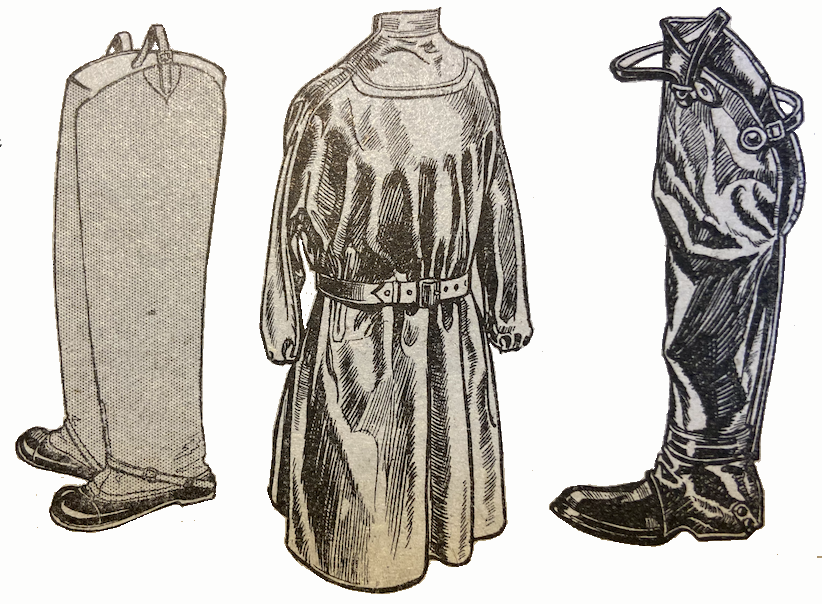
YOU MIGHT RECALL, if you’ve just arrived from 1928, that John Gill and Will Stephens had ridden an HRD-Vincent outfit through Europe, the Middle-East, India and South-East Asia to Australia. They landed in Melbourne where there was a change of passenger. After 12,000 miles on the flapper bracket Will decided to stick around in Australia. So what were the chances of finding a volunteer to drop everything and take off into the wild blue yonder? No worries; this is Australia we’re talking about. What’s more the Aussie who climbed onto the HRD-Vincent’s pillion performed miracles to keep the outfit moving. His name was Phil Irving and he was to have a profound effect on the British motor cycle industry. From Australia they sailed to New Zealand, thence to Vancouver. At this point in the tale I can relax and let Peter Whitaker of Old Bike Australasia take over. My thanks to him for allowing me to crib part of his feature on messrs Gill and Irving’s Canadian adventure; a beer is also owed to Paul Gearside for letting me use his excellent illustration. Peter, over to you: “Arriving in Vancouver they were welcomed by the Shell representative. Arrangements for free fuel and oil were welcomed, though the advice that crossing the Rocky Mountains was impossible in winter was not. After ditching nearly 100kg of weight to bring the outfit down to 400kg, they set off anyway. They faced first-gear, full-lock climbs and descents over sharp, rocky goat tracks. With no reverse gear, three-point turns were somewhat problematical on a 30° slope. Between the mountain passes, the surface alternated between glutinous mud and deep, power sapping sand. Mechanically they fared pretty well, broken sidecar springs were easy to repair and, after the sand, the wheel bearings were fixed by fitting their replacement wheel; along with a new primary drive sprocket and chain. Nights under canvas at temperatures below zero were unpleasant to say the least but an evening at the Moose Jaw Throttle Twisters Club proved most enjoyable. The Canadians were amazed that the single-cylinder JAP engine had handled the task, and after many drinks, a discussion about the merits of British engineering versus USA cubic inches developed into a tug-of-war between the Vincent and a V-twin Harley-Davidson. By virtue of lower gearing and extra weight advantage, the Vincent’s power prevailed; but the contest caused repercussions. Leaving Qu’appelle, Jack and Phil came across an Indian Scout outfit on which the mangled chain had jumped the sprockets, leaving a young beau and his belle distraught. Jack attempted to tow the Indian into town but, under load, the Vincent lost compression and ceased firing completely. ‘Unexpected help arrived in the form of a voluble Italian, with a wife and four kids jammed into a Model T Ford,’ Phil recalled in his autobiography. ”Poppa’ had once owned a
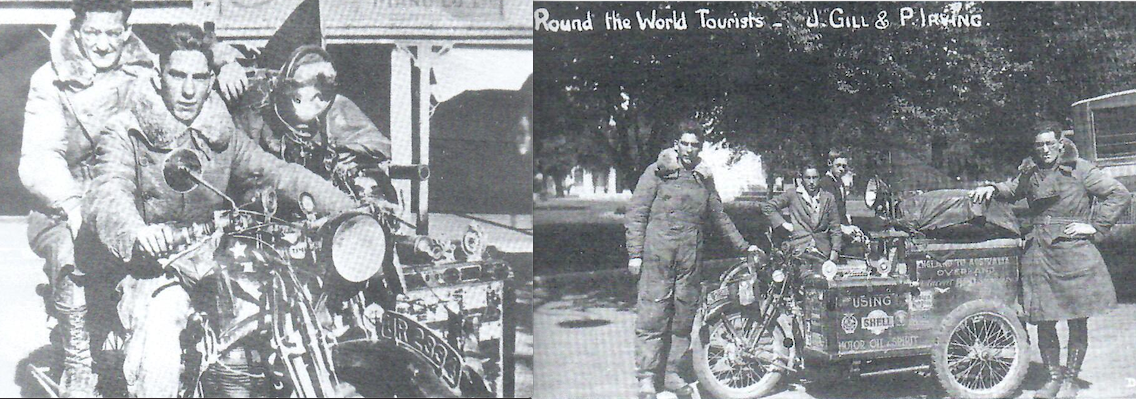
motorcycle and without prompting offered to pull both outfits. The Vincent was hitched to the car, leaving the Indian at the end of the line. In retrospect, what followed would have done full justice to a Keystone comedy, even though it did not seem very hilarious at the time. I stood on the running board of the car with one arm round the door post to lighten the load on the towline, and observe progress. Poppa knew little about towing and started off so suddenly that the ropes tightened with a twang, and then he changed from bottom to top so quickly that there was nearly a double rear-end collision. When the speed got up to around 40mph, he heeded my urgent request to slow down by slamming the hand-throttle shut, creating much confusion; which was not lessened by him immediately opening out again to the accompaniment of shouted imprecations from both riders. Meanwhile, ‘Mamma’ had thrust into my unoccupied hand a bottle of warm beer, which is not my favourite drink even when cold, and I had to go through the motions of imbibing it without losing my precarious foothold or pouring too much down my neck externally. After a couple of miles, progress became a little more orderly until approaching Indian Head, where the road turned sharply and dived under the Canadian Pacific Railway line. It was almost dark by then, and Poppa failed to notice the turn, keeping straight on over a foot-deep drain with the outfits crashing after him until the whole lot stopped and both drivers dismounted and started abusing the good-hearted Italian in no uncertain terms. Wanting to get out of this imbroglio quickly, I cast off the tow lines and, with Gill’s help, shoved our machine under the bridge out of sight. What happened to the Ford and the Indian we never found out, having enough of our own troubles.’ Thanks largely to Irving’s bush engineering skills, they rode into Montreal where, to the awe of the Canadian Automotive Association, they demonstrated their prodigious thirst as they marked out their pioneering 2320-mile route on the map. Jack Gill completed his world
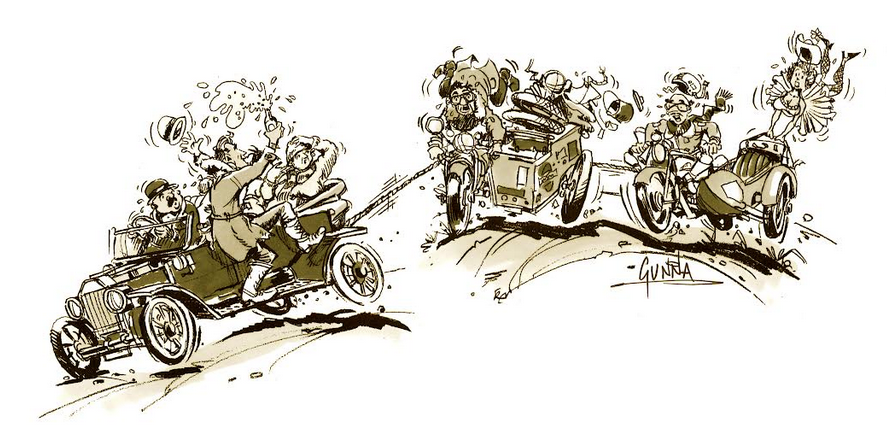
circumnavigation, while for Phil Irving it was his first amazing achievement in a truly remarkable career.”They rolled into Vancouver exhausted and out of funds. Phil Vincent agreed to pay their passage home while Cunard took care of the outfit. The HRD-Vincent had covered 23,000 miles, most of them far from tarmac. The publicity helped the company weather the global recession that followed the Wall Street Crash. Having made it to the old country the hard way Irving went to work for Velocette and later became the engineering genius behind the development of Vincent motorcycles and so much more. [I once met Phil Irving. As a young shaver I spent some glorious years writing for Motor Cycle Weekly, which the suits had decided was a better title than The Motor Cycle. As such I was present at the retirement bash thrown for our incomparable technical editor, Vic Willoughby. Now Vic and Phil Irving were mates and Phil was at the leaving do. I was gazing at two of the cleverest brains in motor cycling who were chatting (I wish I knew what they were talking about but truth be told I probably wouldn’t have understood them) when Vic glanced in my direction and waved me over. Feeling rather proud that Vic thought me worthy to be introduced to the great man I strode over, ready to extend me hand. “Phil,” said Vic, “This is Dave Richmond, he’ll show you where the toiler is.” And I did.]
AND NOW, FOR YOUR delectation, a random selection of 1929 images, most of them courtesy of my ami Francois (who also supplied most of the pics in les deux melanges) with whatever information I have unearthed to go with them.
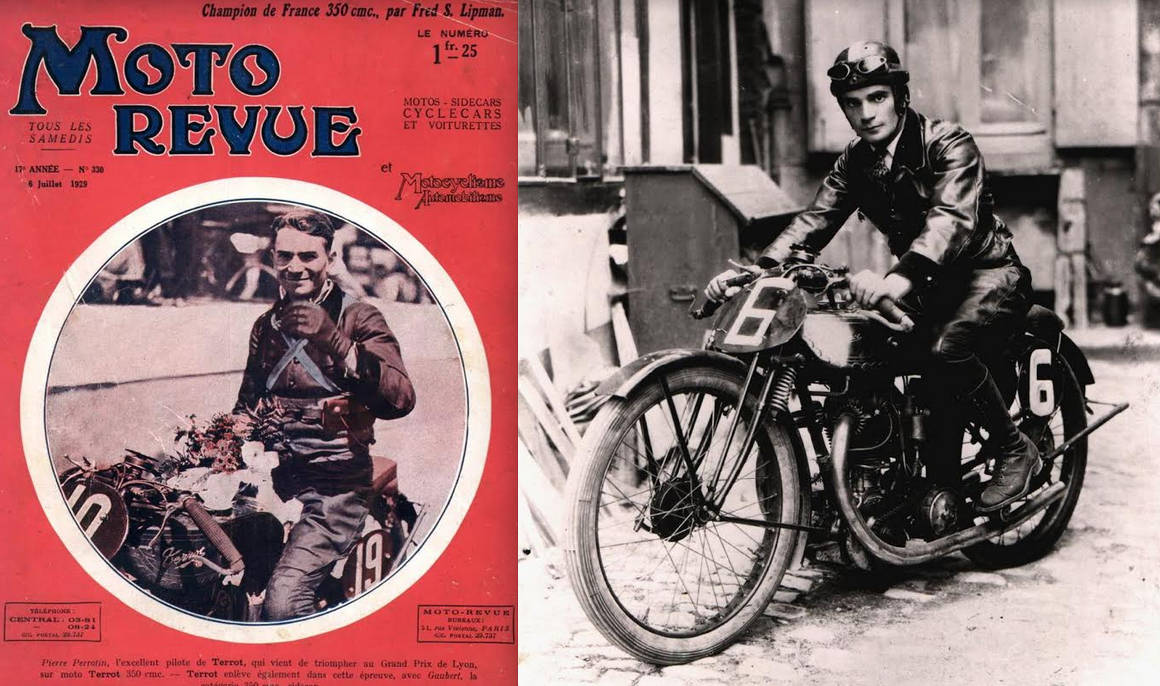
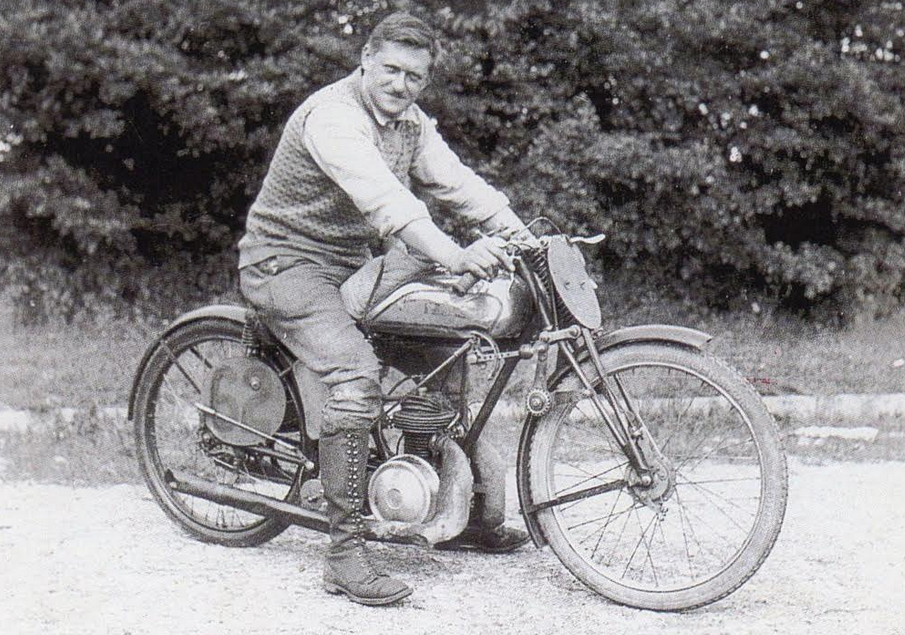
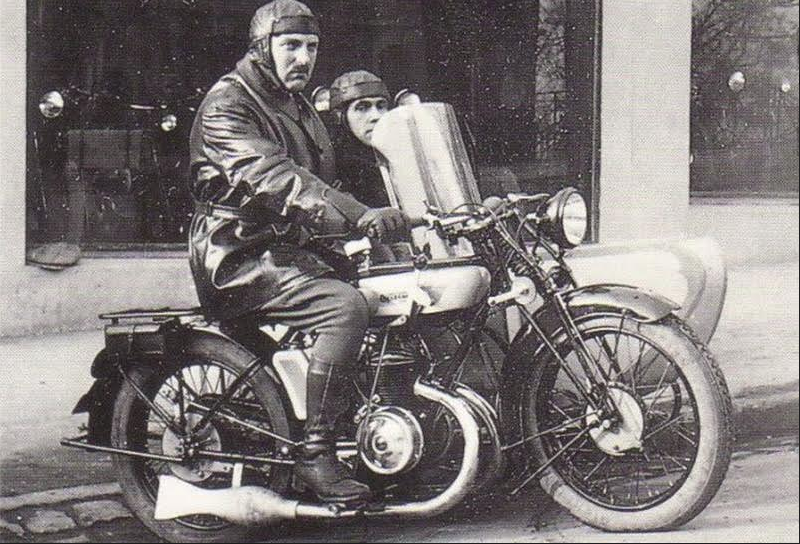
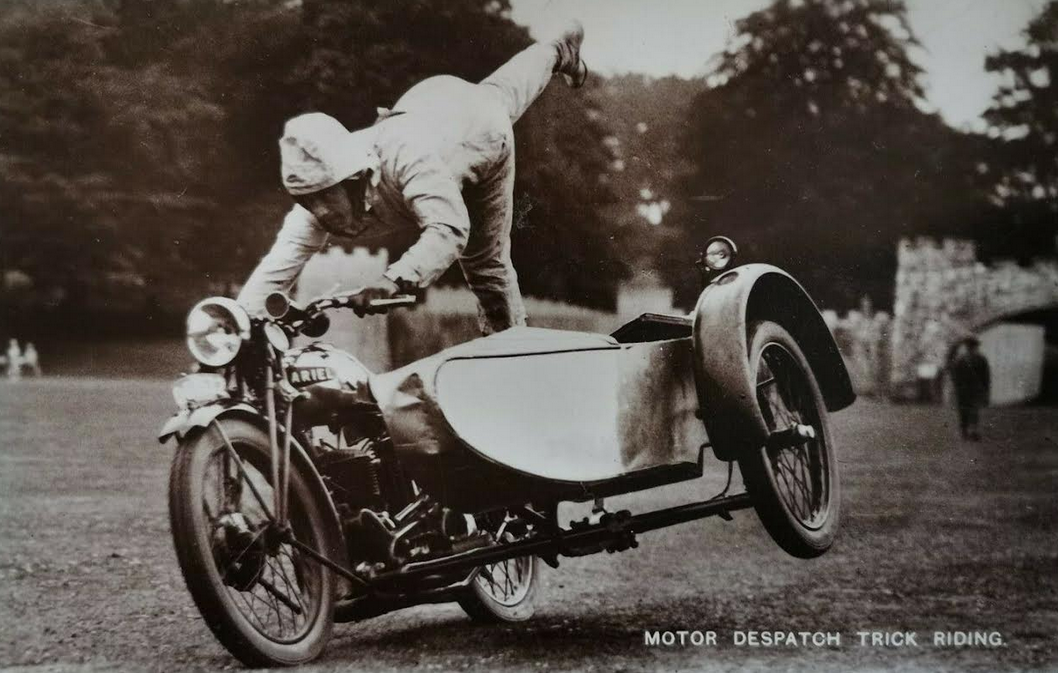
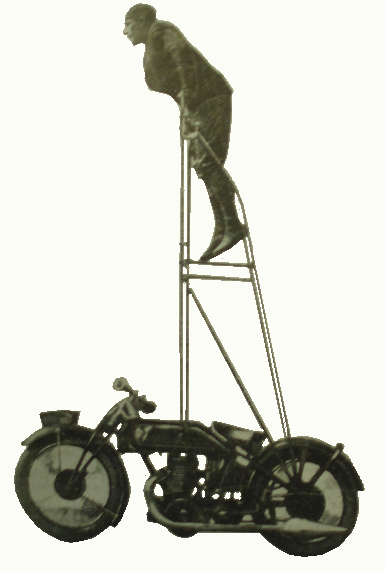
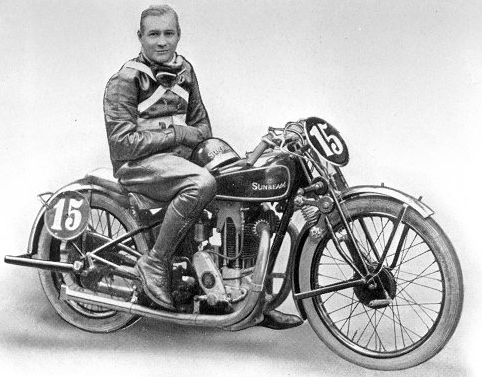
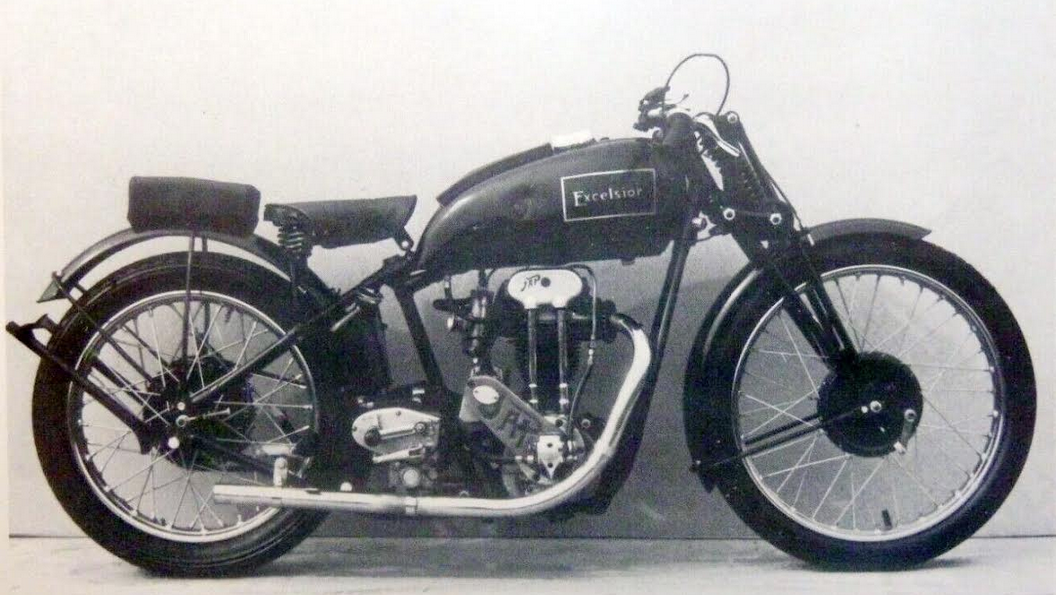
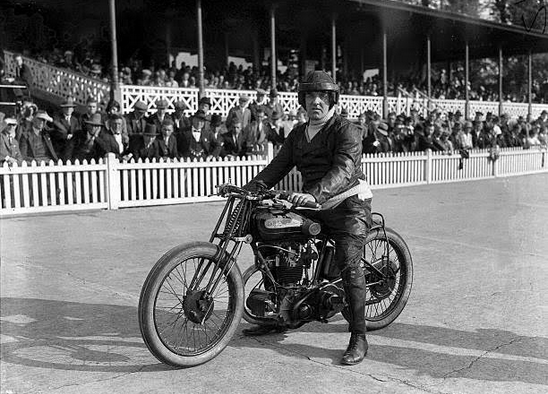
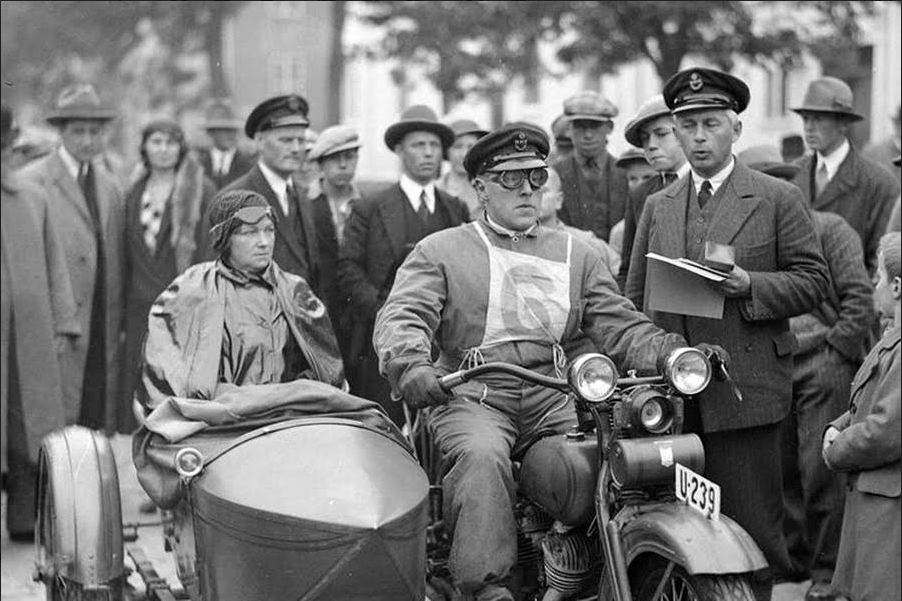
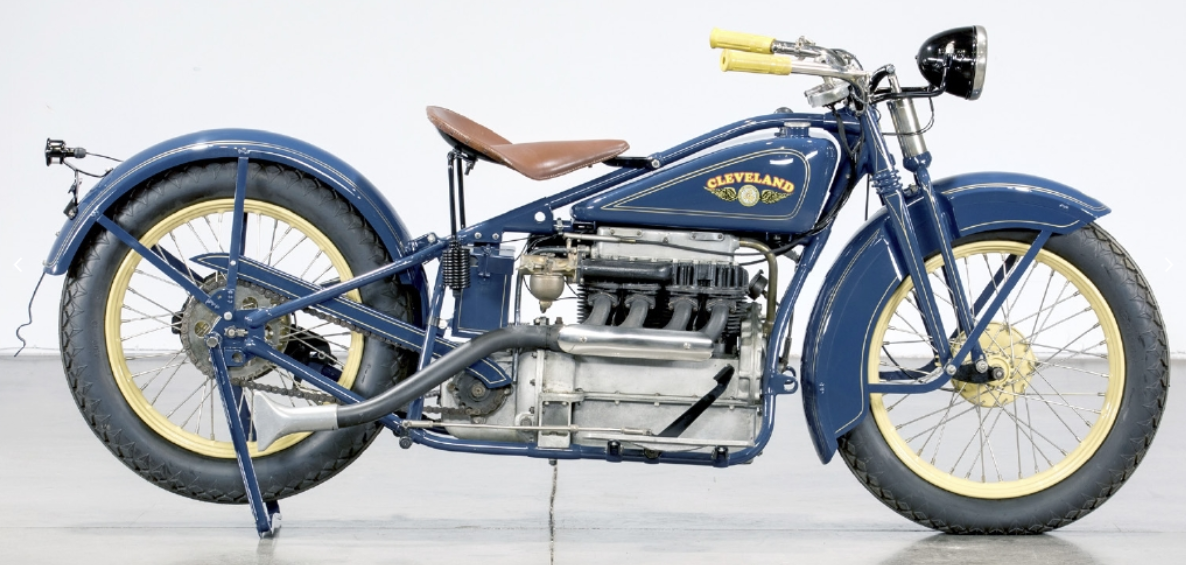
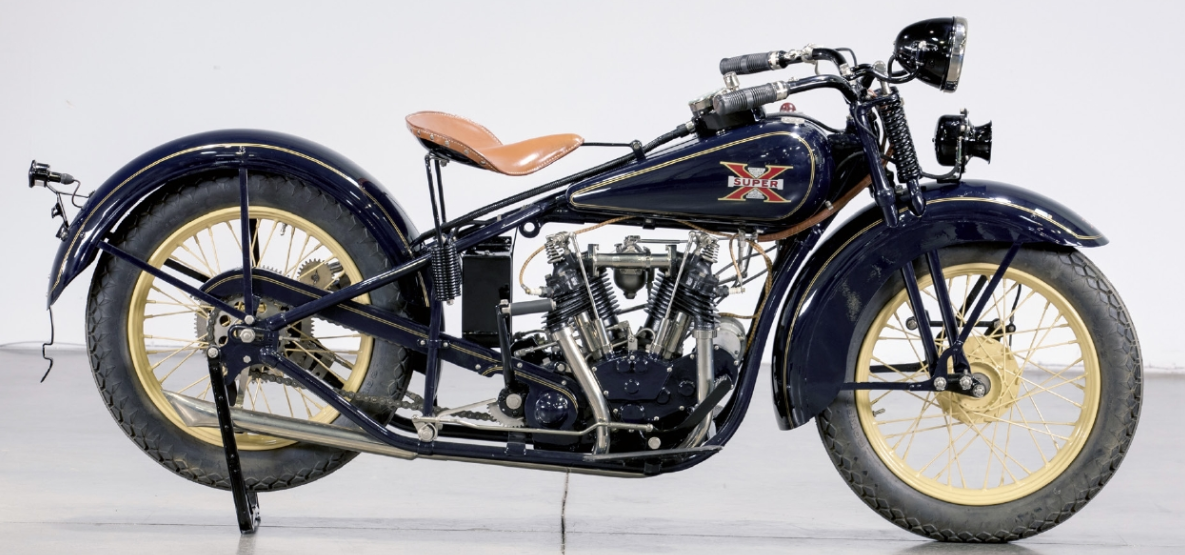
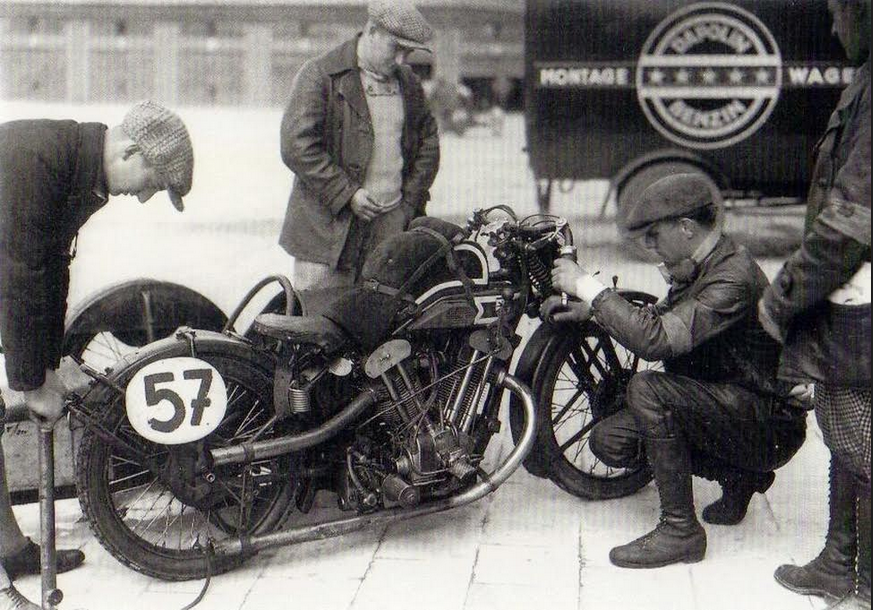
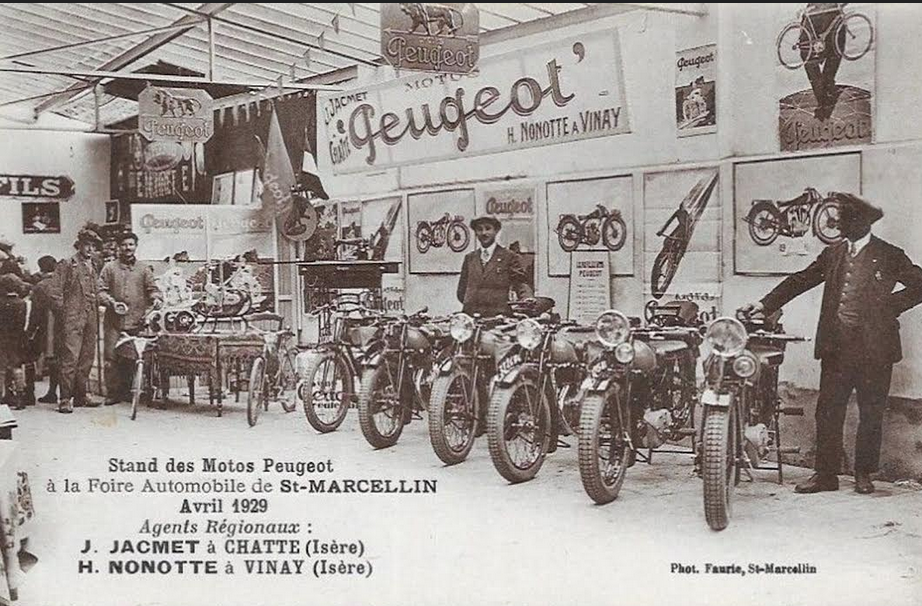
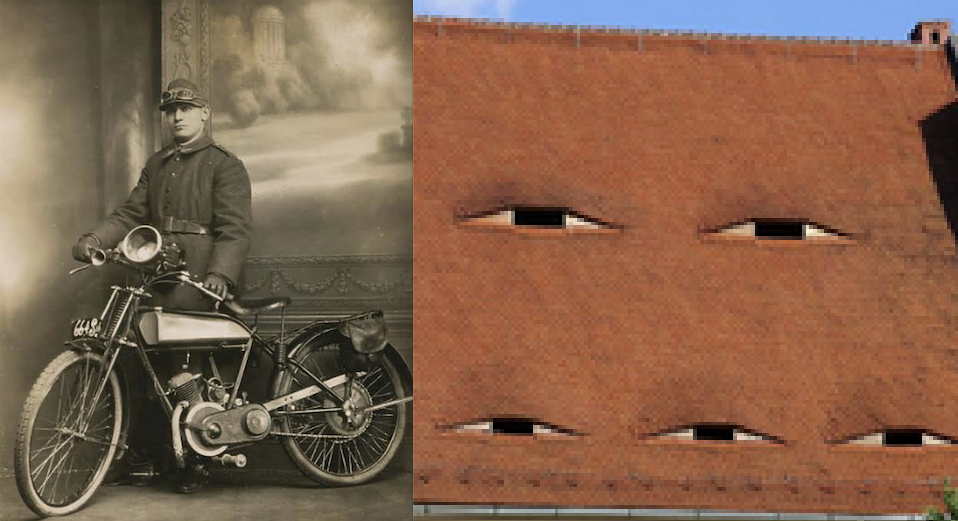
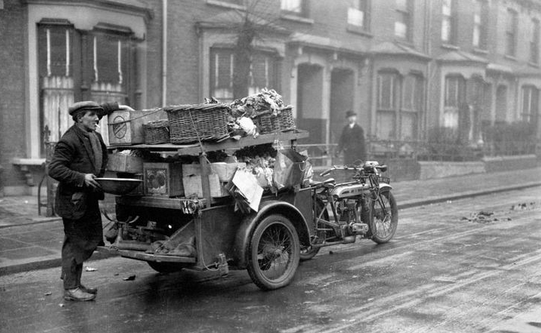
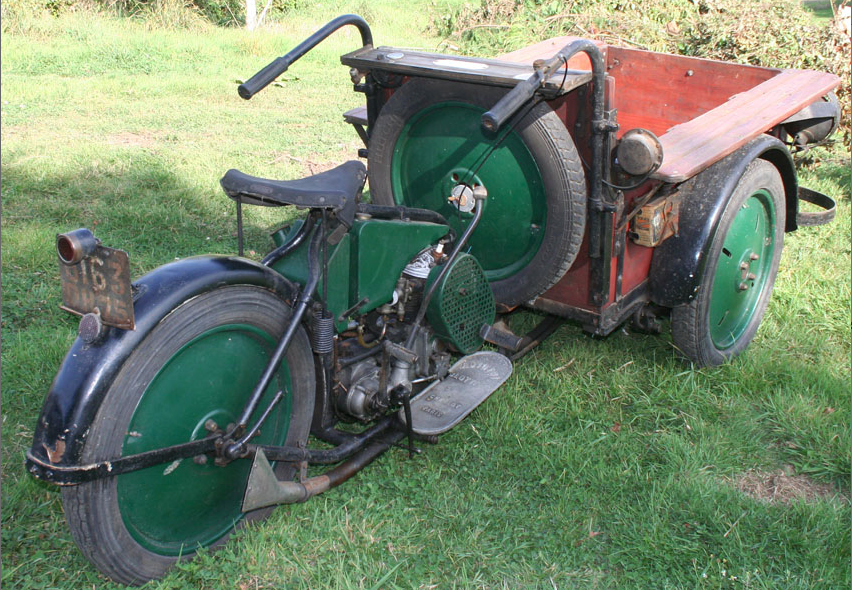
It’s been a busy year. Before we move on to 1930 and the early post-vintage era, you might care to cast your eye over these contemporary adverts.

